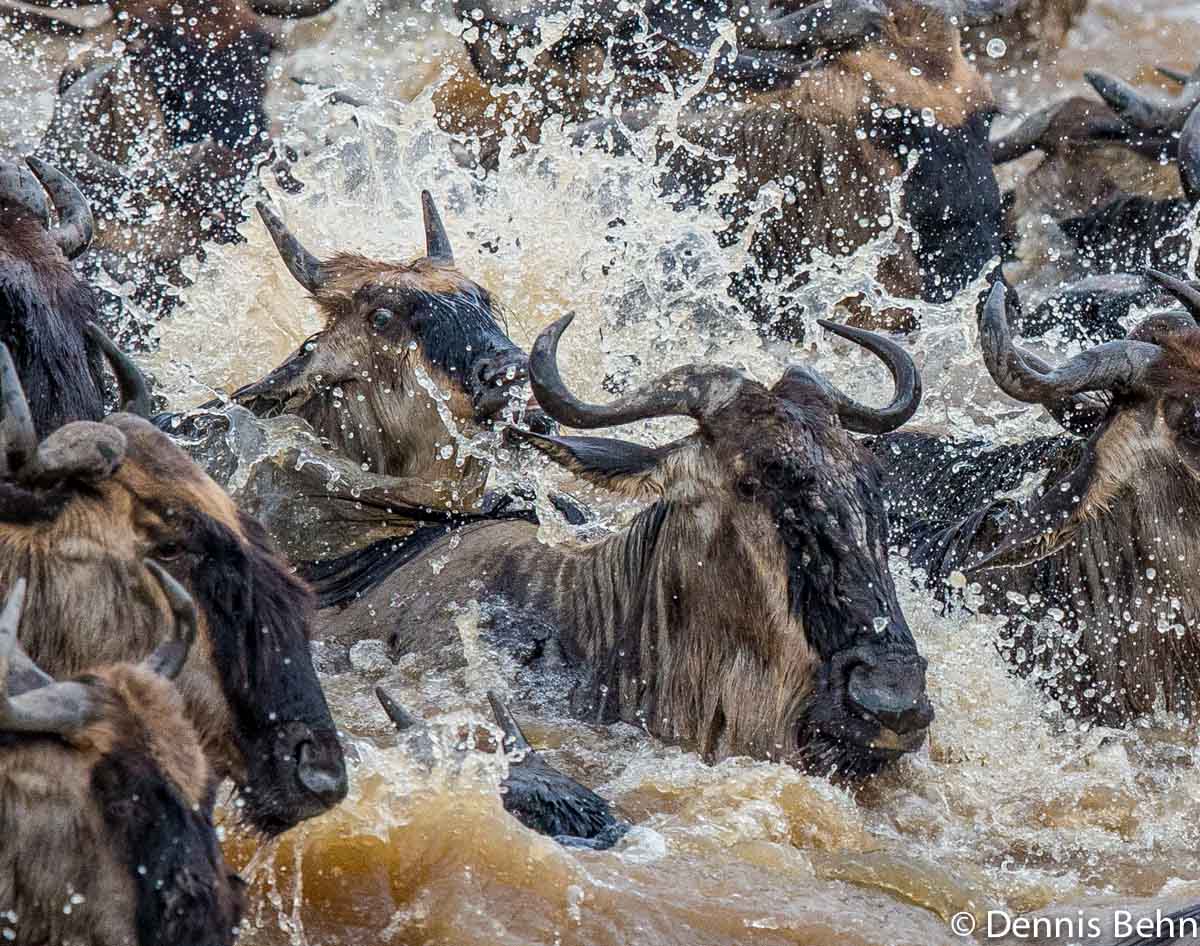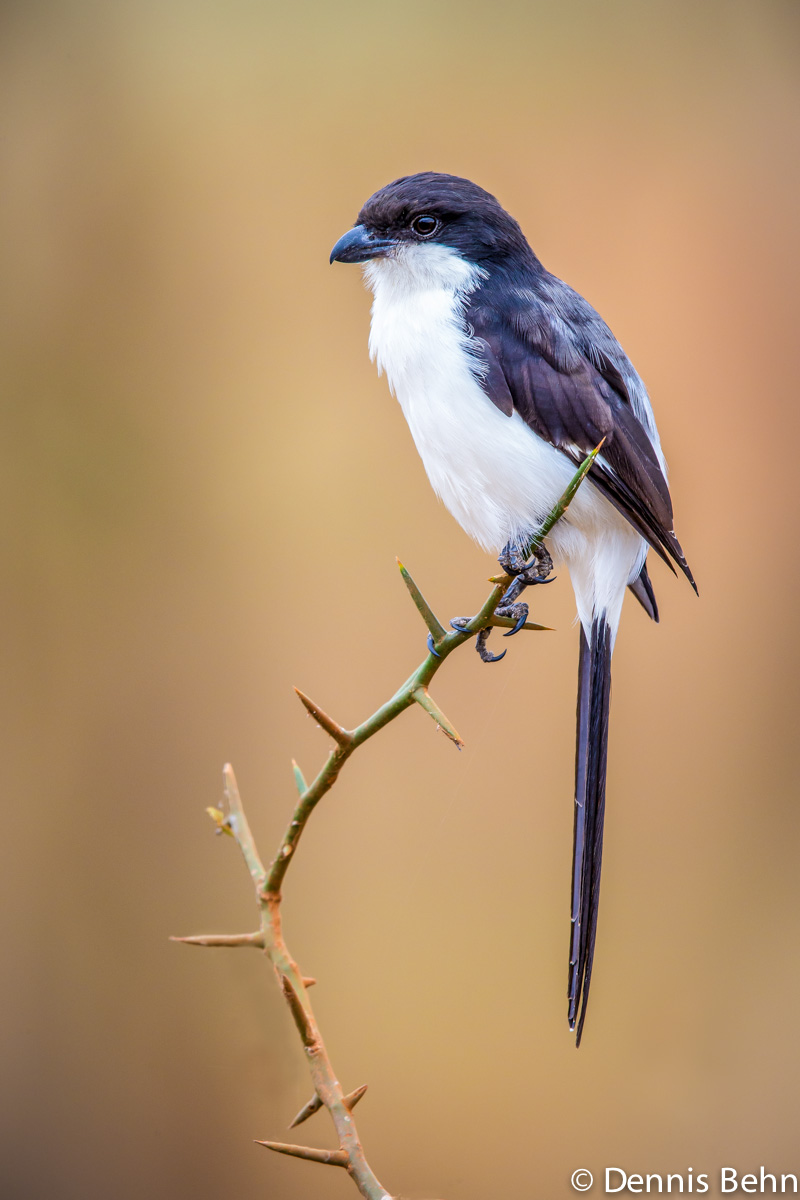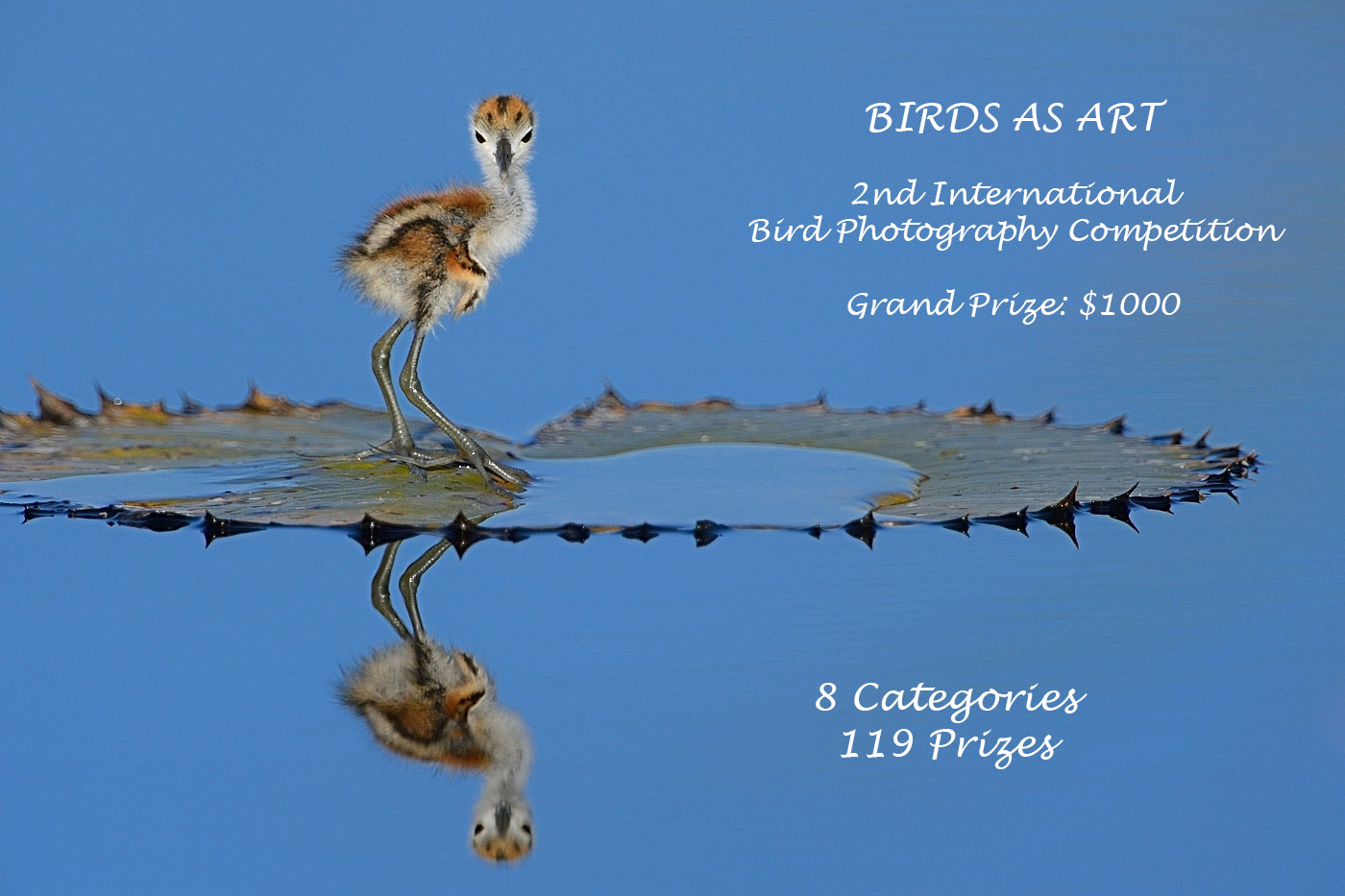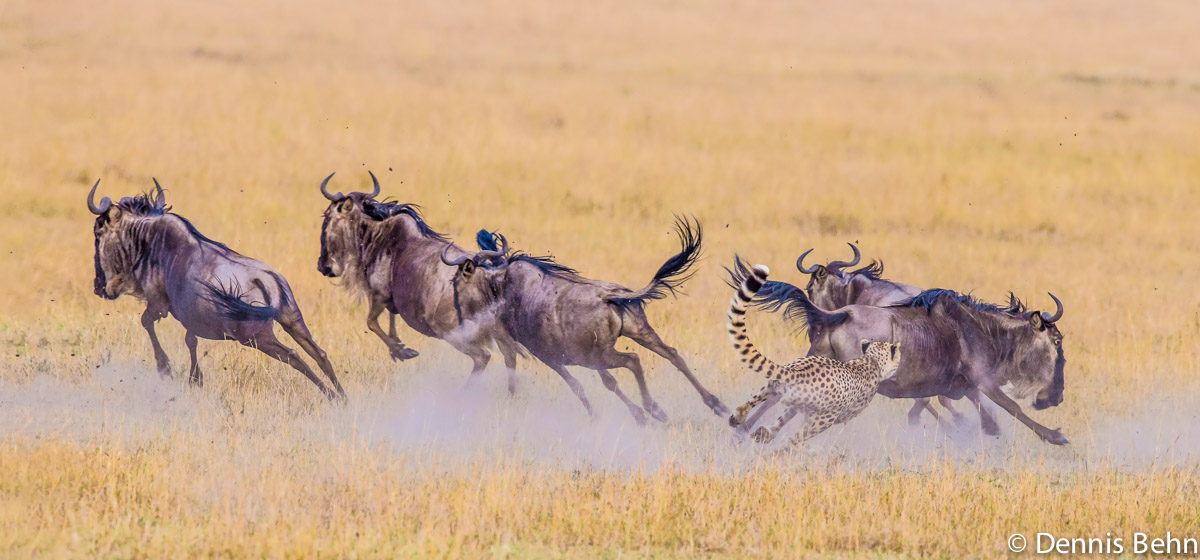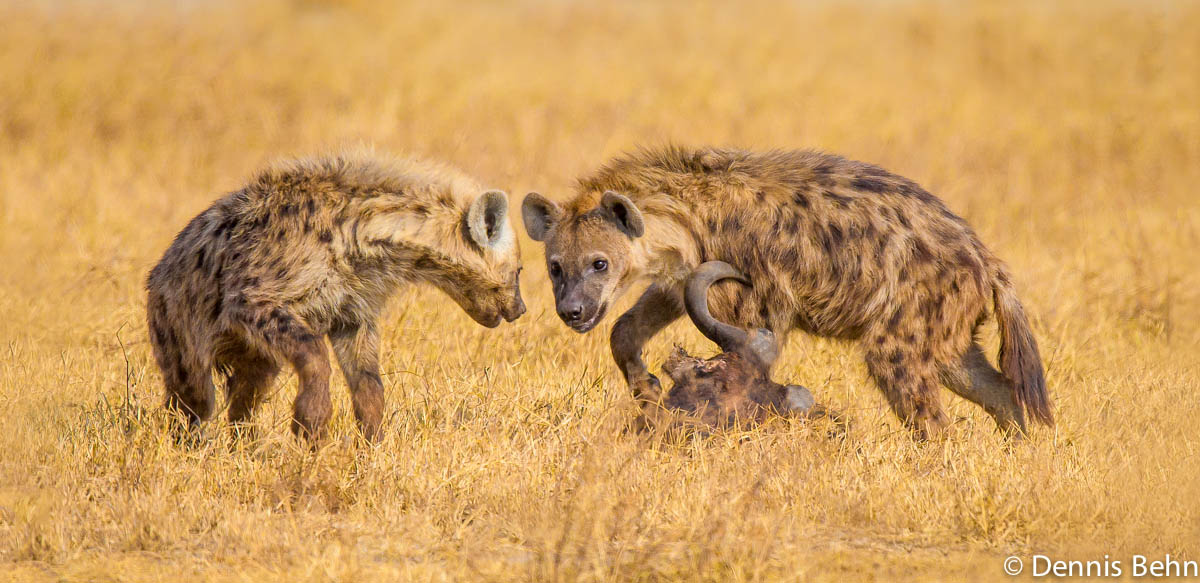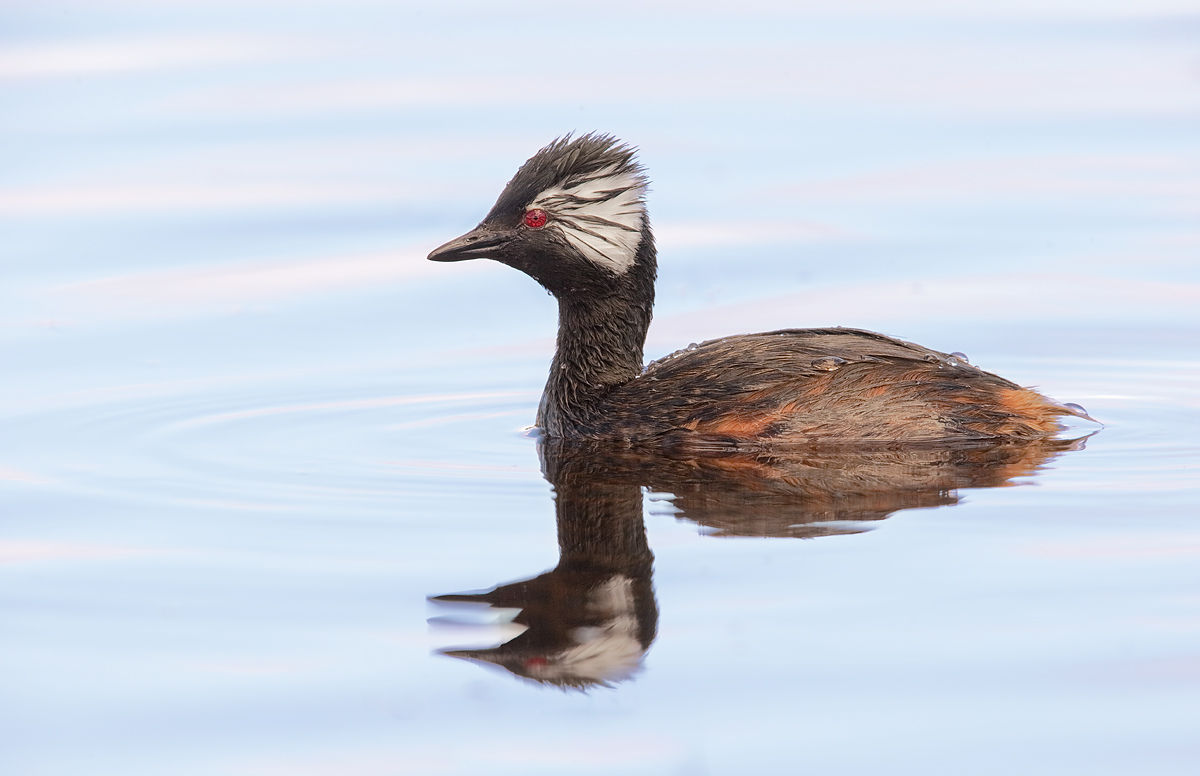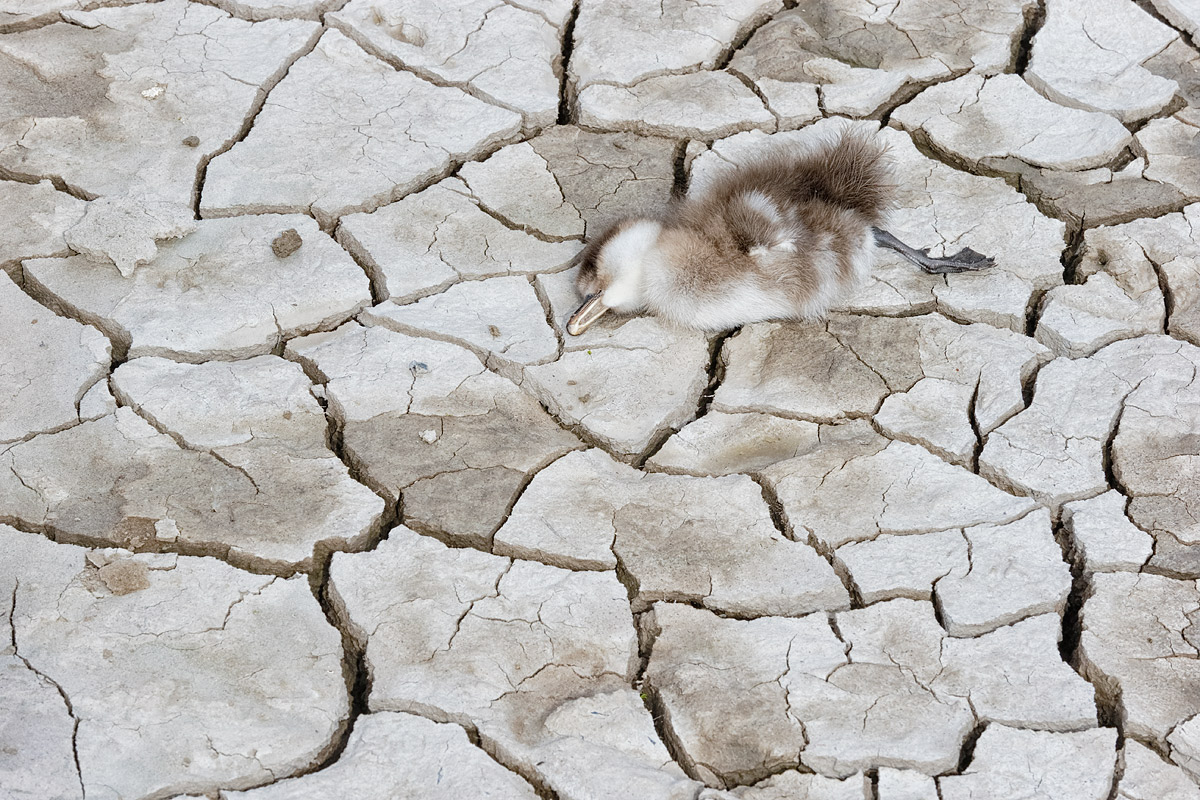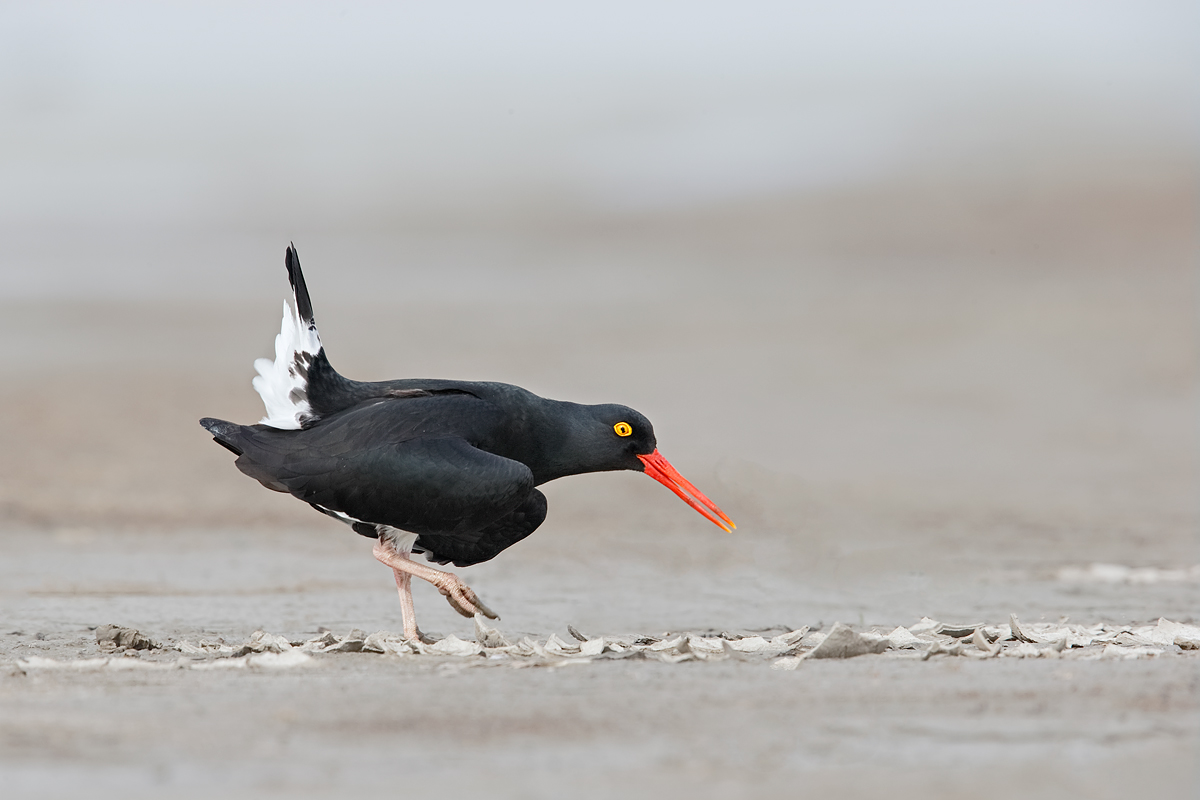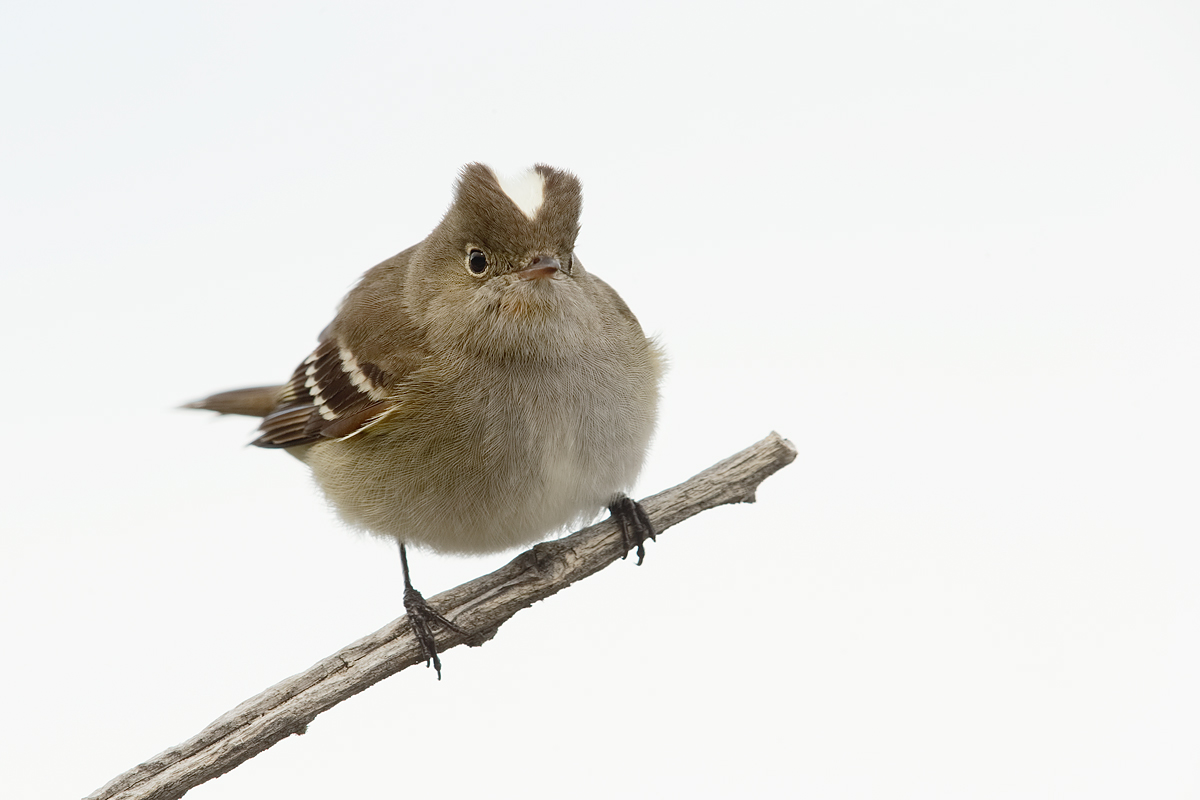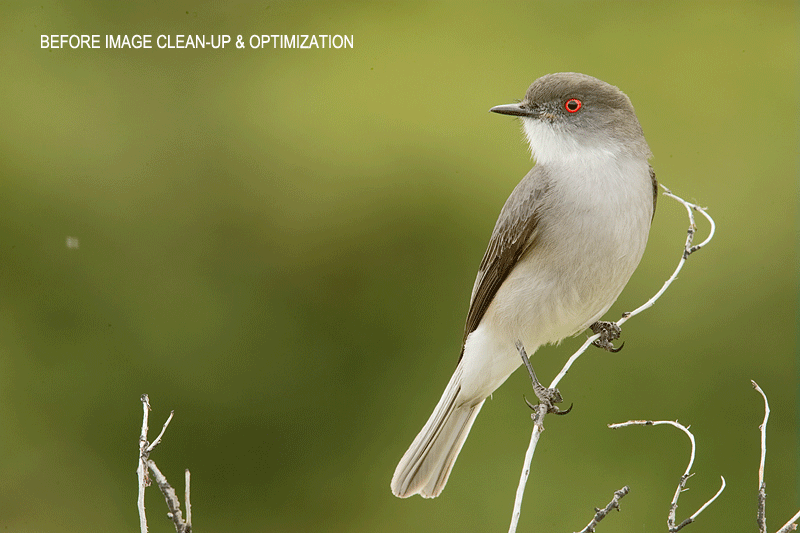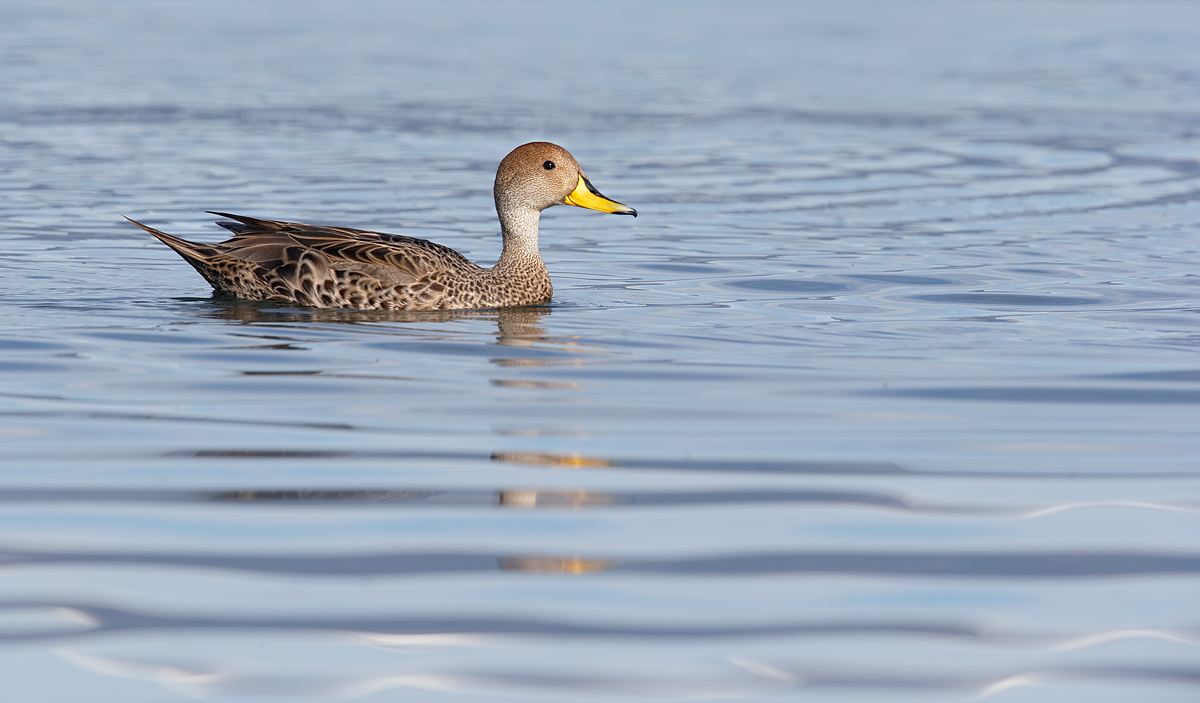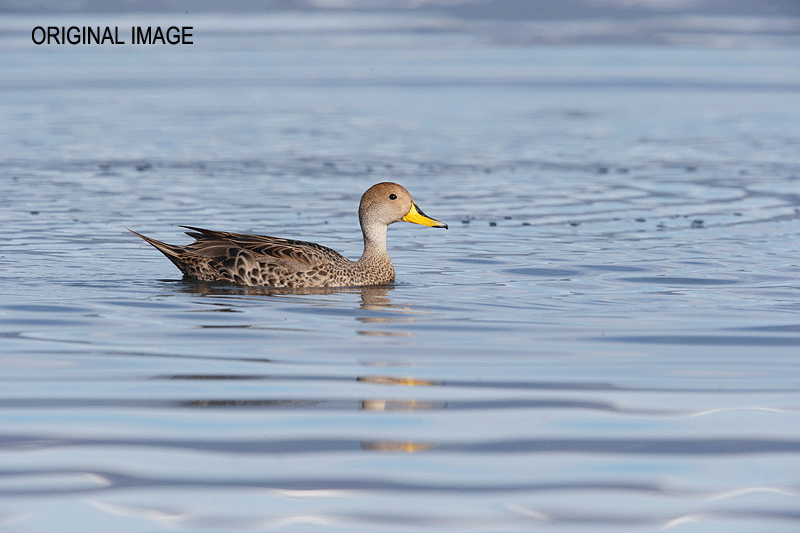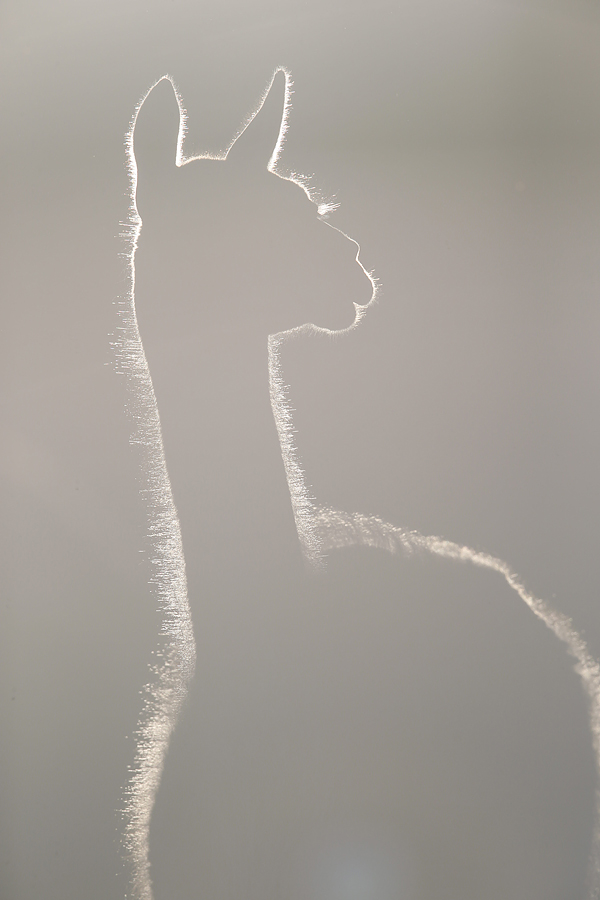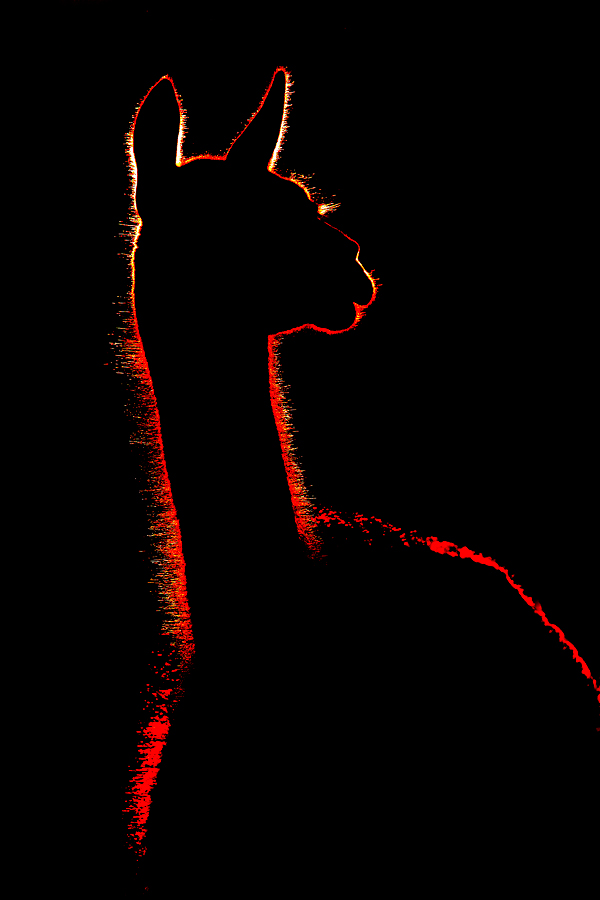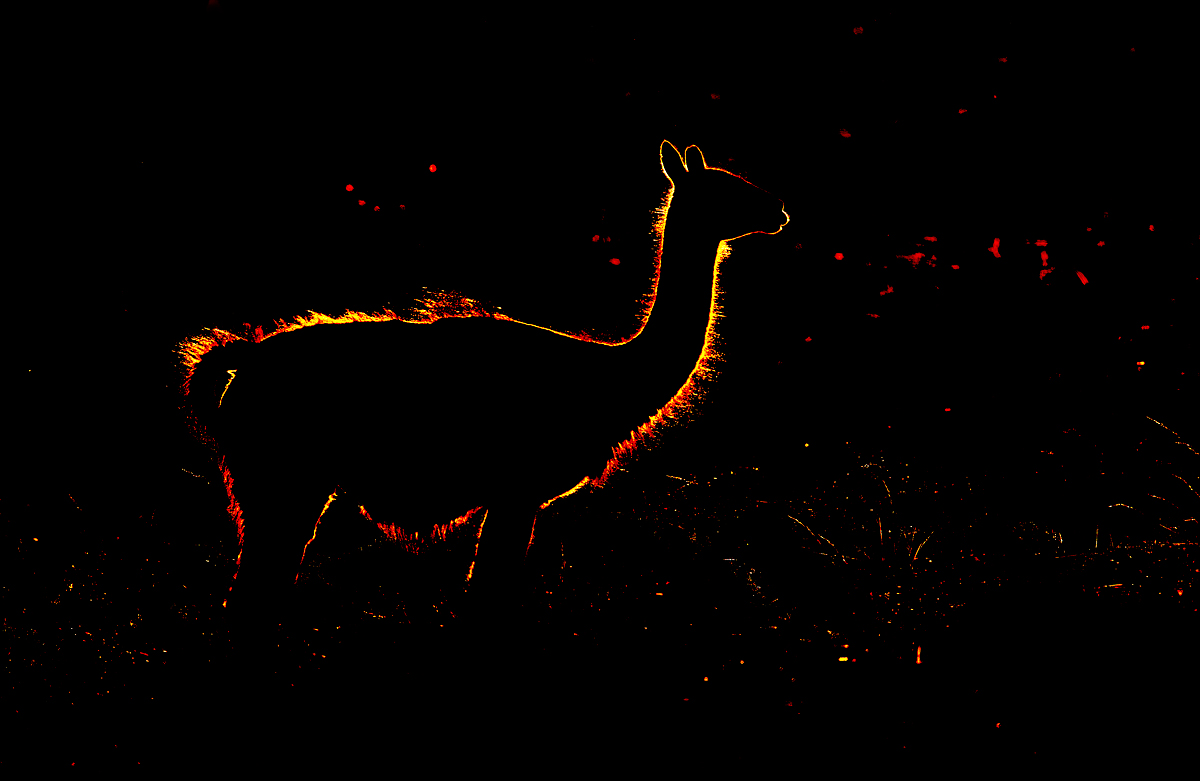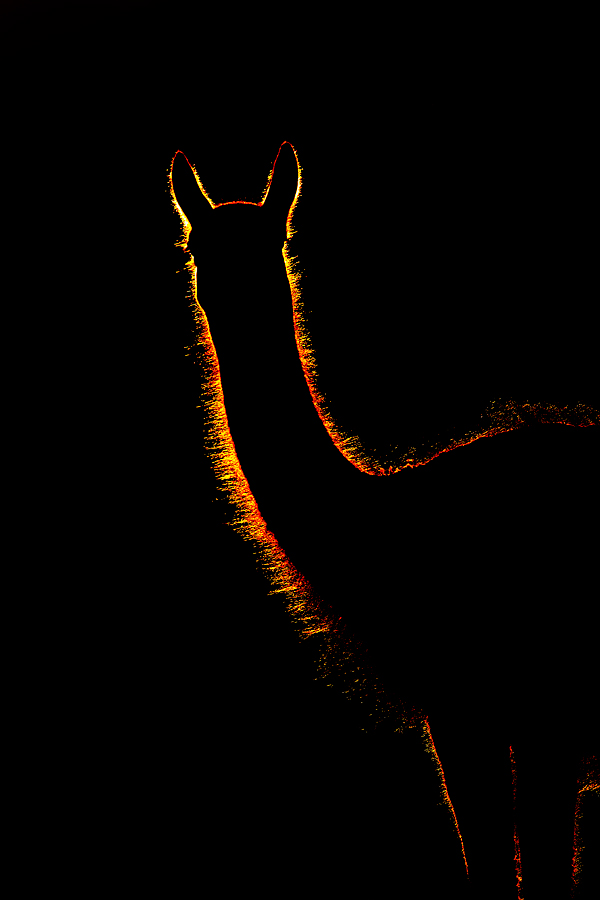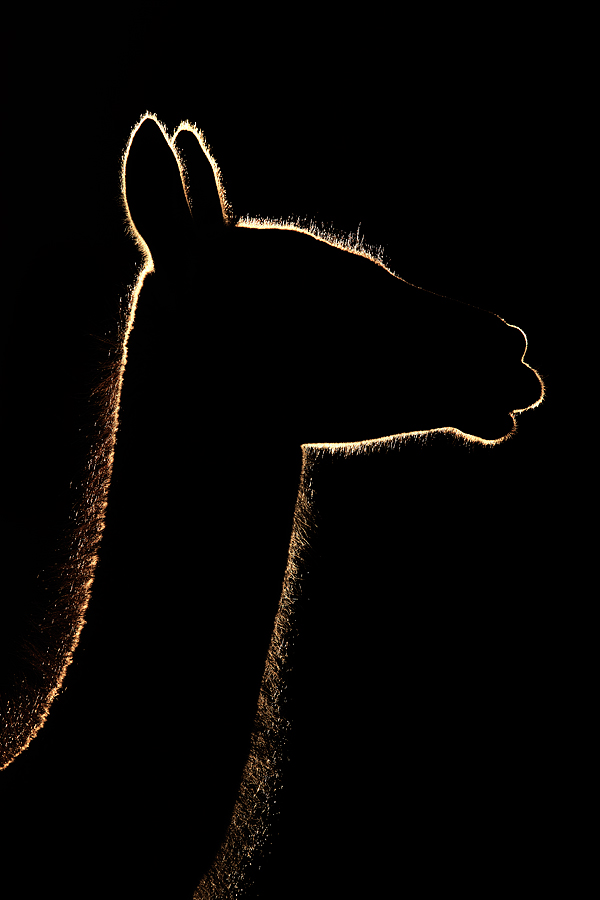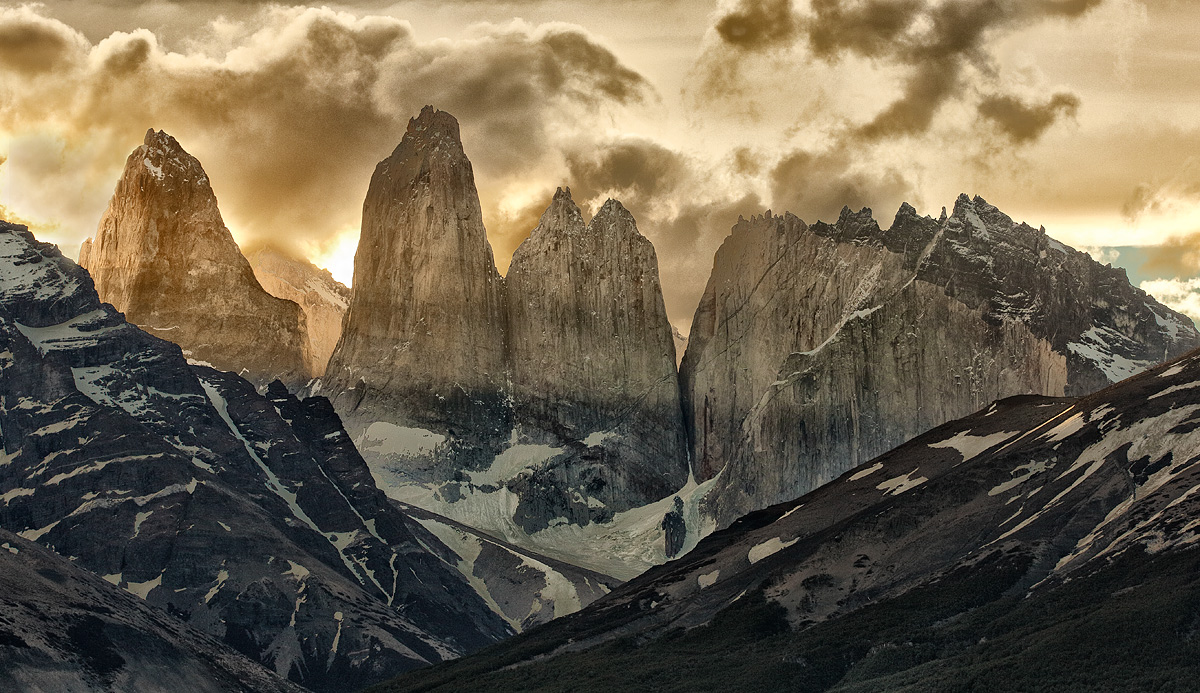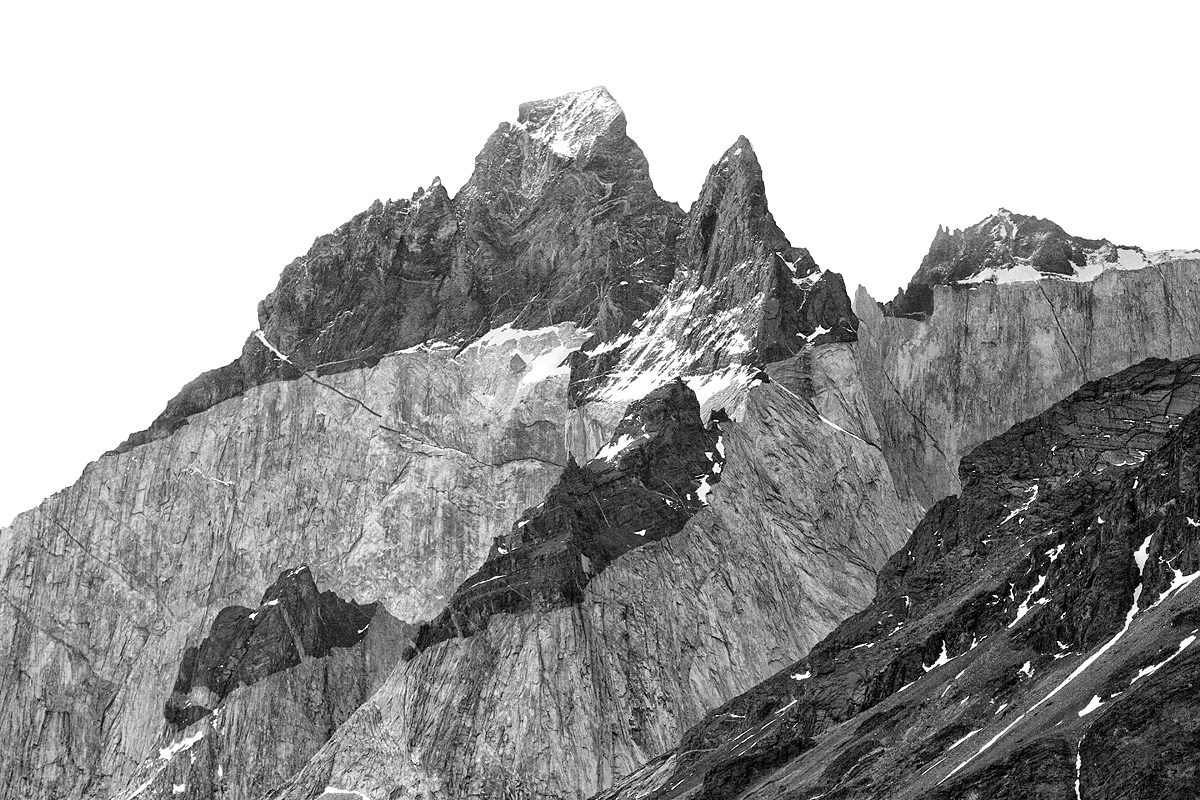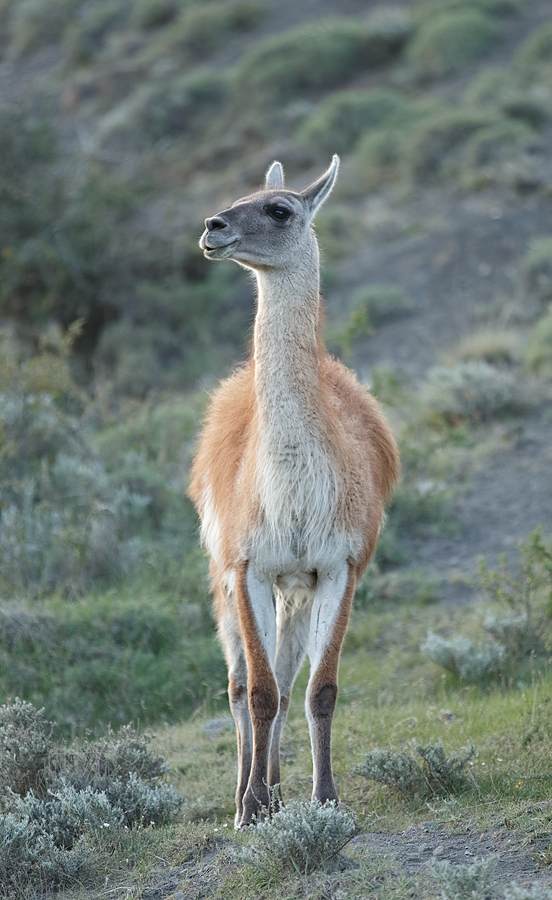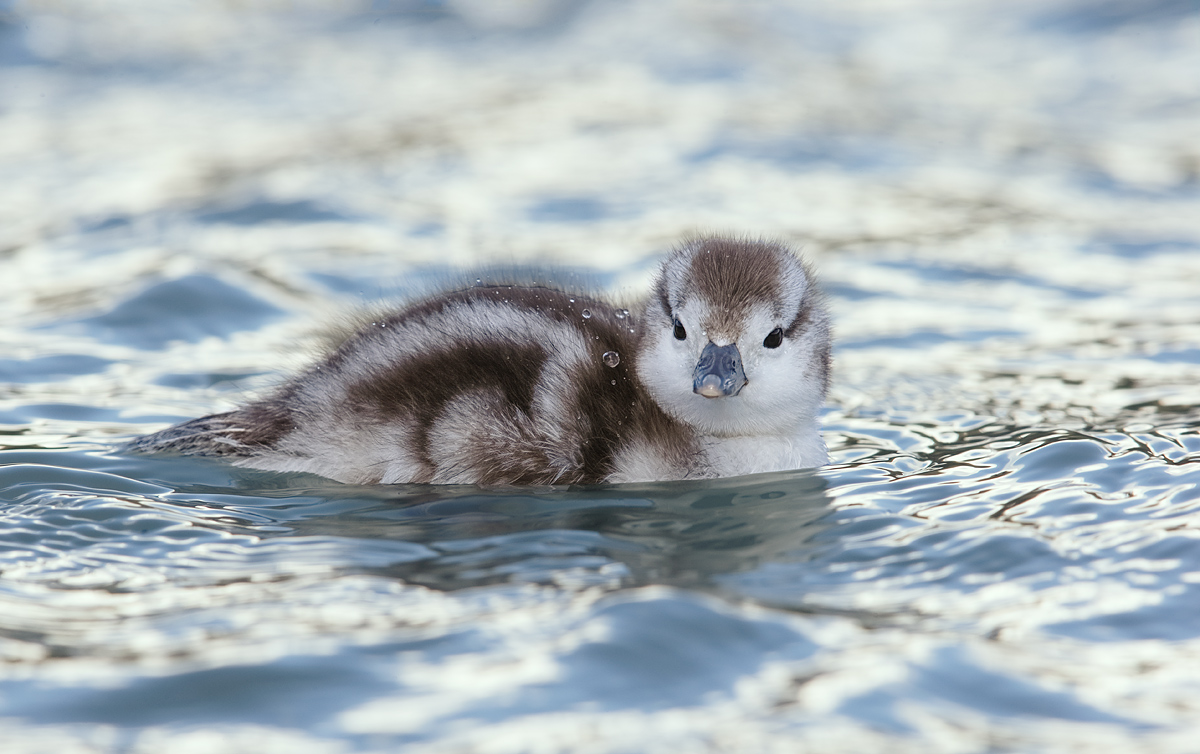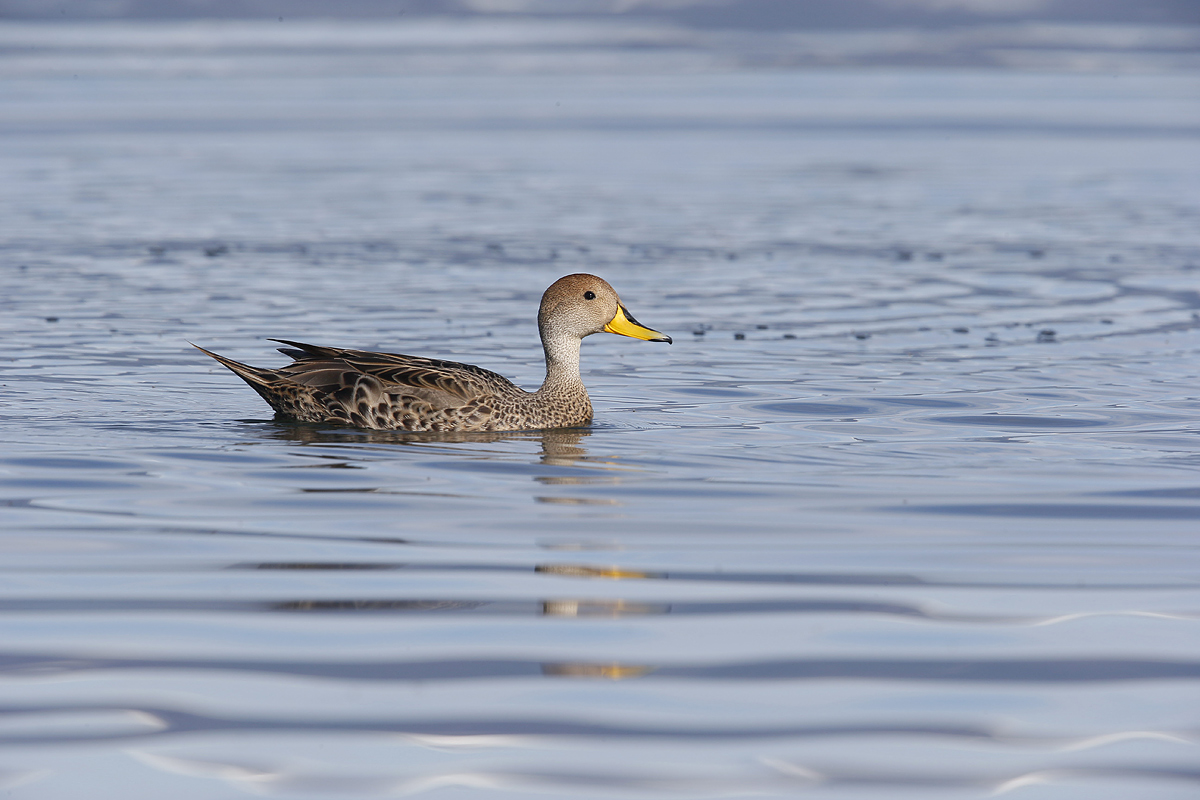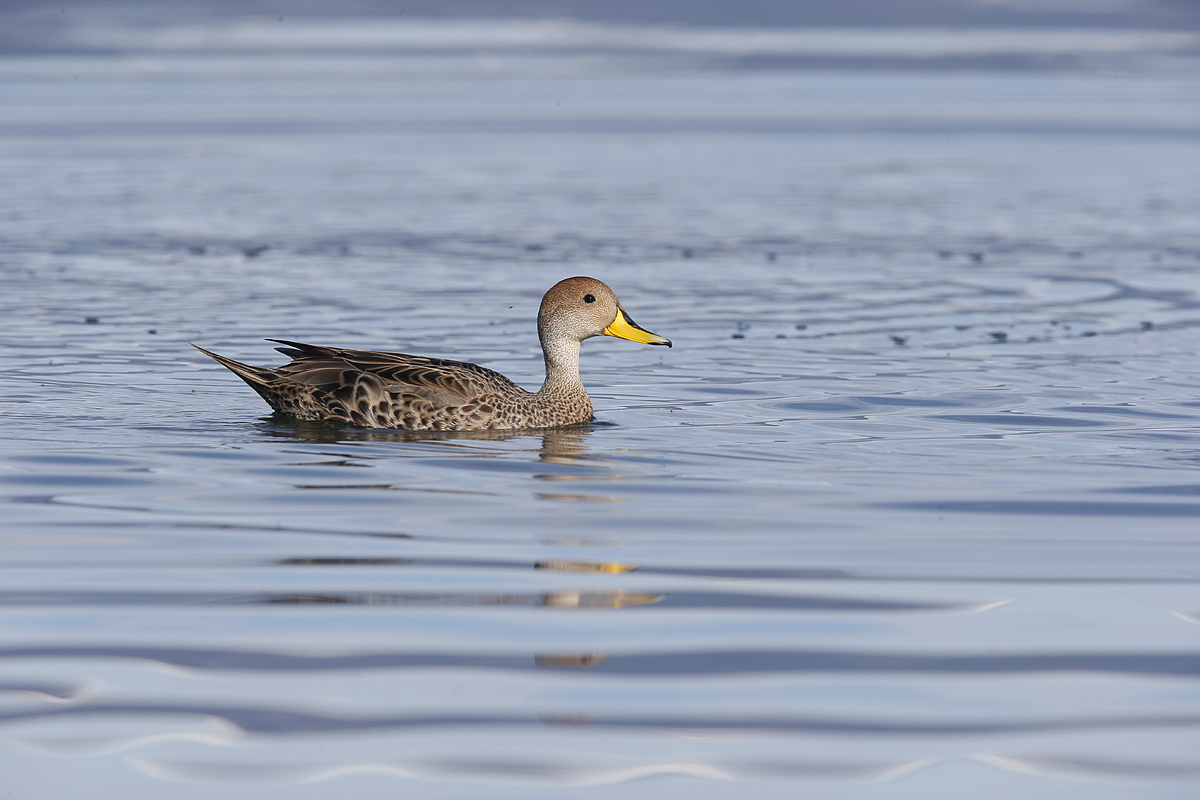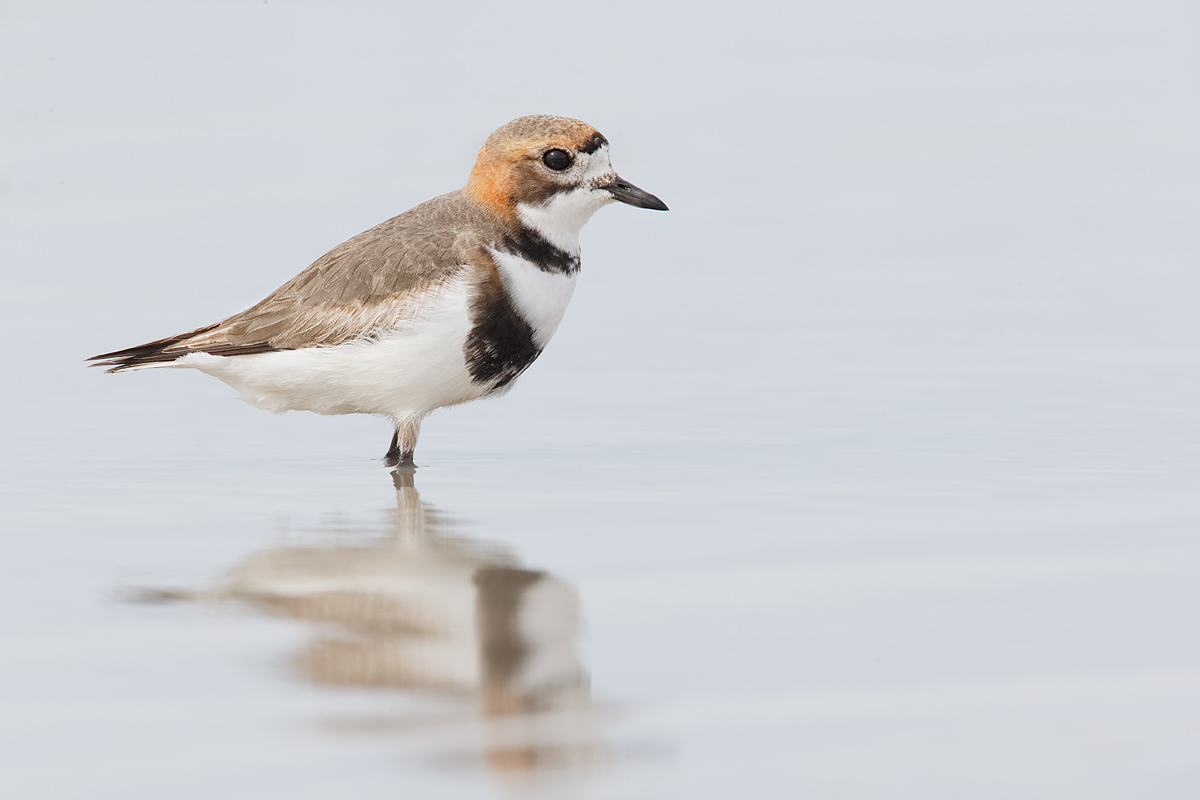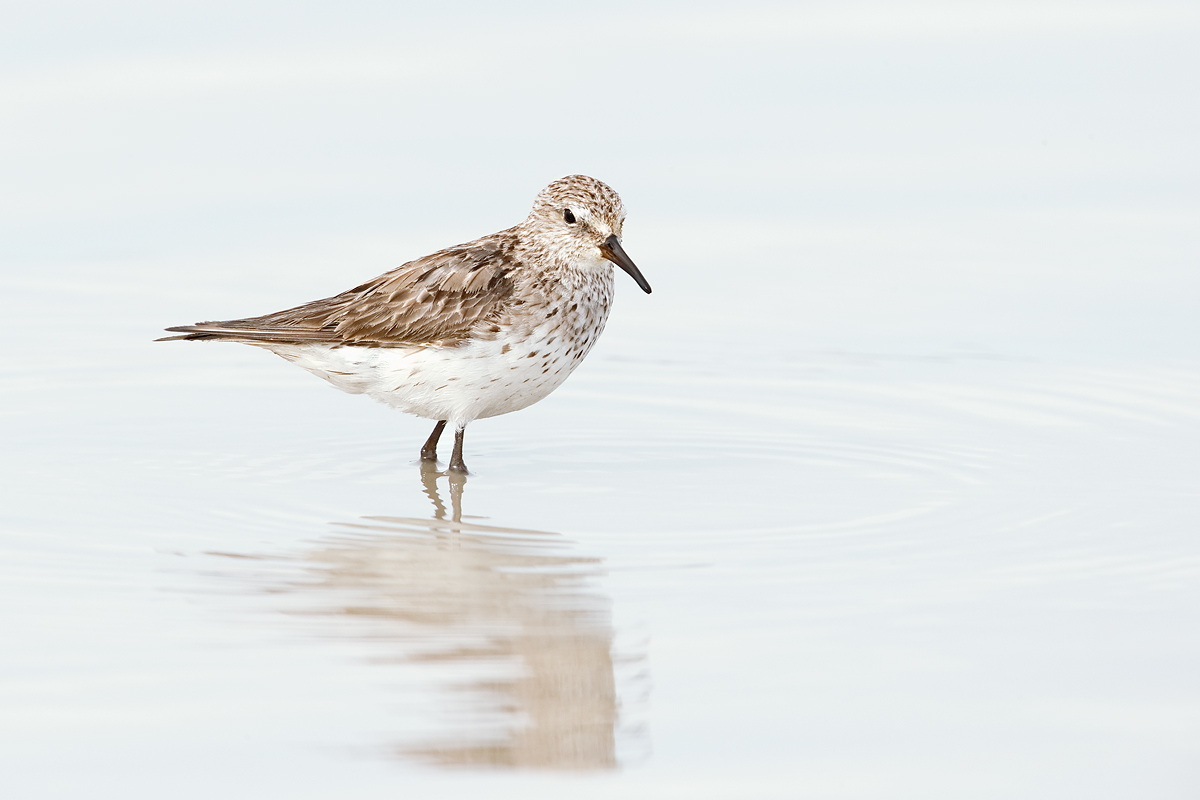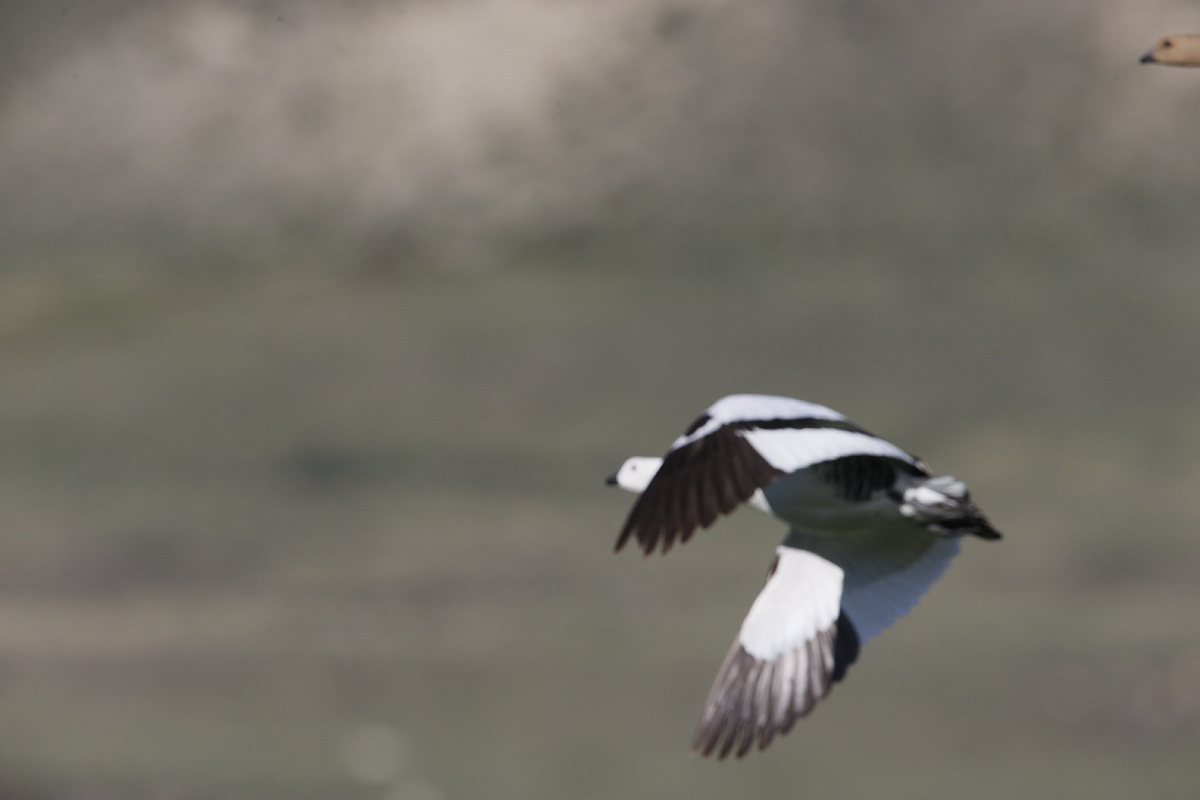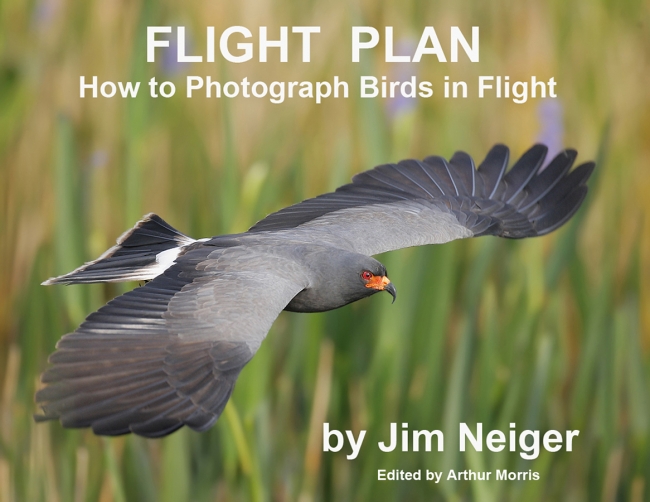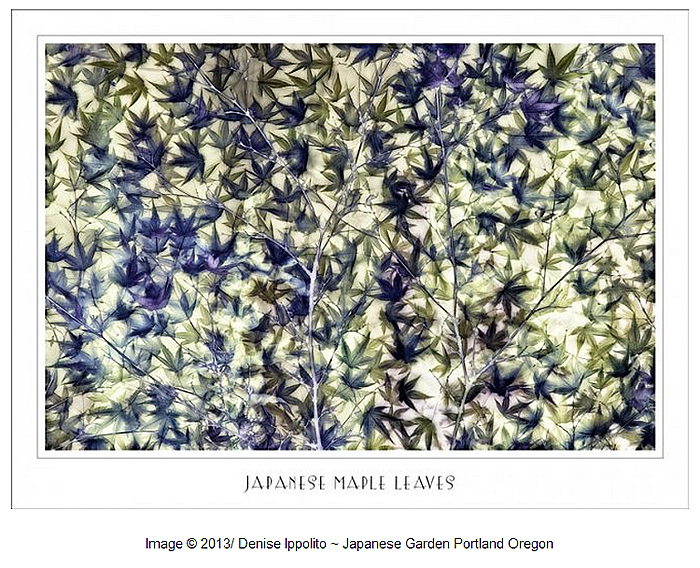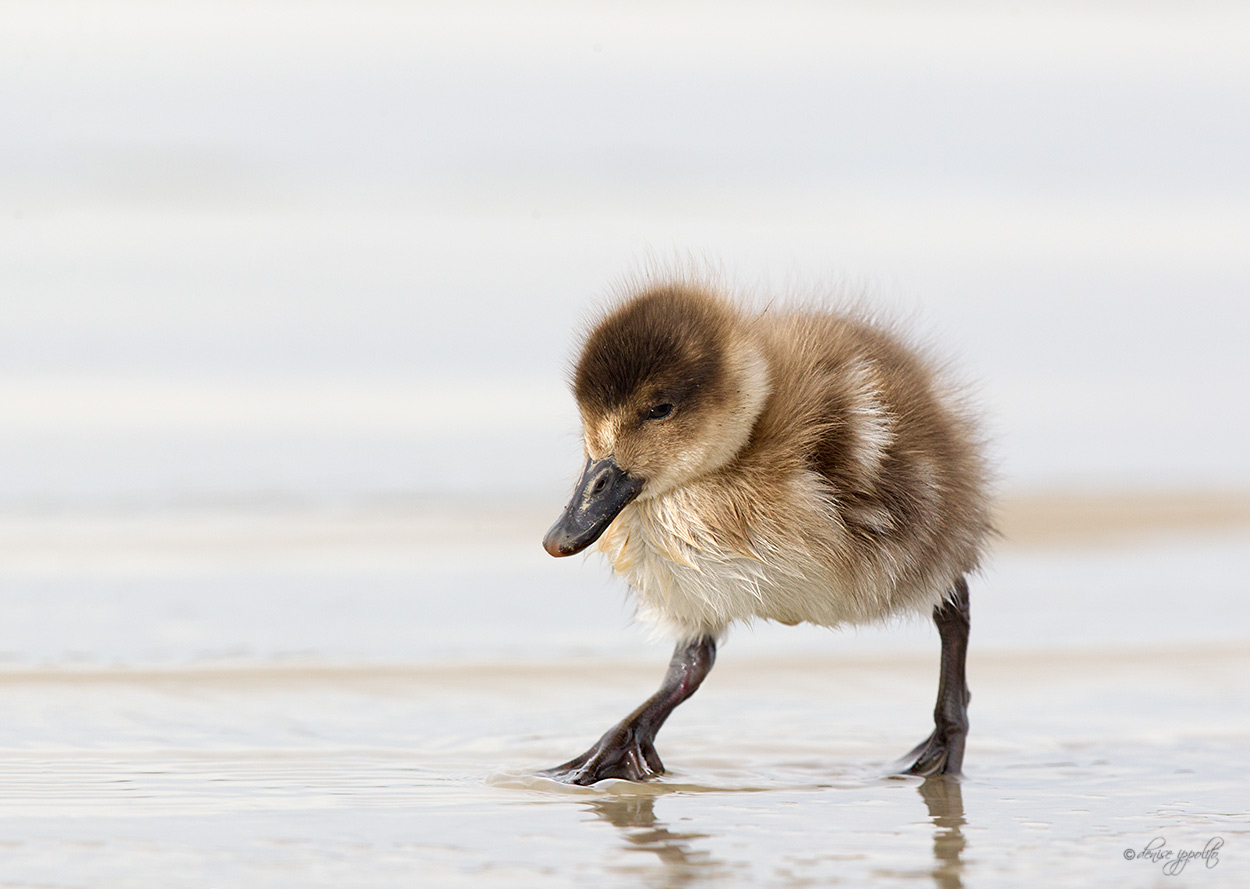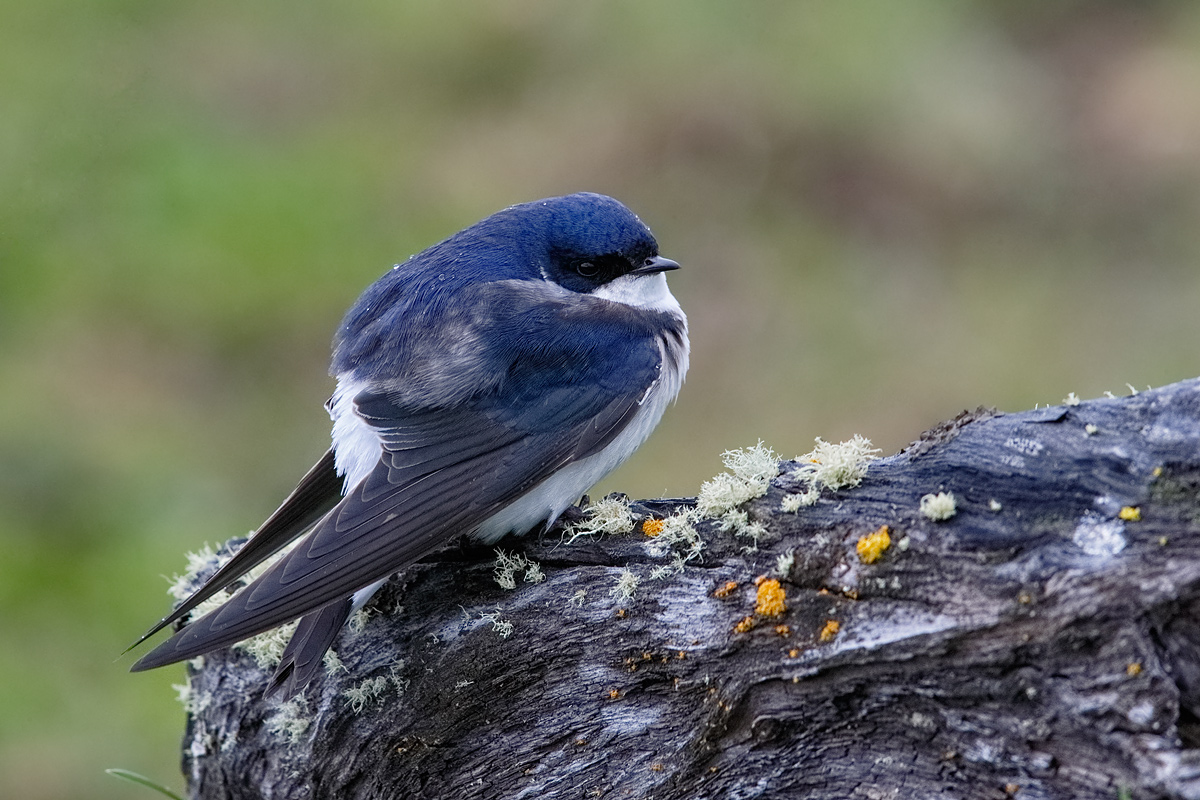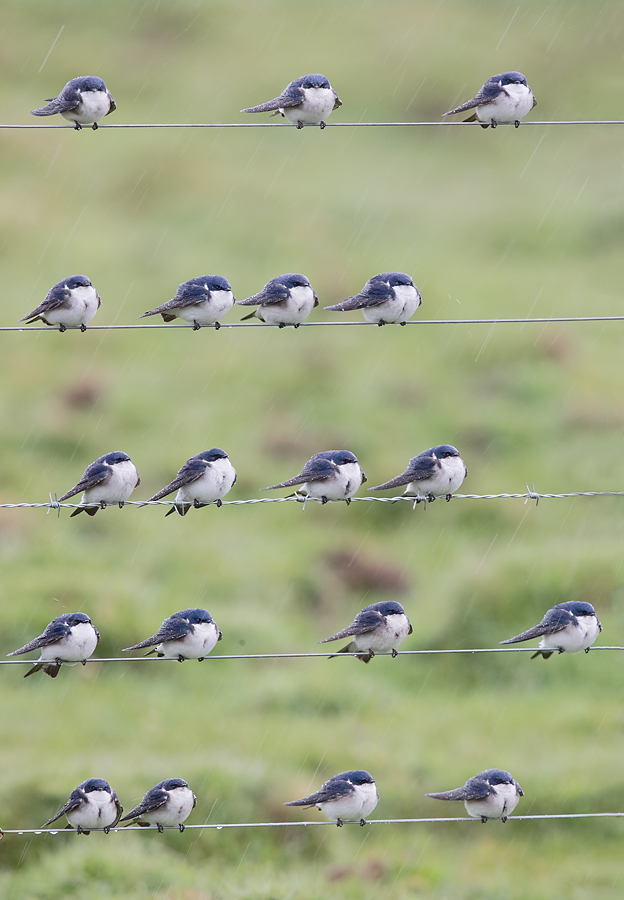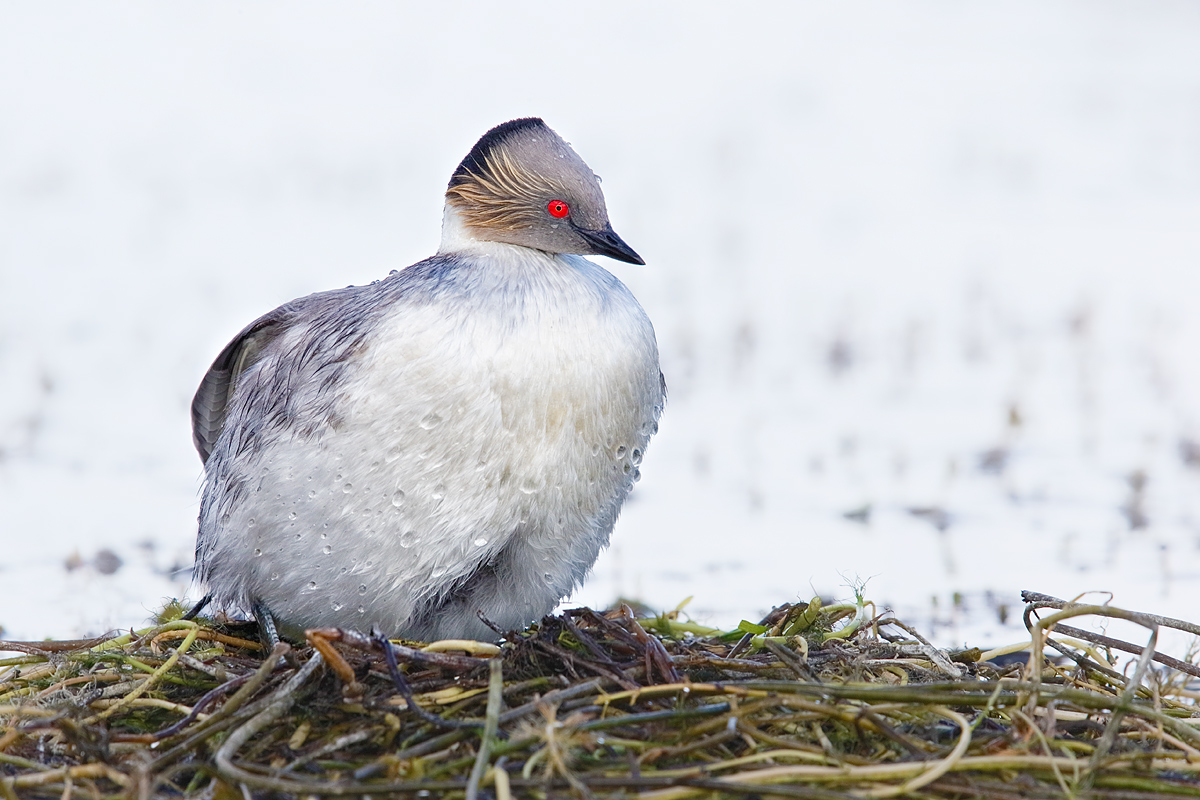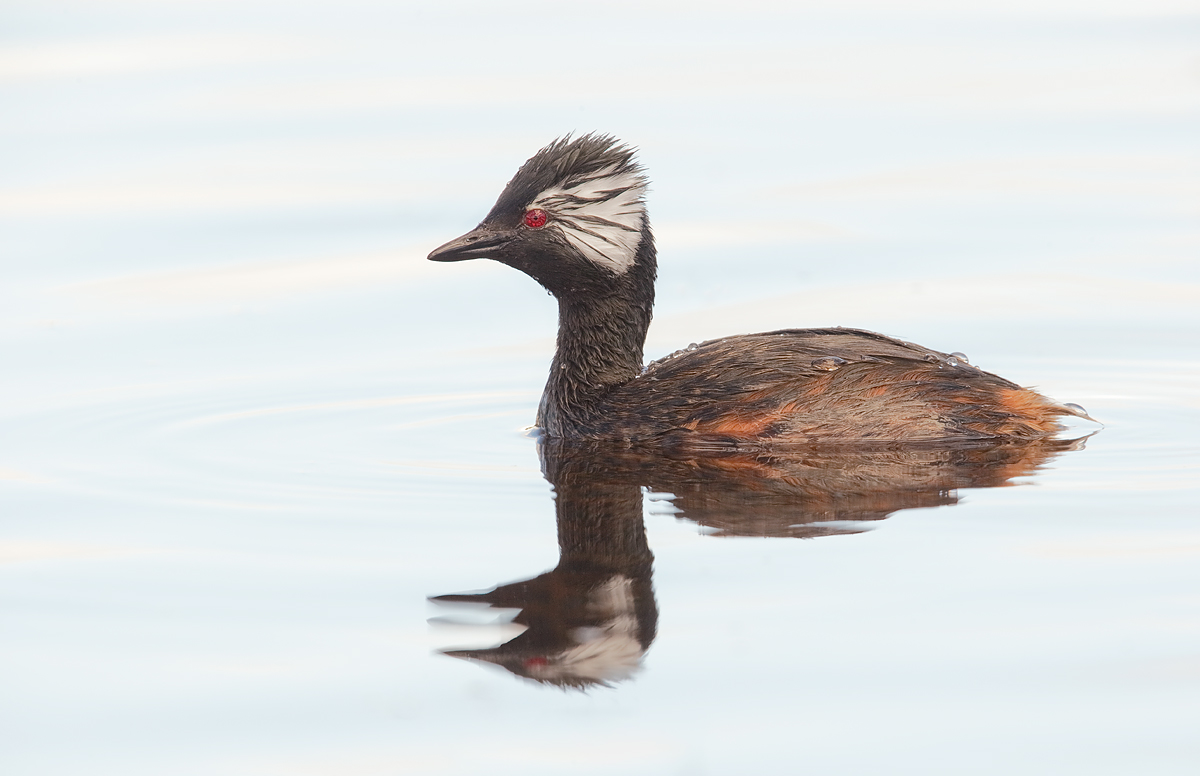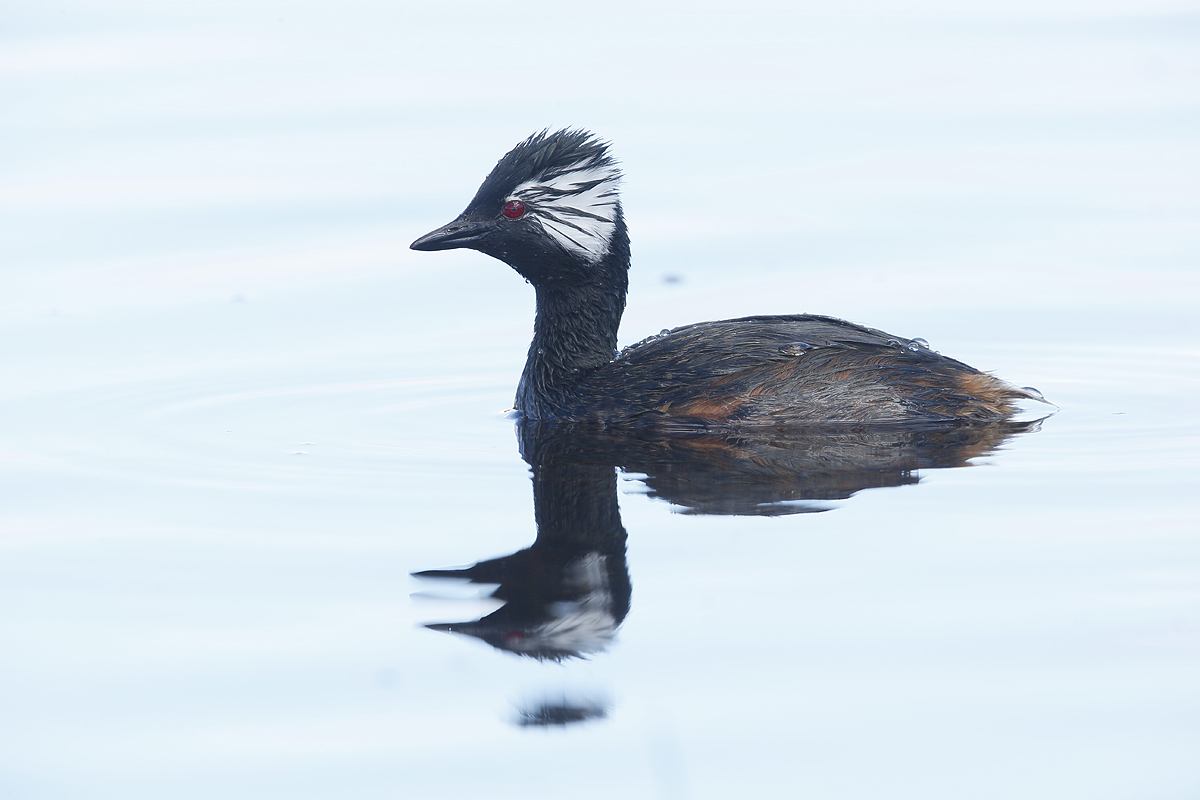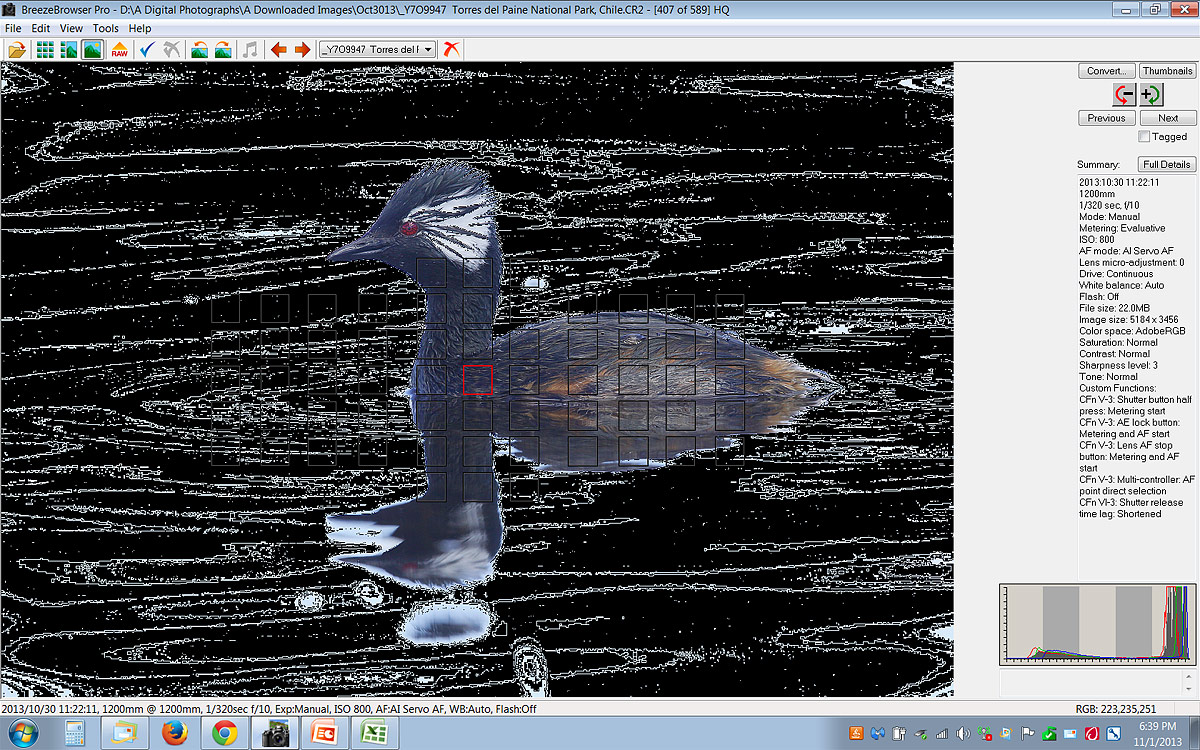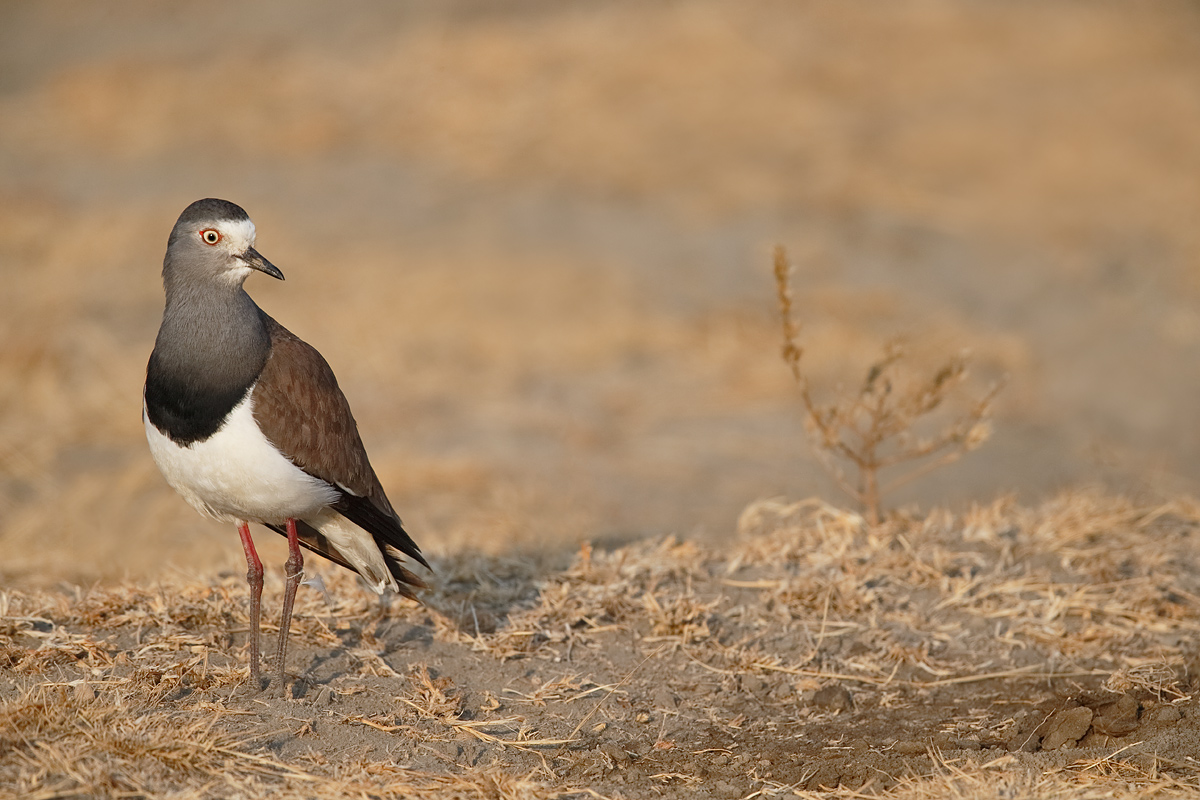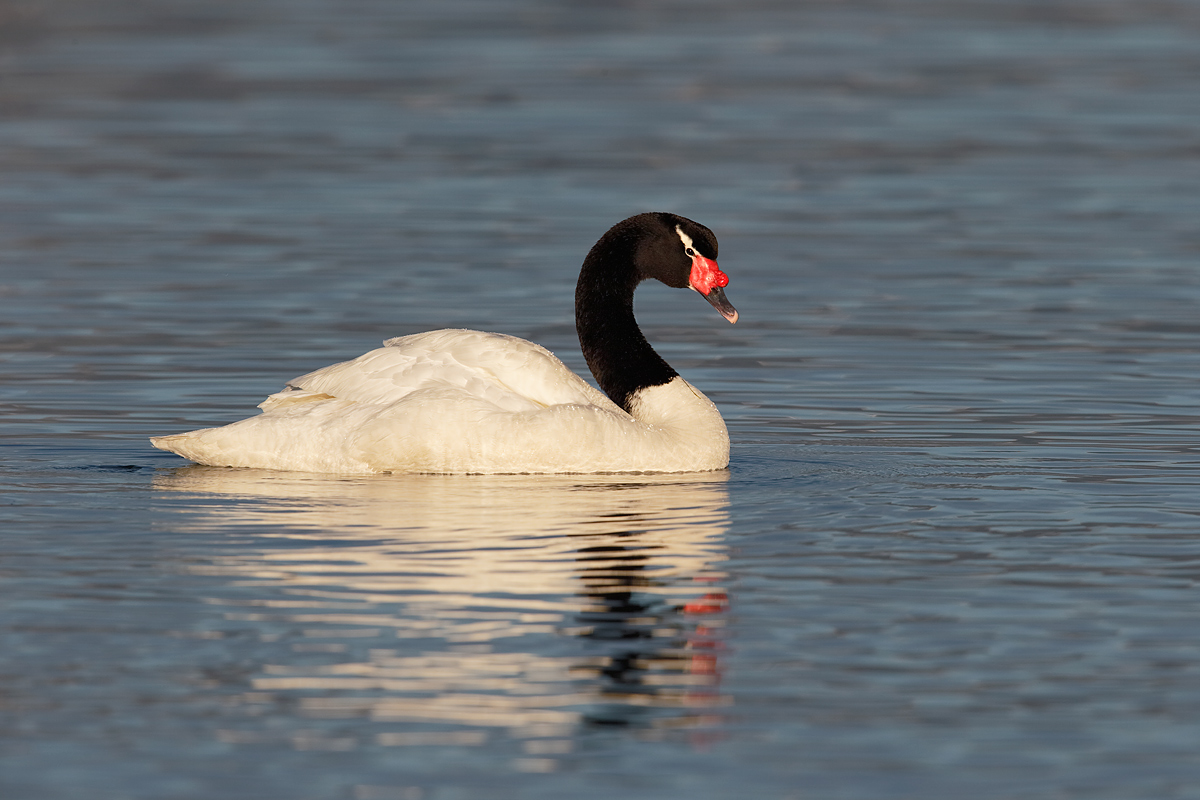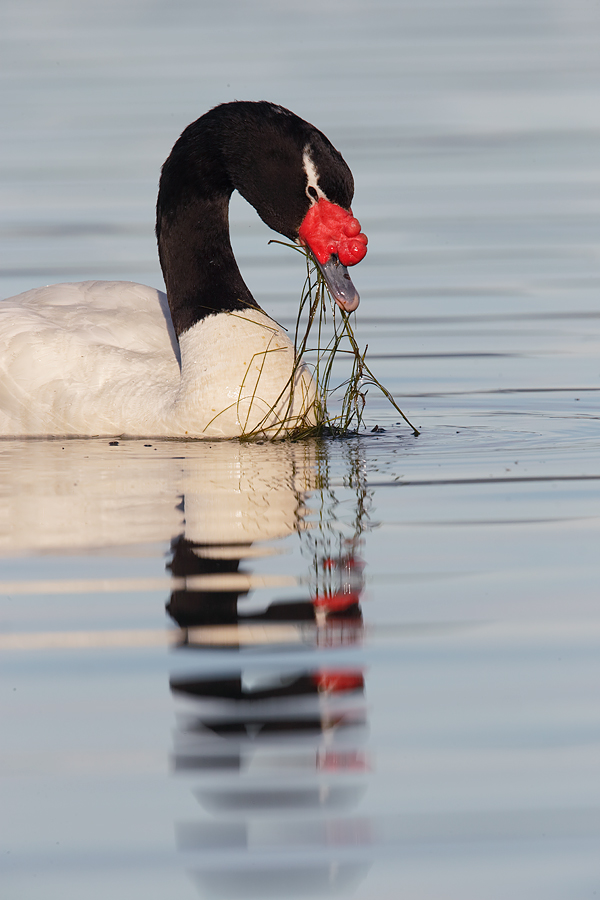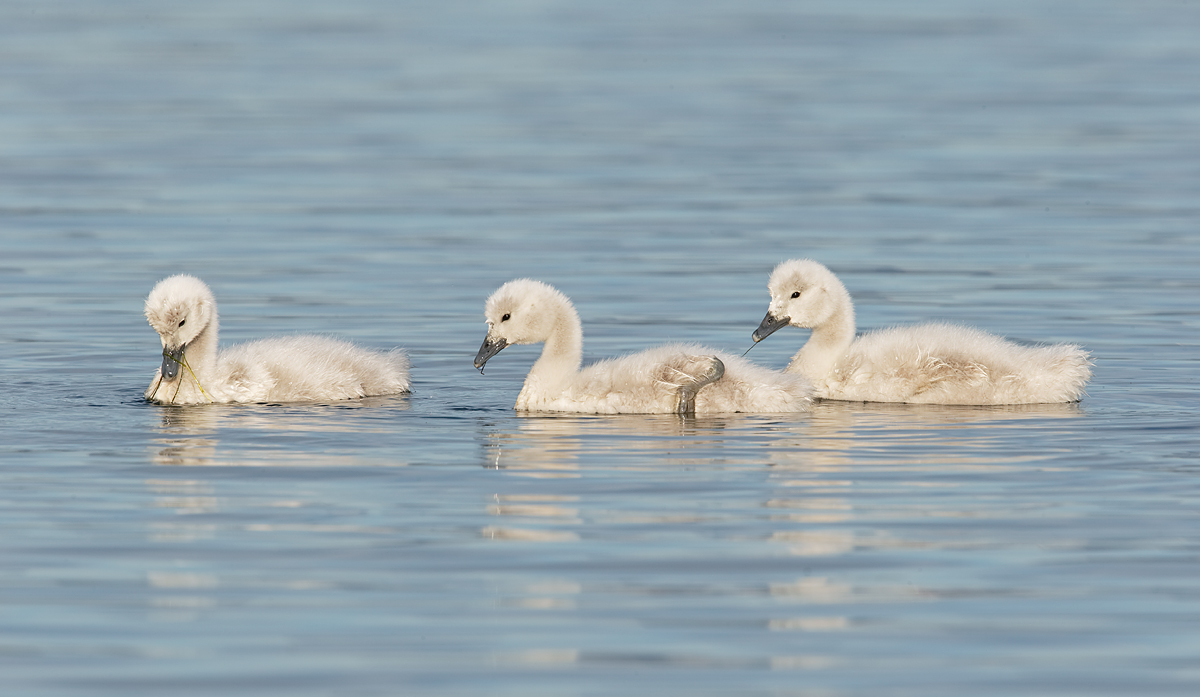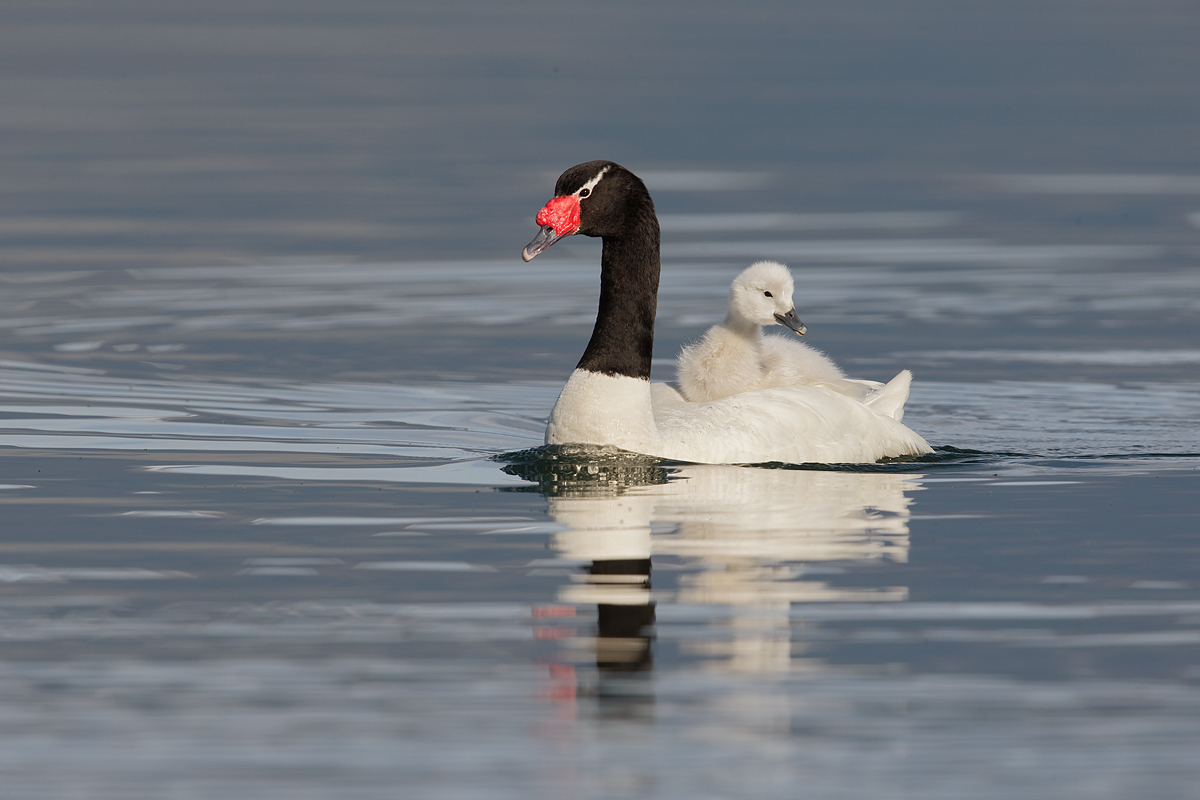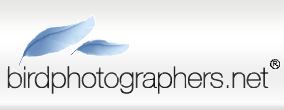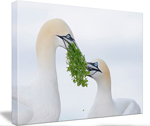November 20th, 2013
…..
|
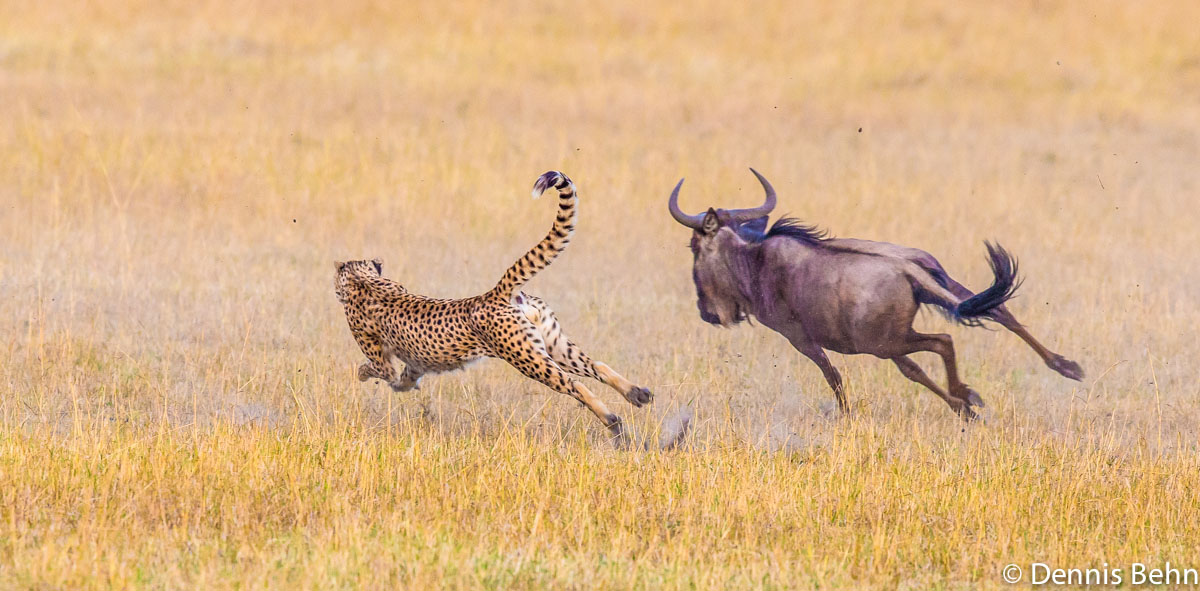
|
|
This is a second frame from the cheetah hunt series; it was created 7 seconds before the image above. Gear and exposure were all the same.
Image courtesy of and copyright 2013: Dennis Behn
|
Denny Behn
Denny Behn and his lovely wife Connie joined Todd and me for last summer’s Tanzania photo-safari-both sweet as sugar. Connie made some point and shoot images, shot some video, and otherwise simply enjoyed Africa. And Denny was eager to learn to make better images; I have never seen anyone improve so much in the space of two weeks. Denny showed what’s possible if you stay close, ask a ton of questions, and take advantage of the informal computer sessions that are offered every day. Thanks a stack to Denny for sharing his safari story with us in today’s blog post.
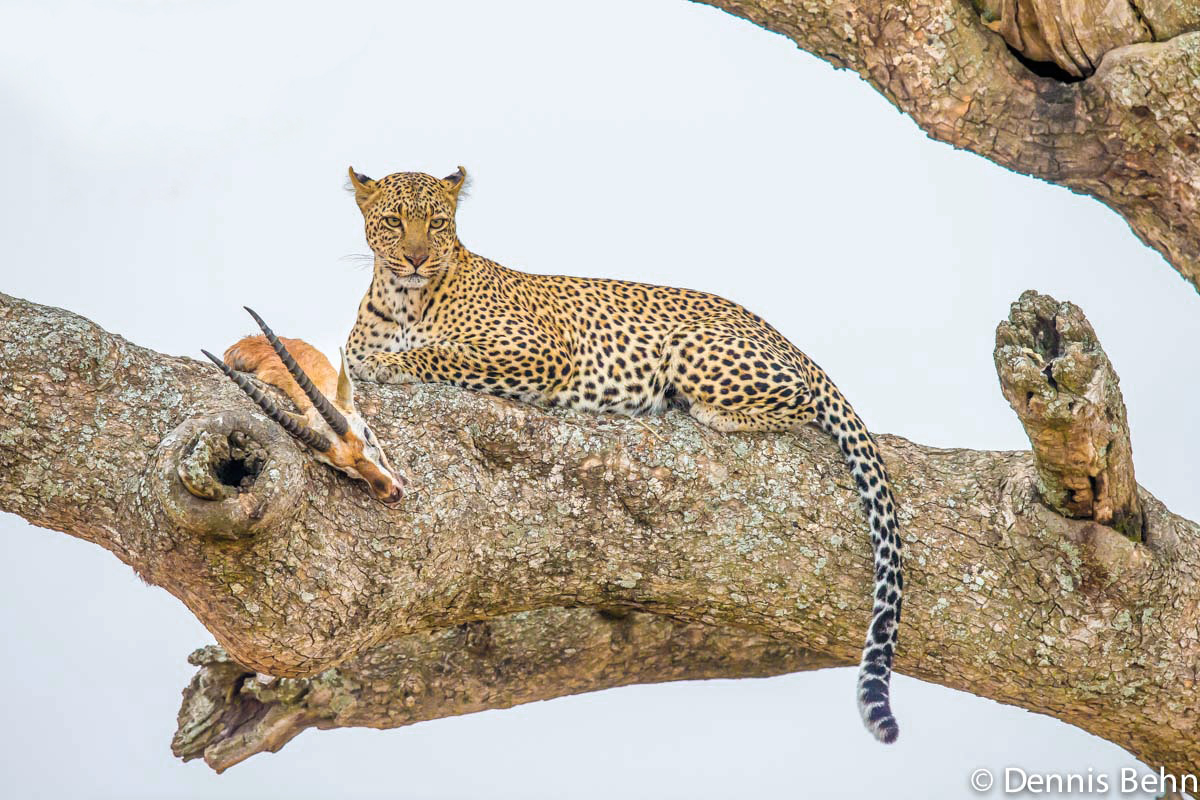
|
|
This image of a Leopard with its Thomson’s Gazelle prey was created with the Wimberley V-2 head atop a Todd-Pod-mounted Canon EF 600mm f/4L IS II USM lens and the Canon EOS-1D X. ISO 3200. Evaluative metering +1 1/3 stops: 1/320 sec. at f/5.6 in Manual mode.
Image courtesy of and copyright 2013: Dennis Behn
This image should look familiar to regular readers. When we find something great on safari we strive to get all of our vehicles in position to make great images. That’s just what we did here. Then Denny did his job by applying what he had learned in only a few days. And he created a superb image.
|
My Safari Experience, by Denny Behn
Our trip to Tanzania this year with Artie and Todd Gustafson was amazing to say the least! Organization of the trip was perfect; hotels, travel, everything went off without a hitch. And our safari vehicles were the best setup I have ever seen for photography. This trip was first class in every way. And as for game sightings we could not have asked for more. I had hoped above all hope to see a cheetah or a lion hunt, and we saw both. And perhaps we might see a wildebeest crossing, and we saw many, or a leopard in a tree with a kill, saw that… it was unbelievable!
You go on a trip like this to get photos you cannot get in any other way. But for me, the constant instruction was invaluable. There was no question asked that did not get thorough attention until one worked it out. Instruction was hands on, but even more than that there was much to be learned by simply watching two pros at work. It doesn’t get any better than that.
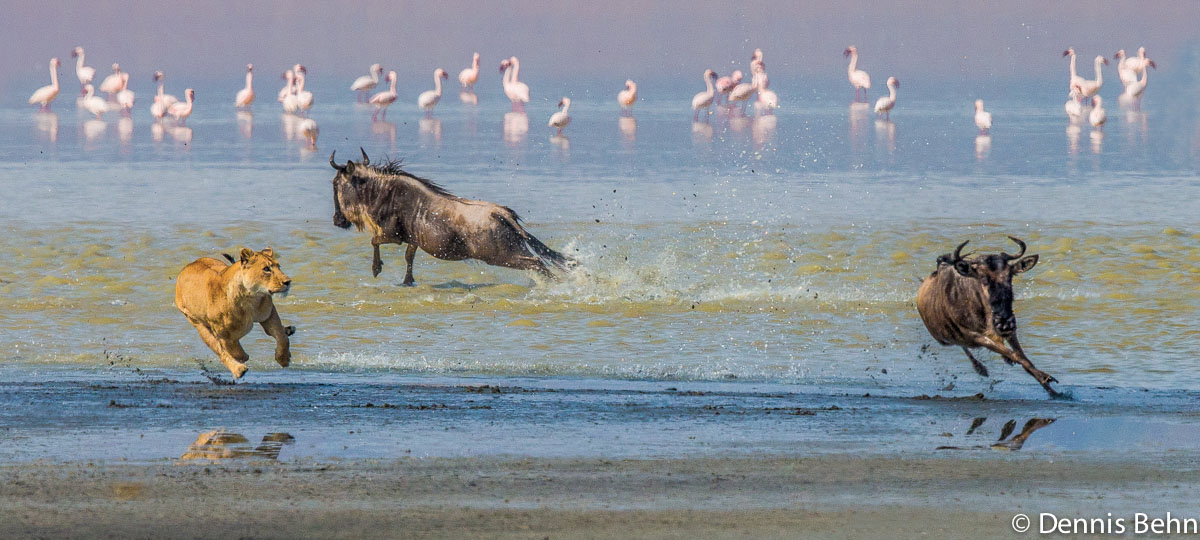
|
|
Here, Denny got a great image of a lioness chasing a large snack. With flamingos in the background. This image was created with the Wimberley V-2 head atop a Todd-Pod-mounted Canon EF 600mm f/4L IS II USM lens and the Canon EOS-1D X. ISO 800. Evaluative metering at zero: 1/5000 sec. at f/7.1 in Manual mode.
Image courtesy of and copyright 2013: Dennis Behn
|
I learned a lot about light and composition, and how to look for a photo and actually get the shot. Artie and Todd usually had several good photos taken before I could get around to it. I teased Todd that he was the only photographer I know of with a “zoom” 600mm f4, as he was able to change teleconverters faster than anything I have ever seen! I also learned to look for a photograph and not just shoot pictures.
In the evenings, Artie sat by his computer and showed many of his shots from the day, what he planned to keep and what he would throw away, and why. He also showed us how to optimize a photo of our own and that was an incredible learning experience as well. Artie is a Photoshop wizard and after seeing his own personal optimized shots it was easy to see why he is the best at what he does.! I am forever grateful for the trip of a lifetime.
Denny and the Shrikes
On the first few days of the safari, Denny was obsessed with the shrikes. If he saw a shrike anywhere, he would shout “Stop” to the driver guide. We patiently explained to him that by stopping for distant birds sitting on ugly perches that he was likely missing out on excellent opportunities. I worked with him every day at the computer (while many others grabbed much needed rest). I showed him what a pleasing perch looks like. I explained the benefits of using the 2X III TC with his 600 II when photographing relatively small birds. The image above, a lovely bird, sharp, on a beautiful perch, with a distant sweet background, is the culmination of the time we spent together at my laptop.
Big Cat Chase Photographer
Consider the following: after 8 safaris, I have created exactly zero big cat chase images. Did Denny have good safari luck? Absolutely. But more importantly, he used his newly learned skills to create several great images that leave me a bit envious. But very proud.
2014 Tanzania Summer Safari
This morning I learned of our first sign-up, multiple IPT veteran and all around good guy Jean-Luc Vailant who wrote: Count me in. I’ll mail the check this week. Jluc That is great news. Since we were prepared to go with only a single registrant I can purchase my flights this week! (Note: you can see some of Jean-Luc’s very fine images from the 2013 Galapagos Photo-Cruise in An Eye for Design here.)
If you are interested in joining us in Tanzania next summer please shoot me an e-mail and I will be glad to forward you the PDF with dates, itinerary, and price.
Bosque IPTs/Late Registration Discounts Increased
It’s Getting Late!
Register now; apply a $1000 discount to the 7-DAY IPT!
For information on both the 7-Day and the recently announced short version of the 2013 Bosque IPTs please scroll down here. If you would like to join us for the first 3 or 4 days of this IPT please shoot me an e-mail. Please call Jim at 863-692-0906 or e-mail for late registration discount info.
BIRDS AS ART 2nd International Bird Photography Competition
Learn more and enter the BIRDS AS ART 2nd International Bird Photography Competition here. Twenty-five great prizes including the $1000 Grand Prize and intense competition. Bring your best.
Support the BAA Blog. Support the BAA Bulletins: Shop B&H here!
We want and need to keep providing you with the latest free information, photography and Photoshop lessons, and all manner of related information. Show your appreciation by making your purchases immediately after clicking on any of our B&H or Amazon Affiliate links in this blog post. Remember, B&H ain’t just photography!




Amazon
Everyone buys something from Amazon, be it a big lens or deodorant. Support the blog by starting your search by starting your search by clicking on the logo-link below. No purchase is too small to be appreciated; they all add up. Why make it a habit? Because I make it a habit of bringing you new images and information on an almost daily basis.
Typos
In all blog posts and Bulletins feel free to e-mail or leave a comment regarding any typos, wrong words, misspellings, omissions, or grammatical errors. Just be right. 🙂
IPT Info
Many of our great trips are filling up. You will learn more about how to make great images on a BAA IPT than anywhere else on the planet. Click here for the schedule and additional info.
November 19th, 2013
Educational Updates From Way Back When…
With all of the travel I have been doing it has been easy to miss following up on the questions and comments from various blog posts. Today I will be correcting that situation. This will give everyone a great opportunity to learn a ton. If I missed anything, please feel free to either leave a comment or to shoot me an e-mail.
High Key Grebe-e-licous
In the comments at High Key Grebe-e-licous Jim Amato commented, “Arthur, Beautiful birds, good exposures, detail and framing. Backgrounds too stark. Birds seem to be “on top” of bright glare.” I took his comment to heart. For the repost above I darkened and added color to the water using a Selective Color Adjustment. I added Black and removed Yellow from the WHITEs, the BLUEs, and the NEUTRALs. I like the improved version much better than the original. Thanks Jim!
With and Without: Teleconverter Versatility
In With and Without: Teleconverter Versatility, I simply could not pick a favorite Chilean Swallow image. I love the single bird on the lichen log and I love the group on the fence. I did not love the weather that day. 🙂
Survival or Not… Death and Life on a Mudflat
In Survival or Not… Death and Life on a Mudflat I asked these questions about the image above:
Why f/22 for the first image? If you kept the same framing, why might the 100 macro have been a better lens choice for the first image?
Why f/22? Multiple IPT veteran Doug West answered that one correctly when he commented, “In regards to F22…you were probably fairly close so to get everything in sharp focus, including the cracks, you needed to stop down as much as you could since DOF decreases as you get closer to the subject.”
As far as “If you kept the same framing, why might the 100 macro have been a better lens choice for the first image?” nobody hit the nail on the head.
Here is the answer: with the 70-200 and its 3.94 feet (1.5 meter) minimum focusing distance (MFD) it was necessary to stay back from the subject. To get the framing that I wanted I was unable to parallel the subject; I had to work at an angle to the dead duckling. With the 100 macro and its 0.99 foot (.3 meter) MFD it would have been easy to hand hold, parallel the subject, work at f/8 and get all the mud cracks sharp, and make a better. more pleasing image with less effort. With the 100 macro I would been looking right down on the duckling and gotten a much better view of its shape and form.
My 100 macro was in the van :(. Watch for a future blog post on the advantages of traveling with the Canon EF 100mm f/2.8L Macro IS USM lens.
|

|
|
This image was created with the hand held Canon EF 70-200mm f/2.8L IS II USM lens (at 85mm) and the Canon EOS 5D Mark III. ISO 800. Evaluative metering +1 stop: 1/250 sec. at f/8.
One sensor to the right and two rows up from the central sensor/AI Servo-Surround/Rear Focus AF as framed active at the moment of exposure. Click here if you missed the Rear Focus Tutorial. Click on the image to see a larger version.
|
Large Grey Trio
In Large Grey Trio I responded to each of the many comments. My favorite image was the first one, the image immediately above. I love the intimacy, the soft light and colors, and the undefinable “it” factor. I agree with Ted Wilcox who wrote, “Some images for what ever reason, have an instant impact on me when I first view them. Your first image is one such image!!” As for the clipped ear there, I wrote, “At first I was unhappy with the clipped ear but in retrospect, had I gotten the whole ear in that would have left a lot of white sky upper right to distract the viewer.”
Fun on the Mudflats
In Fun on the Mudflats the first image of the displaying Magellanic Oystercatcher above was my favorite. I love the pose, the soft light, and the perfect exposure with detail in both the blacks and the whites. When I posted this image in the Avian Gallery at Bird Photographer’s.Net, the BPN folks agreed. You can see all the comments here. You can see the original capture in Pane #19.
Stay Tuned
Wow, I can’t believe that I missed so much important stuff. Stay tuned for Part II and probably Part III. Coming soon, I hope. 🙂
Bosque IPTs/Late Registration Discounts Increased
It’s Getting Late!
For information on both the 7-Day and the recently announced short version of the 2013 Bosque IPTs please scroll down here. If you would like to join us for the first 3 or 4 days of this IPT please shoot me an e-mail. Please call Jim at 863-692-0906 or e-mail for late registration discount info.
BIRDS AS ART 2nd International Bird Photography Competition
Learn more and enter the BIRDS AS ART 2nd International Bird Photography Competition here. Twenty-five great prizes including the $1000 Grand Prize and intense competition. Bring your best.
2014 Tanzania Summer Safari
If you are interested in joining us in Tanzania next summer please shoot me an e-mail and I will be glad to forward you the PDF with dates, itinerary, and price.
Support the BAA Blog. Support the BAA Bulletins: Shop B&H here!
We want and need to keep providing you with the latest free information, photography and Photoshop lessons, and all manner of related information. Show your appreciation by making your purchases immediately after clicking on any of our B&H or Amazon Affiliate links in this blog post. Remember, B&H ain’t just photography!




Amazon
Everyone buys something from Amazon, be it a big lens or deodorant. Support the blog by starting your search by starting your search by clicking on the logo-link below. No purchase is too small to be appreciated; they all add up. Why make it a habit? Because I make it a habit of bringing you new images and information on an almost daily basis.
Typos
In all blog posts and Bulletins feel free to e-mail or leave a comment regarding any typos, wrong words, misspellings, omissions, or grammatical errors. Just be right. 🙂
IPT Info
Many of our great trips are filling up. You will learn more about how to make great images on a BAA IPT than anywhere else on the planet. Click here for the schedule and additional info.
November 18th, 2013 BAA Bulletin #451
BAA Bulletin #451 is online and can be accessed by clicking here.
- Chilean Patagonia Trip Report
- 300 II or 200-400 with Internal Extender?
- Canon 70-200mm f/2.8L IS II USM lens
- BIRDS AS ART 2nd International Bird Photography Competition
- BAA Site Guide Kudos
- 2014 Tanzania Summer Safari
- Flight Plan
- Alan Murphy Guides
- Affiliate Links
- IPT INFO
Relevant to today’s blog post that begins immediately below is item 2 above (in red) “300 II or 200-400 with Internal Extender?” Best advice: give it a read after perusing today’s post.
Canon/Nikon Rejoinder
Before the Nikon folks go off on a big rant I need them to understand that both systems are superb, that good photographers make good images with whatever gear they have in their hands, that great photographers make great images with whatever gear they have in their hands, and that two of my best friends and two of the most talented photographers that I know use Nikon gear. Below I attempt to be as honest and as objective as possible. I am fine if you wish to disagree with me by leaving a civil comment. 🙂
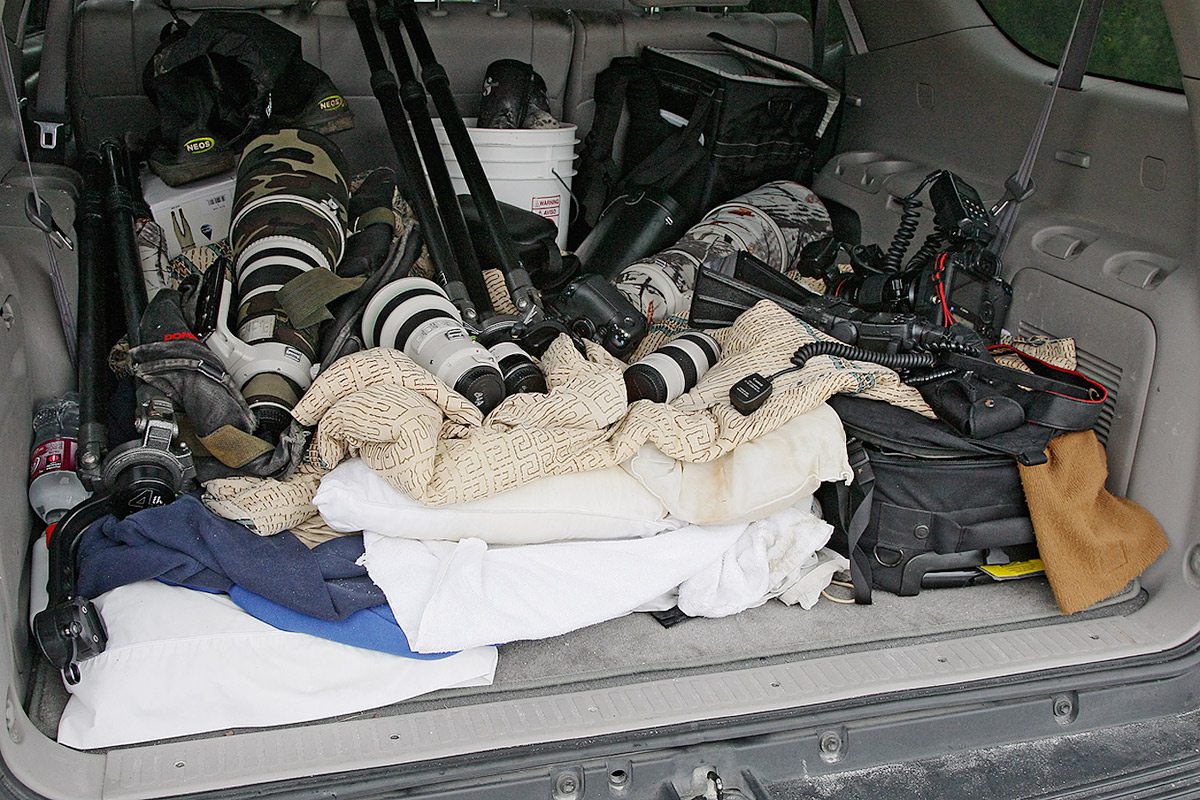
|
|
This image shows my gear in the back of my Toyota Sequoia in 2008. When I am photographing from the car it looks much the same today but for a different set of lenses and bodies.
Do understand that making good photographs has much more to do with what is in your head, your heart, your soul, and your gut–can you say “determination”? than it has to do with what’s in your gear bag….
|
Big Lens Choices for Canon and Nikon–As I See Them….
The 600 & 800mm Lenses
If you love to do birds, especially small wild birds, and especially birds that are ridiculously tame, and you are capable of carrying a heavy lens and are willing to work on a sturdy tripod nearly all of the time, your choices are fairly obvious. You will want either a 600mm f/4L IS or VR lens or the 800mm f/5.6L IS or VR lens.
Here are the basics for these great lenses:
Canon EF 600mm f/4L IS II USM lens
Weight: 8.65 lbs Current B&H price: $12,799
Nikon AF-S NIKKOR 600mm f/4G ED VR AF lens
Weight: 11.16 lbs Current B&H price: $9,799
Analysis: aside from price, the advantage goes to Canon. Most folks will overlook the following: many Canon users (including and especially me) successfully use the Canon 2x EF Extender III (teleconverter) with their f/4 super-telephoto lenses. Very few Nikon folks have had success using the Nikon TC-20E III 2x Teleconverter for AF-S & AF-I lenses with their big lenses. Nearly all report sharpness issues. Most but not all Nikon folks who use the Nikon TC-17E II 1.7x Teleconverter for AF-S & AF-I lenses have no trouble creating sharp images with the 1.7 TCE. For folks with excellent sharpness techniques the huge advantage here goes to Canon as 1,200mm is a far cry from either 840mm or 1020mm….
Canon EF 800mm f/5.6L IS USM Autofocus ens
Weight: 9.86 lbs Current B&H price: $13,249
Nikon AF-S NIKKOR 800mm f/5.6E FL ED VR lens
Weight: 10.12 lbs Current B&H price: $17,896.95
Analysis: I loved my Canon 800 for its incredible sharpness, fast focusing, and the great 4-stop IS system. I have never seen a Nikon 800mm or spoken to anyone who owns a copy; though the prices seems prohibitive I am sure that it is a killer lens. I eventually sold my 800 as the 600 II used with either TC gave me much more versatility. For more on the topic of 600 vs. 800 click here or here.
The 500mm f/4 Lenses
Those who want a long super-telephoto lens, would like to hand hold all or some of the time, and know that a 600mm is not right for them, need to consider one of the great 500mm f/4 lenses.
Canon EF 500mm f/4L IS II USM lens
Weight: 7.04 lbs Current B&H price: $10,399
Nikon AF-S NIKKOR 500mm f/4G ED VR II AF lens (Black)
Weight: 8.54 lbs Current B&H price: $8,399
Analysis: again the price advantage goes to Nikon but it is all downhill from there. With Canon’s 1 1/2 pound weight advantage comes easier hand hold-ability. And again the Canon’s 2X TC sharpness superiority comes into play. Remember that the size of the subject in the frame is a function of the square of the focal length….
The 500mm f/4 super-telephotos have long been extremely popular choices.
The 400mm f/2.8 Lenses
Though the current Canon and Nikon versions are super sharp I have long dismissed the 400 f/2.8 lenses as being a great choice as a prime lens for bird photography. They are great lenses for folks who do large mammals (think out west or Africa for starters) or for folks who do lots of close range work at bird feeders but for most bird photographers choosing a 400 f/2.8 as their workhorse super-telephoto lens simply does not make sense to me.
Just for the record books:
Canon EF 400mm f/2.8L IS II USM lens
Weight: 8.49 lbs Current B&H price: $10,999
Nikon AF-S NIKKOR 400mm f/2.8G ED VR AF lens (Black)
Weight: 10.16 lbs Current B&H price: $8,999
Analysis: again the price advantage goes to Nikon but again it is all downhill from there. With Canon’s more than 1 1/2 pound weight advantage comes easier hand hold-ability. And again the Canon’s 2X TC sharpness superiority comes into play.
The 200-400 f/4 and the 300mm f/2.8 Lenses
If you like to do birds and if you like to hand hold and/or if you travel to places with lots of tame birds and large and small wildlife, then one of the two lenses in this group might be perfect for you. Let’s take a look.
Canon EF 200-400mm f/4L IS USM Lens with Internal 1.4x Extender
Weight: 7.98 lbs Current B&H price: $11,799
Nikon AF-S NIKKOR 200-400mm f/4G ED VR II Lens
Weight: 7.4 lbs Current B&H price: $6,749
Analysis: In spite of the small weight advantage and huge price advantage for Nikon, I still have to give the nod to the Canon 200-400 solely because of the revolutionary (at least for a dSLR lens) Built-in 1.4X Extender technology. From my Canon Digital Learning Center Focus On feature here:
There are many advantages to the internal TC. At about one second, set up is nearly instantaneous. For really skilled folks who store their TCs in a pocket without the front and rear caps, adding or removing an external TC might take as little as 10 seconds. Otherwise, 30 to 60 seconds or more would be the norm for most. You can add another 10 seconds or so for those who, as they should, turn the camera off and on to prevent dust from entering the system. With the internal TC, dust is of no concern at all. After working with the lens for an hour or two, sliding the lever down to engage the internal TC became second nature; the lever mechanism is smooth and painless. There is also a locking mechanism that some might find useful. I never use it and when I hit it accidentally and do not realize it, I find myself wishing that it was not there. Additionally, there is no need to rebalance the lens in the clamp as you should do when adding or removing an external TC; that saves another 10-15 seconds.
In the wildlife photography sense of time, even fractions of a second can be of huge importance. When a safari vehicle comes to a quick stop, you need to be ready to shoot now. Anticipating the framing is done as you are approaching the animal; the time saved by being able to simply flick the lever, as compared to adding or removing an external TC, is often the difference between making a great image and walking away empty handed. Being able to go wide in an instant allows you to create small in the frame/environmental type images without having to bother to change lenses.
In short, the EF 200-400mm f/4 L IS USM Extender 1.4x’s internal TC is a huge advantage.
Canon EF 300mm f/2.8L IS II USM lens
Weight: 5.19 lbs Current B&H price: $6,799
Nikon AF-S NIKKOR 300mm f/2.8G ED VR II lens
Weight: 6.39 lbs Current B&H price: $5,799
Analysis: With the two Canon lenses here the 200-400 had the edge over the 300 in terms of versatility and maximum reach (784mm with both the internal and an external 1.4X TC > 600mm) but the 300 has a substantial weight advantage and is much more easily hand held than the 2-4. That said, despite the fact that the 200-400 weighs nearly a pound more than the 500 II and only 2/3 of a pound less than the 600 II, I find that the 2-4 is much easier to hand hold than the 500 II because of its smaller overall size and its more compact design. But the lighter weight and ease of hand holding may be the deciding factor for those who for a variety of reasons choose not to go the 500/600 f/4 route. Do understand that as much as I love the 200-400 that I do not bring it with me on all trips. On most trips where I need the reach of the 600II/2X III TC the 2-4 stays in the air conditioned garage….
With Nikon the analysis is similar and the lack of an internal TC does not make much of a difference for folks who are committed to the black side. The 1.2 pound weight advantage for the 300 makes it the clear choice for those who do lots of hand held flight photography. The Nikon 200-400 is a great lens for Africa whether or not you travel with a super-telephoto lens. And, just as the Canon 200-400, it would serve folks well on Galapagos or Southern Oceans trips.
Questions?
As always, folks with specific gear questions are invited to shoot me an e-mail.
Canon/Nikon Rejoinder II
As above, before the Nikon folks go off on a big rant I need them to understand that both systems are superb, that good photographers make good images with whatever gear they have in their hands, that great photographers make great images with whatever gear they have in their hands, and that two of my best friends and two of the most talented photographers that I know use Nikon gear. Below I attempt to be as honest and as objective as possible. I am fine if you wish to disagree with me by leaving a civil comment. 🙂
Canon Lens Specifications
Canon folks are invited to click here for a chart that contains most of the relevant specifications for big lenses including all of the original (i.e., older) super-telephotos.
Bosque IPTs/Late Registration Discounts Increased
It’s Getting Late!
For information on both the 7-Day and the recently announced short version of the 2013 Bosque IPTs please scroll down here. If you would like to join us for the first 3 or 4 days of this IPT please shoot me an e-mail. Please call Jim at 863-692-0906 or e-mail for late registration discount info.
BIRDS AS ART 2nd International Bird Photography Competition
Learn more and enter the BIRDS AS ART 2nd International Bird Photography Competition here. Twenty-five great prizes including the $1000 Grand Prize and intense competition. Bring your best.
2014 Tanzania Summer Safari
If you are interested in joining us in Tanzania next summer please shoot me an e-mail and I will be glad to forward you the PDF with dates, itinerary, and price.
Support the BAA Blog. Support the BAA Bulletins: Shop B&H here!
We want and need to keep providing you with the latest free information, photography and Photoshop lessons, and all manner of related information. Show your appreciation by making your purchases immediately after clicking on any of our B&H or Amazon Affiliate links in this blog post. Remember, B&H ain’t just photography!




Amazon
Everyone buys something from Amazon, be it a big lens or deodorant. Support the blog by starting your search by starting your search by clicking on the logo-link below. No purchase is too small to be appreciated; they all add up. Why make it a habit? Because I make it a habit of bringing you new images and information on an almost daily basis.
Typos
In all blog posts and Bulletins feel free to e-mail or leave a comment regarding any typos, wrong words, misspellings, omissions, or grammatical errors. Just be right. 🙂
IPT Info
Many of our great trips are filling up. You will learn more about how to make great images on a BAA IPT than anywhere else on the planet. Click here for the schedule and additional info.
November 17th, 2013
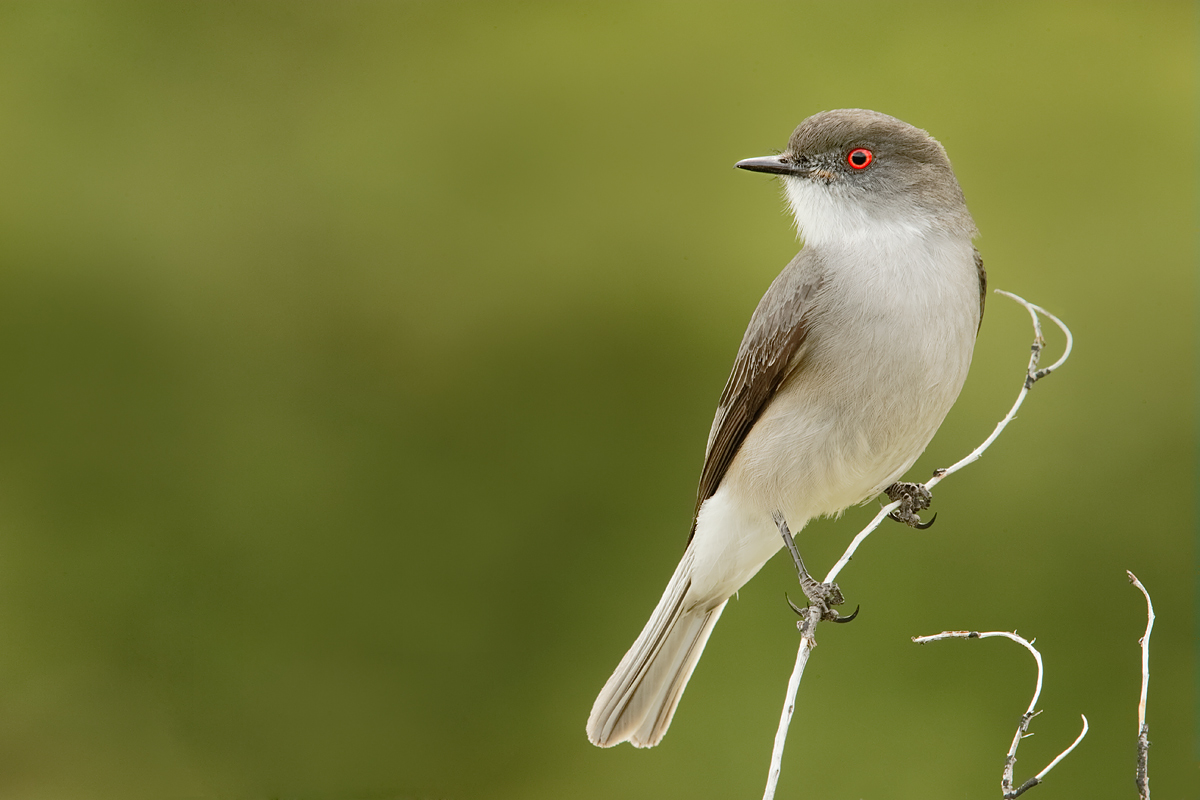
|
|
The image was created in Paine del Torres National Park, Chile with the Gitzo 3532 LS carbon fiber tripod, the Mongoose M3.6 head, the Canon EF 600mm f/4L IS II USM lens, the Canon 2x EF Extender III (Teleconverter), and the Canon EOS-1D X. ISO 800. Evaluative metering a zero (in bright overcast): 1/125 sec. at f/13 in Manual mode.
Central sensor (by necessity) Expand/AI Servo Rear Focus AF on the bird’s eye and re-compose. Click here to see the latest version of the Rear Focus Tutorial. Click on the image to see a larger version.
Note that if the sun had been out at full strength that I would have needed to go to -1/3 stop to keep from burning the white throat. It takes some guts to re-compose so drastically but this bird usually stayed very still on the perch for more than a few seconds so I decided to go for the best composition with the bird looking towards the empty part of the frame. Note also that for this pose with the bird facing but angled towards us that the head angle, perfectly square to the imaging sensor, is ideal.
|
Torres del Paine Tyrant Flycatcherss, Audio Playback in South America, Manual Exposure Tip, and More…
Torres del Paine Tyrants
Both species featured in today’s blog post are tyrant flycatchers, in the same family as our Great-crested Flycatcher, all the peewees and phoebes, all the kingbirds, all of the smaller empidonax flycatchers, and many additional genera. Though they are confined to the Americas, the tyrant flycatchers are the largest bird family in the world.
Audio Playback in South America
The use of audio playback is often a controversial topic in North America and is usually considered taboo in the UK (by conversation with David Tipling) and the rest of Europe (personal knowledge), is standard operating procedure in most of South America with most birders and bird photographers. Even beginning birders are never in the field without their cell phones with all the birds songs on them. Many employed more sophisticated devices. As it states in APB II I am fine with the judicious use of audio recordings to entice birds into viewing and photographic range. Audio playback was used for that purpose with both of the birds featured in this blog post (though not by me; I rarely if ever use playback),
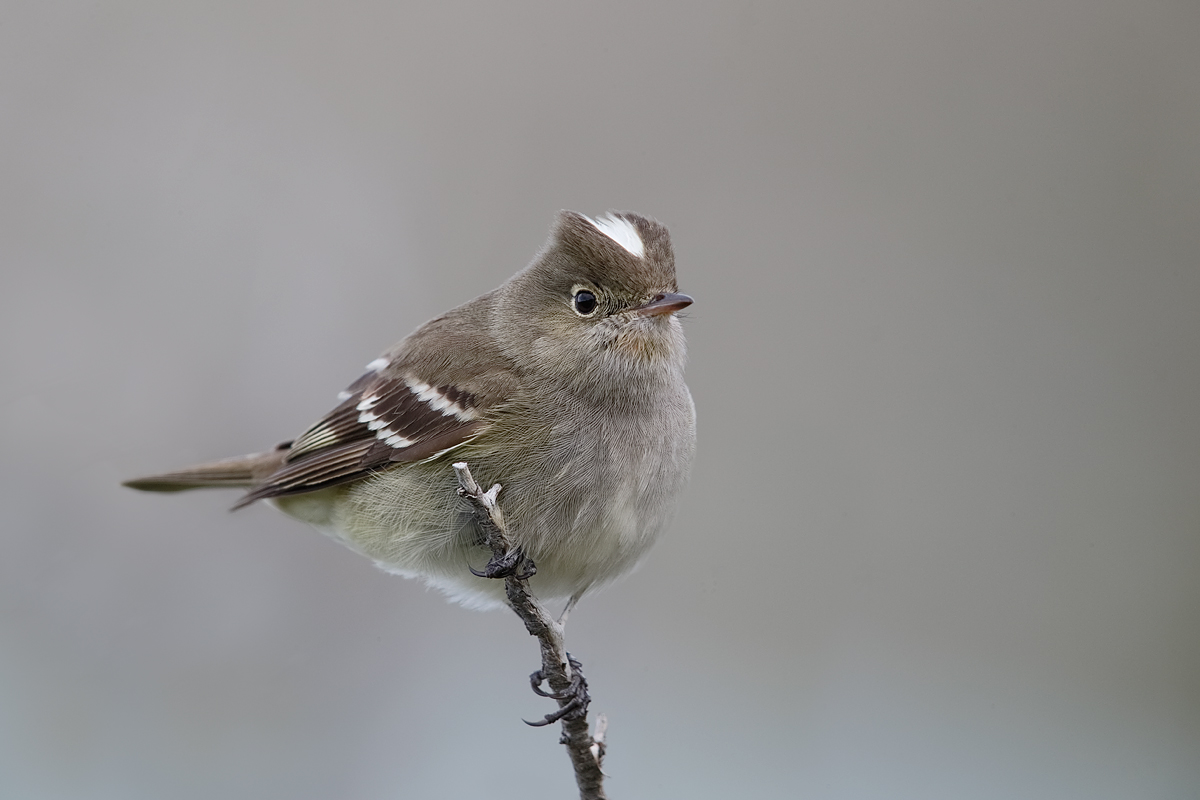
|
|
The White-crested Elaenia image was created at EcoCamp Patagonia in Paine del Torres National Park, Chile with the Gitzo 3532 LS carbon fiber tripod, the Mongoose M3.6 head, the Canon EF 600mm f/4L IS II USM lens, the Canon 2x EF Extender III (Teleconverter), and the Canon EOS-1D X. ISO 800. Evaluative metering +1/3 stop: 1/250 sec. at f/11 in Av mode.
Central sensor (by necessity) Expand/AI Servo Rear Focus AF on the right side of the bird’s neck just below the eye active at the moment of exposure. Click here to see the latest version of the Rear Focus Tutorial. Click on the image to see a larger version.
This species is notorious for responding eagerly to audio playback. Note that with the soft light and the lighter than middle-toned background that I was working in Av mode; I was sure that +1/3 stop exposure compensation would yield a perfect exposure. I was right.
|
Alan Murphy Guides and Audio Playback
Alan’s second e-Guide details the proper use of audio playback. In his first guide, Guide to Songbird Set-Up Photography (106 pages), he taught the world to create killer images at backyard set-ups. In his second e-Guide, “The Photographer’s Guide to Attracting Birds,” Alan expanded upon topics covered in the fist guide and added new methods and techniques as well. As I proofread this new e-Book for readability, I was amazed not only by the images, but by Alan’s innovative and creative techniques. Heck, in many cases, I was stunned by his cleverness. To learn more about the creation of Alan’s 2nd great eBook, click here. This great eGuide is available by download for $50. Click on the link below to get your copy. (PayPal payments are accepted.)

Note: those who would like to purchase both books via download can click on the link immediately above and save $10 on the combo.
Manual Exposure Tip: A Very Fine Point
For the opening image I was working in Av mode. Again, with the soft light and the lighter than middle-toned background that I was working in Av mode, sure that +1/3 stop exposure compensation (EC) would yield a perfect exposure. When the bird perched against the white sky I could have gone to lots of plus EC, probably +3 or more stops off the sky. Instead, I took the exposure values from the blog-opening image with the light grey background and increased the shutter speed by 1 click from 1/250 sec. to 1/320 sec. Why? Because I believe that there is a bit more light falling on a subject set against a bright sky (or a bird in flight) than there is falling on a subject in a bush. Why? My reasoning is that the vegetation absorbs some of the light that would otherwise be falling on the subject. Does this explanation hold water to a physicist? Probably not, but the method works….
Fire-eyed Diucon Image Clean-up & Optimization
Take a moment to let the animated GIF above play. Let us know the major changes that you see. There are at least five major changes. Image clean-up was done with a series of Quick Masks, Protect and defend cloning on a layer, divide and conquer, the Patch Tool, the Clone Stamp, the Spot Healing Brush, and my NIK Color Efex Pro 50-50 custom filter (at 33% opacity).
All of the above is described in detail in our in Digital Basics File, an instructional PDF that is sent via e-mail. It includes my complete digital workflow, dozens of great Photoshop tips, several different ways to expand canvas, all of my time-saving Keyboard Shortcuts, Quick Masking, Layer Masking, and NIK Color Efex Pro basics, image clean-up techniques, Digital Eye Doctor, and tons more.
From Soup to Nuts
From soup to nuts this blog post took more than four hours to prepare. I started at 4:30am and finished at about 9:15am. Breakfast included. The info presented here is posted free for all to enjoy and learn from. We ask that folks make their major and minor purchases using the B&H and Amazon affiliate links below and to the right of all blog posts. Many thanks for considering that request.
Image Questions
Which of the three images is your favorite? Be sure to let us know why. Which of the two White-eyed Elania images is the weaker of the two. Be sure to let us know why. I am interested in hearing what folks think is the single major problem.
Bosque IPTs/Late Registration Discounts Increased!
For information on both the 7-Day and the recently announced short version of the 2013 Bosque IPTs please scroll down here. If you would like to join us for the first 3 or 4 days of this IPT please shoot me an e-mail. Please call Jim at 863-692-0906 or e-mail for late registration discount info.
BIRDS AS ART 2nd International Bird Photography Competition
Learn more and enter the BIRDS AS ART 2nd International Bird Photography Competition here. Twenty-five great prizes including the $1000 Grand Prize and intense competition. Bring your best.
2014 Tanzania Summer Safari
If you are interested in joining us in Tanzania next summer please shoot me an e-mail and I will be glad to forward you the PDF with dates, itinerary, and price.
Support the BAA Blog. Support the BAA Bulletins: Shop B&H here!
We want and need to keep providing you with the latest free information, photography and Photoshop lessons, and all manner of related information. Show your appreciation by making your purchases immediately after clicking on any of our B&H or Amazon Affiliate links in this blog post. Remember, B&H ain’t just photography!




Amazon
Everyone buys something from Amazon, be it a big lens or deodorant. Support the blog by starting your search by starting your search by clicking on the logo-link below. No purchase is too small to be appreciated; they all add up. Why make it a habit? Because I make it a habit of bringing you new images and information on an almost daily basis.
Typos
In all blog posts and Bulletins feel free to e-mail or leave a comment regarding any typos, wrong words, misspellings, omissions, or grammatical errors. Just be right. 🙂
IPT Info
Many of our great trips are filling up. You will learn more about how to make great images on a BAA IPT than anywhere else on the planet. Click here for the schedule and additional info.
November 16th, 2013
“Editing Practice/Yellow-billed Pintail: Keep One or Both?” Update and Reasoning
In the November 9, 2013 blog post (Editing Practice/Yellow-billed Pintail) here, folks were asked, “keep One or both?”
At first glance I was sure that the answer was Image B for the reasons given by multiple IPT veteran Alan Lillich (along with lovely wife Pat) who wrote in part, I would keep the second one. The bird’s pose and sharpness is the same in both. The second has a little more room above the head to the dark line of water. It also has more room to the first dark dot in front of the bird, more comfortable cloning space for me. I would crop it into a pano. Cut off the left just in front of the leftmost dark dot that the tail points to. Cut off the bottom just above the higher bit of reflection showing some yellow. Cut off the top just below the upper dark water, keeping the lowest semi-dark line and some lighter above it. Take nothing off the right, I like the circular waves.
But, however, a funny thing happened on the way to the Phorum. (Note: Phorum is not a typo :)).
After taking a close look at the two images, I realized that I liked the taller head and the elongated neck better in Image A as suggested by Ken Kovak who swam against the tide when he wrote (again in part), I am going to go against the trend of what is posted so far and select the first image. What decided for me is in the first(number 2894)image the duck’s neck is slightly more elongated and pleasing to me.
The Image Optimization
To create the optimized image that opens this blog post I went with image A and used the Patch Tool and the Clone Stamp Tool at 40% hardness to eliminate all the cruddy brown spots. You can check out the clean-up work and the crop in the animated GIF above. Be sure to give it a few moments to play.
Though Alan Lillich’s suggested crop would have worked well, I decided to place the bird near the upper left third because I really liked the white swirlies along the lower frame edge. The crop therefore, was from the left and the top.
All of my clean-up tools and techniques are described in detail in our in Digital Basics File, an instructional PDF that is sent via e-mail. It includes my complete digital workflow, dozens of great Photoshop tips, several different ways to expand canvas, all of my time-saving Keyboard Shortcuts, Quick Masking, Layer Masking, and NIK Color Efex Pro basics, and tons more.
Insane Deal on One of My Very Favorite Lenses
This amazing offers expires soon!
Right now B&H is offering one of my very favorite lenses, the Canon EF 70-200mm f/2.8L IS II USM lens, at the ridiculously low price of only $1899.00 The regular price is $2499.00. They are offering a limited quantity as follows: after clicking on one of the BAA affiliate links here proceed to checkout to receive the $2199.00 price. Follow that up with the mail-in-rebate $300.00. When the smoke clears you will own this great lens for only $1899. The rebate is good only for US purchasers. The $1899 is the lowest ever price anywhere. Get one today and earn a free contest entry.
Note: the rebate is good only for US purchasers. If you missed this blog post, ” Scenic, Wildlife, & B-roll Versatility,” click here. It featured a variety of images created at Torres del Paine with my 70-200 II,
I have this lens with me on every trip. I use it as above for scenics and habitat images. I use it to create bird scapes and images of groups of birds, for flight images of single birds with either TC and often with the 1.4X III TC for flocks in flight and for blast off blurs. It is a great travel and all purpose nature and wildlife lens. It is rare that I am in the field without having the 70-200 II on my shoulder via the Black Rapid S-7 strap.
…..
Bosque IPTs/Late Registration Discounts Increased!
For information on both the 7-Day and the recently announced short version of the 2013 Bosque IPTs please scroll down here. If you would like to join us for the first 3 or 4 days of this IPT please shoot me an e-mail. Please call Jim at 863-692-0906 or e-mail for late registration discount info.
BIRDS AS ART 2nd International Bird Photography Competition
Learn more and enter the BIRDS AS ART 2nd International Bird Photography Competition here. Twenty-five great prizes including the $1000 Grand Prize and intense competition. Bring your best.
2014 Tanzania Summer Safari
If you are interested in joining us in Tanzania next summer please shoot me an e-mail and I will be glad to forward you the PDF with dates, itinerary, and price.
Support the BAA Blog. Support the BAA Bulletins: Shop B&H here!
We want and need to keep providing you with the latest free information, photography and Photoshop lessons, and all manner of related information. Show your appreciation by making your purchases immediately after clicking on any of our B&H or Amazon Affiliate links in this blog post. Remember, B&H ain’t just photography!




Amazon
Everyone buys something from Amazon, be it a big lens or deodorant. Support the blog by starting your search by starting your search by clicking on the logo-link below. No purchase is too small to be appreciated; they all add up. Why make it a habit? Because I make it a habit of bringing you new images and information on an almost daily basis.
Typos
In all blog posts and Bulletins feel free to e-mail or leave a comment regarding any typos, wrong words, misspellings, omissions, or grammatical errors. Just be right. 🙂
IPT Info
Many of our great trips are filling up. You will learn more about how to make great images on a BAA IPT than anywhere else on the planet. Click here for the schedule and additional info.
November 14th, 2013
Pretty Boring, But Can You See the Potential?
In the field, backlit animal in life looked a bit more dramatic. But it is important to get the right exposure even if doing so results in an image that looks washed out on the rear LCD. With digital, the photographer must learn to realize the potential in their RAW captures.
What is the right exposure in backlit situation? One that yields only a very few blinkies on the rim light. That is exactly what I did with all of the images in today’s post.
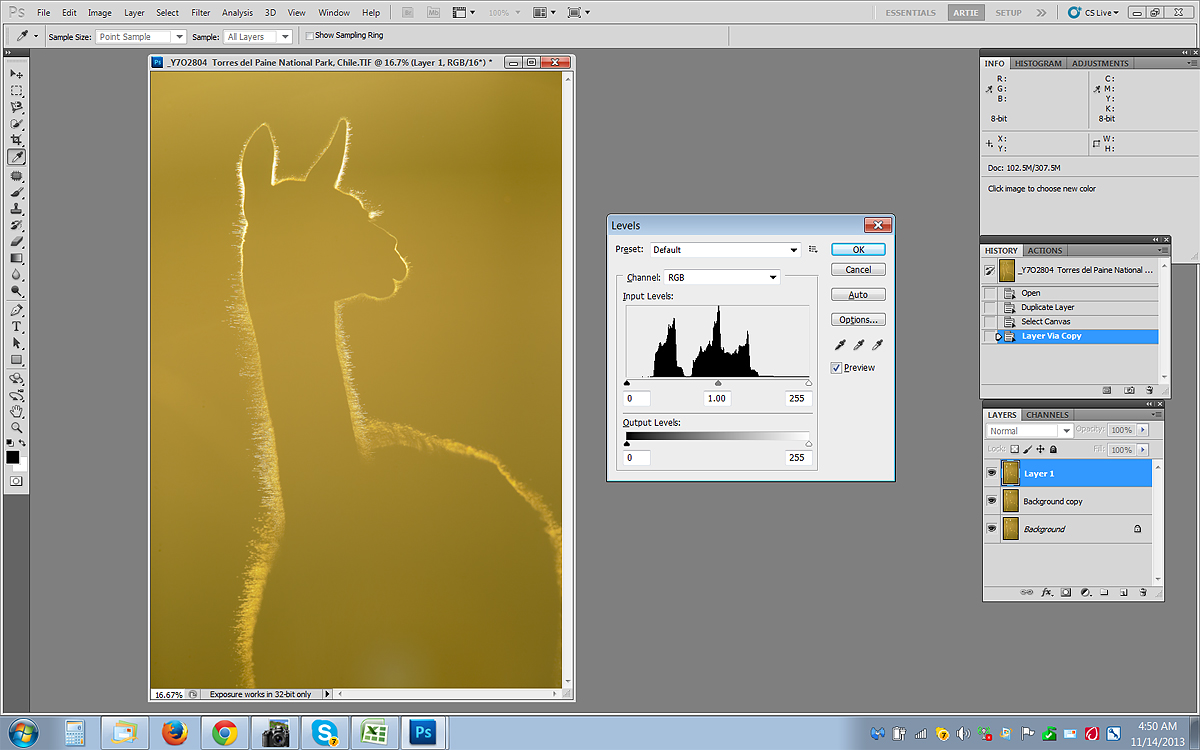
|
|
This is the” Before” Photoshop 5 screen capture showing the converted image and the open Levels dialogue box. Click on the image to enlarge it and take a close look at the three Levels sliders.
|
The RAW Conversion
I do all of my RAW conversions in DPP, Canon’s Digital Photo Professional. First I darkened the image by mowing the Brightness slider to the left and then recovered the remaining few areas shown in red by DPP’s Highlight Alert (Alt M). Next I upped the Color Saturation considerably to enhance the color of the rim light.
Again, enlarge the image and take a close look at the three Levels sliders.
You can learn why and how I use DPP to convert all of of my Canon RAW files by clicking here.
and getting yourself a copy of our DPP RAW Conversion Guide.
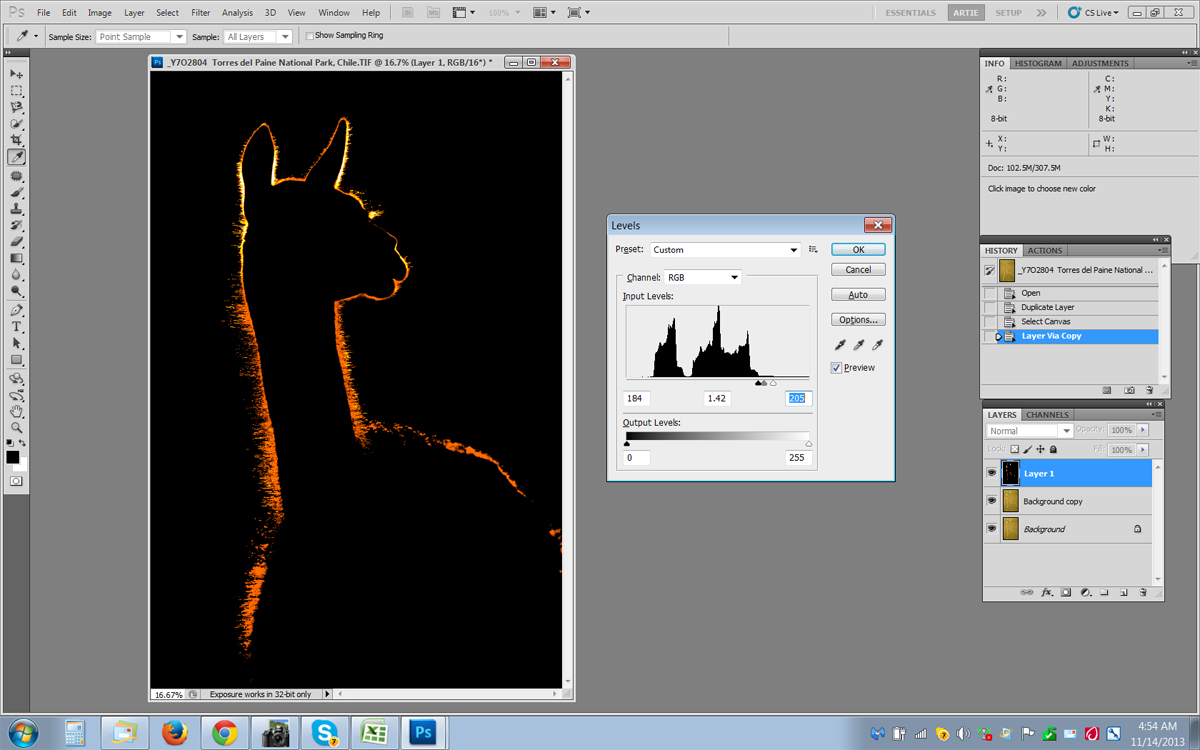
|
|
This is the “After” Photoshop screen capture. Be sure to enlarge the image and take a close look at the three Levels sliders: Shadow on the left, Midtone in the middle of course, and Highlight on the right.
|
Using A Levels Adjustment to Create Black-lit Magic
Normally, we set the Black point by holding down the ALT key and moving the Shadows slider to the right until the first areas of color appear. Then we back off a bit. Then we’d set the White point by holding down the ALT key and moving the Highlight slider to the left until the first areas of color appear. And then again, we’d back off a bit. Lastly we would adjust the Midtone slider to taste.
But that is not what you do when you wish to create a Black-lit Magic image. First we hold down the ALT key and move the Shadow slider to the right until all of the image except for the rim lighting turns completely black. Doing so will darken the rim lit areas. Next move the Midtone slider to the left so that it is very close to the Shadow slider. Finally move the Highlight slider to the left to brighten the rim light. Lastly you may wish to tweak the position of each slider to get exactly what you want.
All of the above as described in detail in our in Digital Basics File, an instructional PDF that is sent via e-mail. It includes my complete digital workflow, dozens of great Photoshop tips, several different ways to expand canvas, all of my time-saving Keyboard Shortcuts, Quick Masking, Layer Masking, and NIK Color Efex Pro basics, and tons more.
The Optimized Image
The optimized image is a far cry from the look of the original.
Thanks to Andy Rouse for his black-light inspiration. I believe that first learned of the term in his great hardcover book, Concepts of Nature: A Wildlife Photographer’s Art 
 
Backlit Vegetation Adds
This was the first image that I created as I set out up the hill to create the images in this series. The knee is doing great thank you very much. The sparkling backlit vegetation adds a lot to the impact.
Getting Closer
Careful readers will note that all of the images here were created with the same focal length set-up, the 600II, the 1.4X III, and the full frane 1D X: 840mm. I achieved a variety of compositions by moving physically, i.e,. getting closer, aka human zoomin’ and by rotating the lens in the tripod collar to switch from horizontal to vertical format.
The End and a Question or Two
There is lots of stuff of interest here and lots more to learn. As the sun was getting lower in the western sky and just cresting the hill in front of me note that light levels were also getting much lower. Note also that for the last two image the active AF sensor was on part of the animal and not on the rim light. With little to no contrast on the animal’s face or body what is the trick to acquiring and maintaining focus in such situations?
Note also that by not raising the color temperature and by not increasing the Saturation that the rim light is pretty much white. Which rim light do you like better? Why?
Your Favorite Image?
Please take a minute to let us know which of the four black-lit Guanaco image is your favorite. And do let us know why.
Insane Deal on One of My Very Favorite Lenses
Right now B&H is offering one of my very favorite lenses, the Canon EF 70-200mm f/2.8L IS II USM lens, at the ridiculously low price of only $1899.00 The regular price is $2499.00. They are offering a limited quantity as follows: after clicking on one of the BAA affiliate links here proceed to checkout to receive the $2199.00 price. Follow that up with the mail-in-rebate $300.00. When the smoke clears you will own this great lens for only $1899. The rebate is good only for US purchasers. The $1899 is the lowest ever price anywhere. Get one today and earn a free contest entry.
Note: the rebate is good only for US purchasers. If you missed yesterday’s blog post,” Scenic, Wildlife, & B-roll Versatility” click here. It featured a variety of images created at Torres del Paine with my 70-200 II,
I have this lens with me on every trip. I use it as above for scenics and habitat images. I use it to create bird scapes and images of groups of birds, for flight images of single birds with either TC and often with the 1.4X III TC for flocks in flight and for blast off blurs. It is a great travel and all purpose nature and wildlife lens. It is rare that I am in the field without having the 70-200 II on my shoulder via the Black Rapid S-7 strap.
…..
Bosque IPTs/Late Registration Discounts Increased!
For information on both the 7-Day and the recently announced short version of the 2013 Bosque IPTs please scroll down here. If you would like to join us for the first 3 or 4 days of this IPT please shoot me an e-mail. Please call Jim at 863-692-0906 or e-mail for late registration discount info.
BIRDS AS ART 2nd International Bird Photography Competition
Learn more and enter the BIRDS AS ART 2nd International Bird Photography Competition here. Twenty-five great prizes including the $1000 Grand Prize and intense competition. Bring your best.
2014 Tanzania Summer Safari
If you are interested in joining us in Tanzania next summer please shoot me an e-mail and I will be glad to forward you the PDF with dates, itinerary, and price.
Support the BAA Blog. Support the BAA Bulletins: Shop B&H here!
We want and need to keep providing you with the latest free information, photography and Photoshop lessons, and all manner of related information. Show your appreciation by making your purchases immediately after clicking on any of our B&H or Amazon Affiliate links in this blog post. Remember, B&H ain’t just photography!




Amazon
Everyone buys something from Amazon, be it a big lens or deodorant. Support the blog by starting your search by starting your search by clicking on the logo-link below. No purchase is too small to be appreciated; they all add up. Why make it a habit? Because I make it a habit of bringing you new images and information on an almost daily basis.
Typos
In all blog posts and Bulletins feel free to e-mail or leave a comment regarding any typos, wrong words, misspellings, omissions, or grammatical errors. Just be right. 🙂
IPT Info
Many of our great trips are filling up. You will learn more about how to make great images on a BAA IPT than anywhere else on the planet. Click here for the schedule and additional info.
November 13th, 2013
Scenic Image Versatility
Wherever on the planet I am photographing I find the Canon EF 70-200mm f/2.8L IS II USM lens to be a perfect adjunct to whatever big lens I am using. It fits perfectly with the 500mm II/a>, the 600II, and with the 200-400 with Internal 1.4X TC.
The image above shows the three Paine Towers with Condor Nest on our right. The towers are one of the park’s two iconic formations. We stopped when we noticed a bit of golden light on the two left-hand towers. While wide angle lenses often work well for landscape photography (see here) I often go to an intermediate telephoto lens to achieve much tighter and often more dramatic and detail revealing framing. That the 70-200 is capable of creating professionally sharp images with either the 1.4X III or the 2X III TC makes this fast lens even more versatile.
The image above was created from one of the RAW files that went into creating an in-camera HDR Art Vivid JPEG; I went with the RAW for two reasons: the color in the Art Vivid JPEG was a bit over the top and hand holding in the high winds resulted in a fine black outlining of the peaks. I used both Color Efex Pro and Viveza to punch up the image while trying to avoid over-doing things. I am happy with the result.
You can learn everything that you need to know about creating in-camera HDRs and Multiple Exposures with your 5D III in our 5D Mark III User’s Guide. This great e-Guide also covers all menu items and Custom Function settings, details the great AF system, and includes my custom Case setting for photographing birds in flight and in action.
HDR and 10,000 K for Black and White
On a seemingly boring white sky morning I went in tight with the 70-200/1.4X TC combo to dramatize the shapes and textures of the rocks. To get as close as possible to a B&W and to eliminate the huge blue cast of the heavily overcast morning I set the color temperature to K 10,000. I use the Q button to the right of the rear LCD screen to make color temperature and many other changes quickly and easily. Again, as described in detail in our 5D Mark III User’s Guide. And again, I used both Color Efex Pro and Viveza to enhance the tones and textures of the rocks.
Here we have a good view of Los Cuernos, “The Horns,” the park’s other iconic rock formation. One of our two guides, Cristina Trugeda, let us know that the dark rock is sedimentary rock and that the lighter rock is granite. As the shutter speed for the lightest image here was 1/30 sec. being on a tripod was mandatory to prevent any outlining problems caused by misalignment. Note the fine high ISO performance of the 5D Mark III.
Wildlife Versatility
My standard practice is to try to have the 70-200/1.4X TC combo available whenever I am afield. While searching for subjects by vehicle in Chile this rig rested on the floor. While tooling around in my own vehicle it sits on the passenger seat. And when I am walking down a beach it hangs most times over my right shoulder via a Black Rapid S-7 strap.
Note here that by working wide open at f/4 with ISO 800 that I had enough shutter speed (1/320 sec.) so that it was not necessary to go to ISO 1600. Both Denise and I wished that we had spent more time photographing the Guanacos that are actually a type of camel. Again Cristina educated us: the Guanacos are free and wild animals from which the domesticated Llama arose. In northern Chile the free and wild Vicuna gave rise to the domesticated Alpaca.
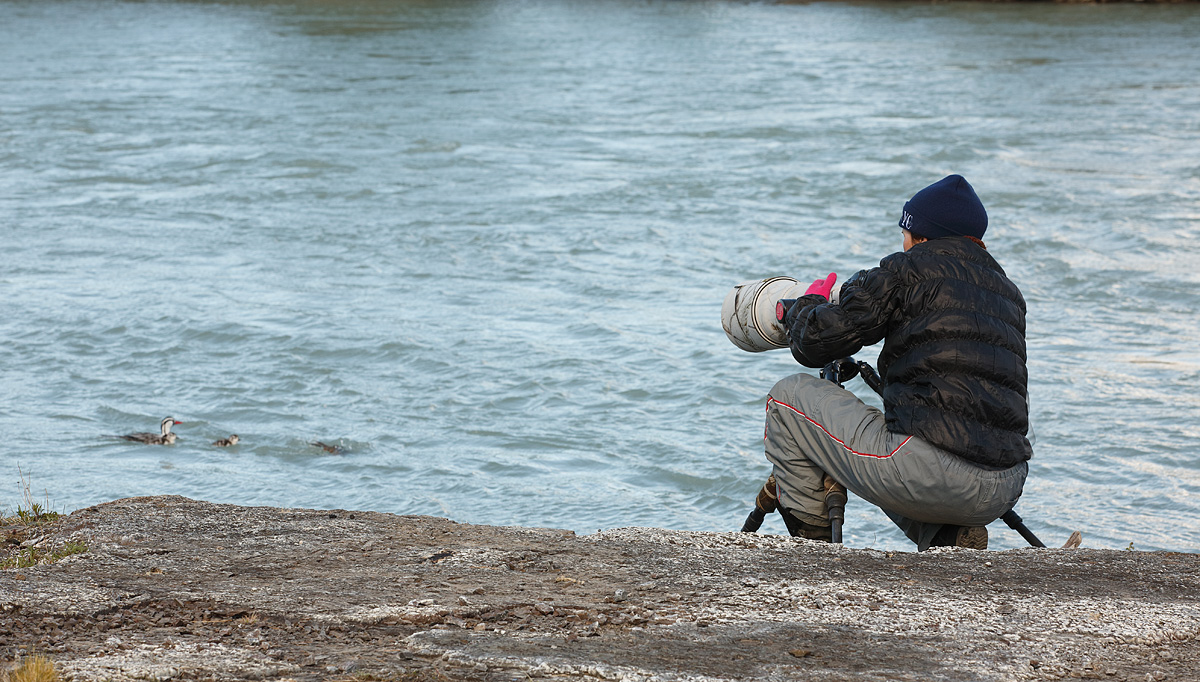
|
|
This image of Denise Ippolito at work with her 600 II was created with the hand held Canon EF 70-200mm f/2.8L IS II USM lens (at 135mm) and the Canon EOS 5D Mark III Digital camera body ISO 400. Evaluative metering +1 stop: 1/320 sec. at f/9 in Av Mode.
Image courtesy of and copyright 2013: Rodrigo Moraga.
Central sensor/AI Servo Rear Focus/Surround AF on Denise’s upper back and re-compose. Click here if you missed the latest version of the Rear Focus Tutorial. Be sure to click on the image to enjoy a larger version.
|
“B-roll Versatility”
At Torres del Paine our main focus was on birds, wildlife, and landscape photography. In the trade vernacular, anything else is B-roll stuff, images of non-target subjects that help to tell the story: people, buildings including lodges and hotels, food, vehicles, and just about anything that will help fill in the blanks. If you missed the Torrential Miracle blog post that detailed our heart-stopping experience with a beautiful family of Torrent Ducks, you can see it here. You can see Denise’s images from that memorable morning here along with a few others.
Insane Deal on One of My Very Favorite Lenses
Right now B&H is offering one of my very favorite lenses, the Canon EF 70-200mm f/2.8L IS II USM lens, at the ridiculously low price of only $1899.00 The regular price is $2499.00. They are offering a limited quantity as follows: after clicking on one of the BAA affiliate links here proceed to checkout to receive the $2199.00 price. Follow that up with the mail-in-rebate $300.00. When the smoke clears you will own this great lens for only $1899. The rebate is good only for US purchasers. The $1899 is the lowest ever price anywhere. Get one today and earn a free contest entry.
Note: the rebate is good only for US purchasers.
I have this lens with me on every trip. I use it as above for scenics and habitat images. I use it to create bird scapes and images of groups of birds, for flight images of single birds with either TC and often with the 1.4X III TC for flocks in flight and for blast off blurs. It is a great travel and all purpose nature and wildlife lens. It is rare that I am in the field without having the 70-200 II on my shoulder via the Black Rapid S-7 strap.
Image Questions
Which of the four images above is your favorite? Please let us know why you made your choice.
Bosque IPTs/Late Registration Discounts Increased!
For information on both the 7-Day and the recently announced short version of the 2013 Bosque IPTs please scroll down here. If you would like to join us for the first 3 or 4 days of this IPT please shoot me an e-mail. Please call Jim at 863-692-0906 or e-mail for late registration discount info.
BIRDS AS ART 2nd International Bird Photography Competition
Learn more and enter the BIRDS AS ART 2nd International Bird Photography Competition here. Twenty-five great prizes including the $1000 Grand Prize and intense competition. Bring your best.
2014 Tanzania Summer Safari
If you are interested in joining us in Tanzania next summer please shoot me an e-mail and I will be glad to forward you the PDF with dates, itinerary, and price.
Support the BAA Blog. Support the BAA Bulletins: Shop B&H here!
We want and need to keep providing you with the latest free information, photography and Photoshop lessons, and all manner of related information. Show your appreciation by making your purchases immediately after clicking on any of our B&H or Amazon Affiliate links in this blog post. Remember, B&H ain’t just photography!




Amazon
Everyone buys something from Amazon, be it a big lens or deodorant. Support the blog by starting your search by starting your search by clicking on the logo-link below. No purchase is too small to be appreciated; they all add up. Why make it a habit? Because I make it a habit of bringing you new images and information on an almost daily basis.
Typos
In all blog posts and Bulletins feel free to e-mail or leave a comment regarding any typos, wrong words, misspellings, omissions, or grammatical errors. Just be right. 🙂
IPT Info
Many of our great trips are filling up. You will learn more about how to make great images on a BAA IPT than anywhere else on the planet. Click here for the schedule and additional info.
November 12th, 2013
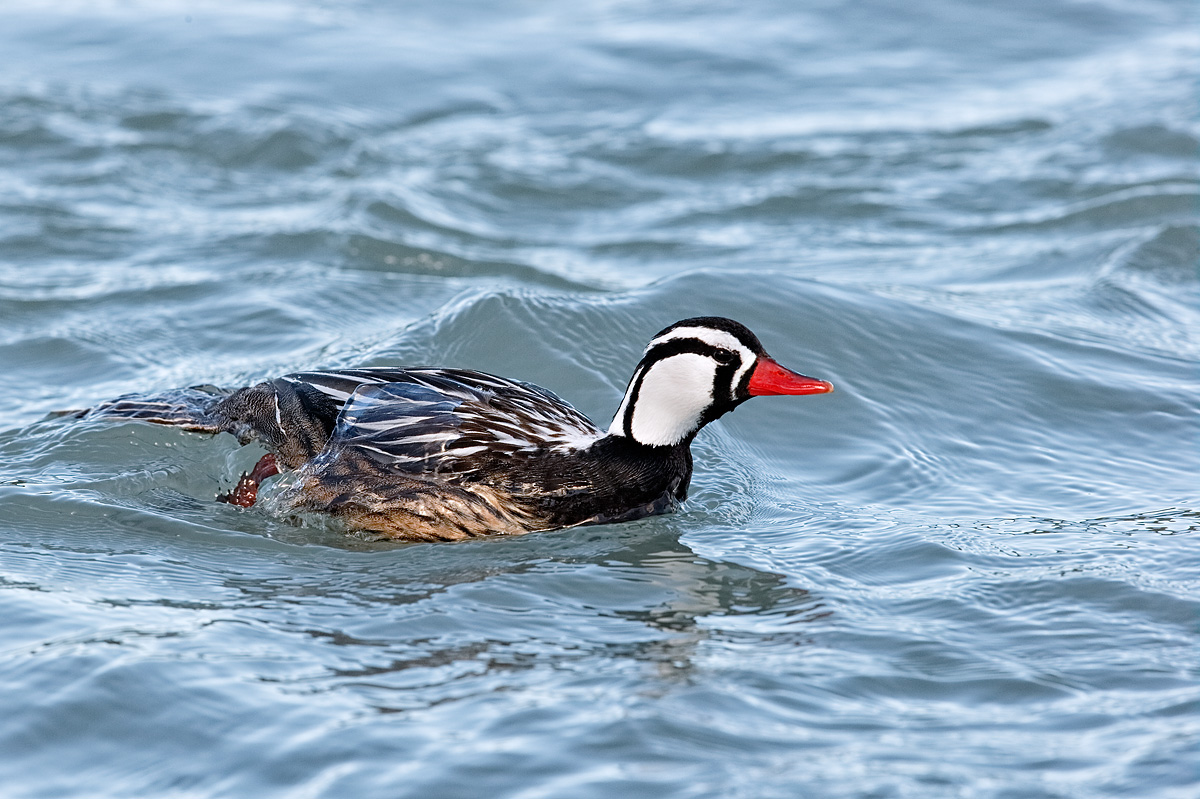
|
|
This swimming drake Torrent Duck image was created with the Gitzo 3532 LS carbon fiber tripod, the Mongoose M3.6 head, the Canon EF 600mm f/4L IS II USM lens and the Canon EOS-1D X. ISO 800. Evaluative metering +2/3 stop: 1/800 sec. at f/8 in Av mode.
One sensor to the right and one sensor below the Central sensor/Surround/AI Servo Rear Focus AF on the fold of the near wing active at the moment of exposure. Click here if you missed the latest version of the Rear Focus Tutorial. Click on the image to see a larger version.
|
Torrential Miracle
When I first met our Torres del Paine friends and guides, Rodrigo Moraga and Cristina Trugeda, Rodrigo asked, “What is your #1 most wanted bird ? “Torrent Duck,” I responded, “with chicks…” He said, “We might be able to do that.”
I could only dream….
Like our Harlequin Duck, Torrent Duck–though not closely related–is a bird of fast-moving rivers and streams. On the second morning with our skilled team, we stopped near the waterfall in front of the Paine towers to search for Torrent Duck. Within minutes Rodrigo said, “Got em, with chicks.” The family was resting on a shelf of flat rock that abutted some fast moving water. I was nervous as we approached, fearing that the ducks would simply swim quickly out of range. As we got closer, they swam off upriver. I sat, hoping that they would come back to the shelf. Denise Ippolito, Rodrigo, and Cristina circled to my left to get a bit closer to the birds that were now in the river. They had not moved too far off; they swam and dove about 15 meters from the trio of photographers, 25 meters from me.
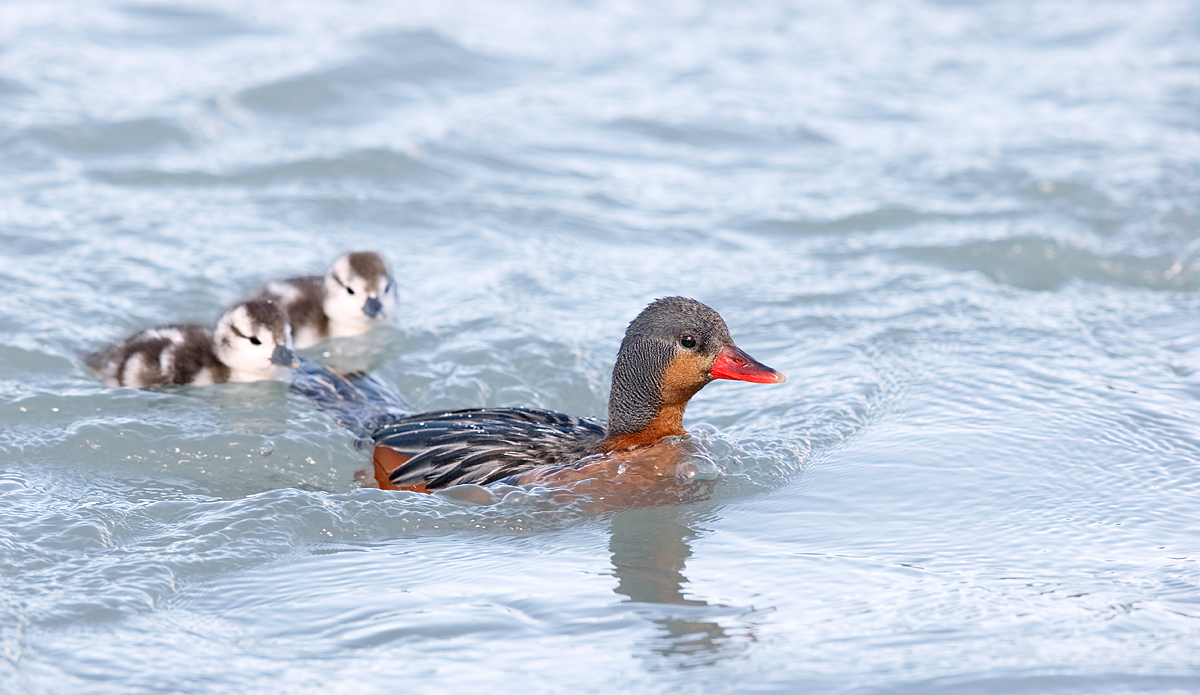
|
|
This is the hen Torrent Duck with her two chicks. The image was created with the Gitzo 3532 LS carbon fiber tripod, the Mongoose M3.6 head, the Canon EF 600mm f/4L IS II USM lens and the Canon EOS-1D X. ISO 800. Evaluative metering +2/3 stop: 1/800 sec. at f/8 in Av mode was a bit of an under-exposure as I had been set up for the drake.
One sensor to the right and one sensor below the Central sensor/Surround/AI Servo Rear Focus AF on the base of the hen’s neck active at the moment of exposure. Click here if you missed the new version of the Rear Focus Tutorial. Click on the image to see a larger version.
|
Getting Better All the Time
Within two minutes of my sitting down behind my lowered tripod the whole fam damily (note: the “whole fam damily” is not a typo. :)) began to swim back towards their resting place, the rock shelf right in front of me. My heart began to race, seemingly as fast as the rapids just to my right….
Going for the Gusto; How Good Can It Get?
As the ducklings swam slowly against the current and right at me I decided to try for an image of a single duckling so I added the 2X III TC as quickly as my fumbling fingers would allow. I created a series of about a dozen images while thinking that the coloration of the baby Torrent Ducks was reminiscent of the coloration of Emperor Penguin chicks, chicks that I have never seen and will likely never see in this lifetime.
The whole experience is one that I will remember and cherish until the box is nailed shut. Thanks a stack to Rodrigo and Cristina not only for the great family of ducks but for a wonderful six days.
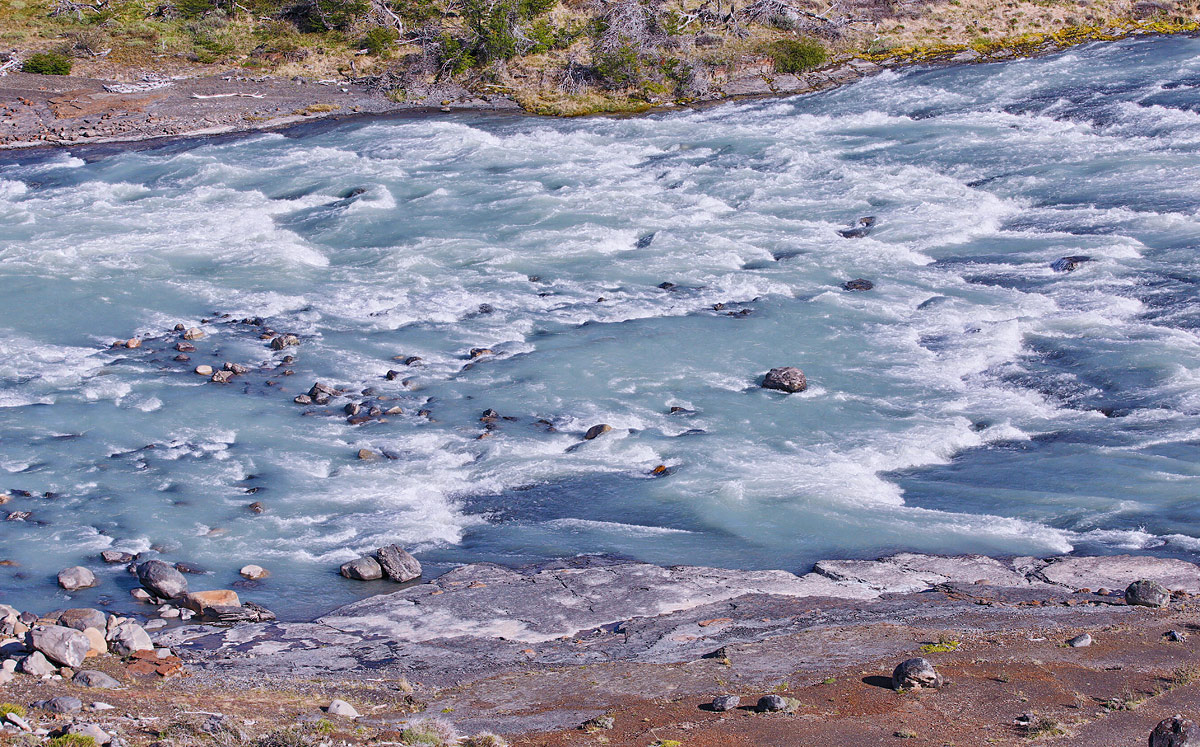
|
|
This 3-frame in-camera Natural HDR image was created at Torres del Paine National Park, Chile with the hand held Canon EF 70-200mm f/2.8L IS II USM lens, the Canon 1.4x EF Extender III (Teleconverter) (at 98mm), and the Canon EOS 5D Mark III Digital camera body ISO 400. Evaluative metering +1/3 stop yielded a base exposure of: 1/1250 sec. at f/8 in Av mode (+/- 2 stops).
One sensor to the right of the Central sensor/AI Servo Rear Focus AF on a rock in the middle of the stream active at the moment of exposure. Click here if you missed the latest version of the Rear Focus Tutorial. Be sure to click on the image to enjoy a larger version.
|
Insane Deal on One of My Very Favorite Lenses
Right now B&H is offering one of my very favorite lenses, the Canon EF 70-200mm f/2.8L IS II USM lens, at the ridiculously low price of only 1899.00 The regular price is $2499.00. They are offering a limited quantity as follows: after clicking on one of the BAA affiliate links here proceed to checkout to receive the $2199.00 price. Follow that up with the mail-in-rebate $300.00. When the smoke clears you will own this great lens for only $1899.00.
I have this lens with me on every trip. I use it as above for scenics and habitat images. I use it to create bird scapes and images of groups of birds, for flight images of single birds with either TC and often with the 1.4X III TC for flocks in flight and for blast off blurs. It is a great travel and all purpose nature and wildlife lens. It is rare that I am in the field without having the 70-200 II on my shoulder via the Black Rapid S-7 strap.
Image Questions
Which of the four images above is your favorite? Please let us know why you made your choice. In the second image, the one of the hen with the two chicks, why should I have added 2/3 stop more light than for the image of the drake?
Bosque IPTs/Late Registration Discounts Increased!
For information on both the 7-Day and the recently announced short version of the 2013 Bosque IPTs please scroll down here. If you would like to join us for the first 3 or 4 days of this IPT please shoot me an e-mail. Please call Jim at 863-692-0906 or e-mail for late registration discount info.
BIRDS AS ART 2nd International Bird Photography Competition
Learn more and enter the BIRDS AS ART 2nd International Bird Photography Competition here. Twenty-five great prizes including the $1000 Grand Prize and intense competition. Bring your best.
2014 Tanzania Summer Safari
If you are interested in joining us in Tanzania next summer please shoot me an e-mail and I will be glad to forward you the PDF with dates, itinerary, and price.
Support the BAA Blog. Support the BAA Bulletins: Shop B&H here!
We want and need to keep providing you with the latest free information, photography and Photoshop lessons, and all manner of related information. Show your appreciation by making your purchases immediately after clicking on any of our B&H or Amazon Affiliate links in this blog post. Remember, B&H ain’t just photography!




Amazon
Everyone buys something from Amazon, be it a big lens or deodorant. Support the blog by starting your search by starting your search by clicking on the logo-link below. No purchase is too small to be appreciated; they all add up. Why make it a habit? Because I make it a habit of bringing you new images and information on an almost daily basis.
Typos
In all blog posts and Bulletins feel free to e-mail or leave a comment regarding any typos, wrong words, misspellings, omissions, or grammatical errors. Just be right. 🙂
IPT Info
Many of our great trips are filling up. You will learn more about how to make great images on a BAA IPT than anywhere else on the planet. Click here for the schedule and additional info.
November 11th, 2013

|
|
This 3-frame in-camera Art Vivid HDR image was created at Torres del Paine National Park, Chile with the tripod-mounted Canon EF 16-35mm f/2.8L II USM Autofocus lens (at 16mm) and the Canon EOS 5D Mark III Digital camera body ISO 400. Evaluative metering +1/3 stop yielded a base exposure of: 1/200 sec. at f/16 in Av mode (+/- 2 stops).
Central sensor/AI Servo Rear Focus AF on the far end of the pond and recompose. Click here if you missed the latest version of the Rear Focus Tutorial. Be sure to click on the image to enjoy a larger version.
When even the remotest possibility of doing some serious land-scape or bird-scape work with a short lens exists, I make sure to have a Wimberley P-5 plate and my Giottos MH 1302-655 Ballhead in my vest. It takes less than two minutes to mount the plate on the camera body, spin off the Mongoose M3.6, and replace it with the tiny ballhead.
|
Go Ultra-wide With Dramatic Skies
With dramatic skies, pointing the lens up to make the clouds the most prominent feature in the image is often the best way to go. When doing so, the clouds seem to radiate from the vanishing point thus adding to the drama. Be sure to use either a double-bubble level in your camera’s hot shoe or the electronic level if your camera has one to ensure an image that is square to the world with a level horizon.

|
|
This 3-frame in-camera Art Vivid HDR image was created at Puerto Natales, Chile with the hand held Canon EF 16-35mm f/2.8L II USM Autofocus lens (at 19mm) and the Canon EOS 5D Mark III Digital camera body ISO 400. Evaluative metering +1/3 stop yielded a base exposure of: 1/200 sec. at f/8 in Av mode (+/- 2 stops).
Central sensor/AI Servo Rear Focus AF on the far edge of the large yellow rock and recompose. Click here if you missed the latest version of the Rear Focus Tutorial. Be sure to click on the image to enjoy a larger version.
|
Point the Camera Down With Relatively Boring Skies
With plain skies and an interesting subject (in this case the old fishing boat), look for something interesting in the foreground (in this case the large boulder lower left) and point your camera down. Get close to the foreground object and move left or right to balance the composition. I recently began setting the 4X6 viewfinder grid on both my 5D III and my 1D X bodies. When hand holding this makes it easier to ensure a level horizon and it can do the same thing when you are photographing birds or animals.

|
|
This 3-frame in-camera Art Vivid HDR image was created at Torres del Paine National Park, Chile with the tripod-mounted Canon EF 16-35mm f/2.8L II USM Autofocus lens (at 16mm) and the Canon EOS 5D Mark III Digital camera body ISO 400. Evaluative metering +1 2/3 stops yielded a base exposure of: 1/80 sec. at f/16 in Av mode (+/- 2 stops).
Central sensor/AI Servo Rear Focus AF on the far shoreline of the pond and recompose. Click here if you missed the latest version of the Rear Focus Tutorial. Be sure to click on the image to enjoy a larger version.
When even the remotest possibility of doing some serious land-scape or bird-scape work with a short lens exists, I make sure to have a Wimberley P-5 plate and my Giottos MH 1302-655 Ballhead in my vest. It takes less than two minutes to mount the plate on the camera body, spin off the Mongoose M3.6, and replace it with the tiny ballhead.
|
Look for Ovals
With all scenic images placing a large oval shape in the foreground can help to create a powerful composition. A Frans Lanting Galapagos Tortoise image drove that point home when I first saw the photograph about 25 years ago. First I moved to my right so as to angle the pond in the frame and I got as close as possible to my oval shape while still fitting the whole pond in the frame. Finally I squared the image to the world using the electronic level in my 5D Mark III. (Note: as detailed in the 5D Mark III User’s Guide I set the Info button to exclusively activate the level so that I do not have to scroll through the other options each time.)
Other Wide Angle Lens Options
Whatever camera system you are using and whether you are using a full frame camera or a crop body you can find the best wide angle lens for you by clicking here and scrolling down. To check out wide angle lenses the are currently being offered with rebates, click here.
To search for a specific wide angle lens simply use the B&H link on the side bar of the blog or click here.
More on Using Wide Angle Lenses
Click on either of the two links below to learn more about using wide angle and ultra wide angle lenses.
“10 Tips on Using a Wide Angle Lens” at Views Infinitum here.
“Using Wide Angle Lenses” at Cambridge in Colour here.
Image Questions
Which of the three images above is your favorite? Why? In the third image would you have moved to your left or to your right to explore the possibility of creating a stronger image? Why?
Bosque IPTs/Late Registration Discounts Increased!
For information on both the 7-Day and the recently announced short version of the 2013 Bosque IPTs please scroll down here. If you would like to join us for the first 3 or 4 days of this IPT please shoot me an e-mail. Please call Jim at 863-692-0906 or e-mail for late registration discount info.
BIRDS AS ART 2nd International Bird Photography Competition
Learn more and enter the BIRDS AS ART 2nd International Bird Photography Competition here. Twenty-five great prizes including the $1000 Grand Prize and intense competition. Bring your best.
2014 Tanzania Summer Safari
If you are interested in joining us in Tanzania next summer please shoot me an e-mail and I will be glad to forward you the PDF with dates, itinerary, and price.
Support the BAA Blog. Support the BAA Bulletins: Shop B&H here!
We want and need to keep providing you with the latest free information, photography and Photoshop lessons, and all manner of related information. Show your appreciation by making your purchases immediately after clicking on any of our B&H or Amazon Affiliate links in this blog post. Remember, B&H ain’t just photography!




Amazon
Everyone buys something from Amazon, be it a big lens or deodorant. Support the blog by starting your search by starting your search by clicking on the logo-link below. No purchase is too small to be appreciated; they all add up. Why make it a habit? Because I make it a habit of bringing you new images and information on an almost daily basis.
Typos
In all blog posts and Bulletins feel free to e-mail or leave a comment regarding any typos, wrong words, misspellings, omissions, or grammatical errors. Just be right. 🙂
IPT Info
Many of our great trips are filling up. You will learn more about how to make great images on a BAA IPT than anywhere else on the planet. Click here for the schedule and additional info.
November 10th, 2013
EOS-1D X Firmware Version 2.0: Expected Availability January, 2014
Dynamic Performance Updates for Better Results
Firmware Update Version 2.0 brings new levels of accuracy and versatility to the EOS-1D X DSLR camera’s incredible AF and exposure systems. Incorporating input from EOS-1D X users, with new systems created to deliver better performance, Firmware Update Version 2.0 offers smart solutions to improve the camera’s already stellar AF and exposure systems. Across a diverse range of subjects and lighting situations, with Firmware Update Version 2.0 onboard, the EOS-1D X provides enhanced intuitive and adaptable operation.
Improved Low Light Performance
Firmware Update Version 2.0 introduces major improvements for AF performance in low-light situations. When shooting in AI Servo mode, a new algorithm has been designed for better AF before shutter release, and the camera offers more options for release priority between shots, allowing the photographer to specify whether to place priority on speed or focus accuracy.
Improved AF Tracking: Acceleration/Deceleration
When photographing a moving subject, Firmware Update Version 2.0 helps the photographer to fine-tune AF performance based upon the nature of the action. By offering greater latitude in acceleration/deceleration tracking detection with additional -1 and -2 parameters, AF performance can be matched to the specific characteristics of the subject at hand. By specifying less or more speed variation, tracking across AF points becomes significantly more accurate.
Expanded Minimum Shutter Speed in Auto ISO
When shooting in Auto ISO mode, Firmware Update Version 2.0 delivers an extended shutter speed range, enabling the photographer to shoot at speeds up to 1/8000 sec. (With Auto ISO set, the previous minimum shutter speed was 1/250 second). Thanks to the new firmware, it is now possible to shoot with Auto ISO and still be capable of capturing fast action.
Manual Exposure Compensation in Manual Mode with Auto ISO
In response to user input, Firmware Update Version 2.0 enables manual exposure compensation in Manual mode with Auto ISO specified. In situations where photographers set aperture and shutter speed and depend on Auto ISO for the proper exposure, now they have the added option of manual exposure compensation to accommodate rapid changes in lighting conditions.
Auto Exposure Compensation in Manual Mode
With Firmware Update Version 2.0 the camera can automatically adjust the exposure compensation to match an aperture change. This is useful when changing focal length on a variable aperture lens and when adding an extender. By offering the option to adjust shutter speed or ISO to compensate for the change in aperture, the EOS-1D X DSLR camera helps ensure the photographer a new level of control without taking the camera from their eye.
From Canon
All of the information above comes directly from Canon USA. You can enjoy an illustrated version here.
My Comments
I will be glad to try and answer all questions related to the information above. I never understood exposure compensation in Manual mode with Nikon bodies. Maybe I will learn to understand it now…. I have lots of studying to do. Be patient as I am not sure if I will be able to get online at Remota Lodge this coming week or at Eco-Camp the next week.
If anything will spur me to doing a complete 1D X User’s Guide, the new firmware will for sure….
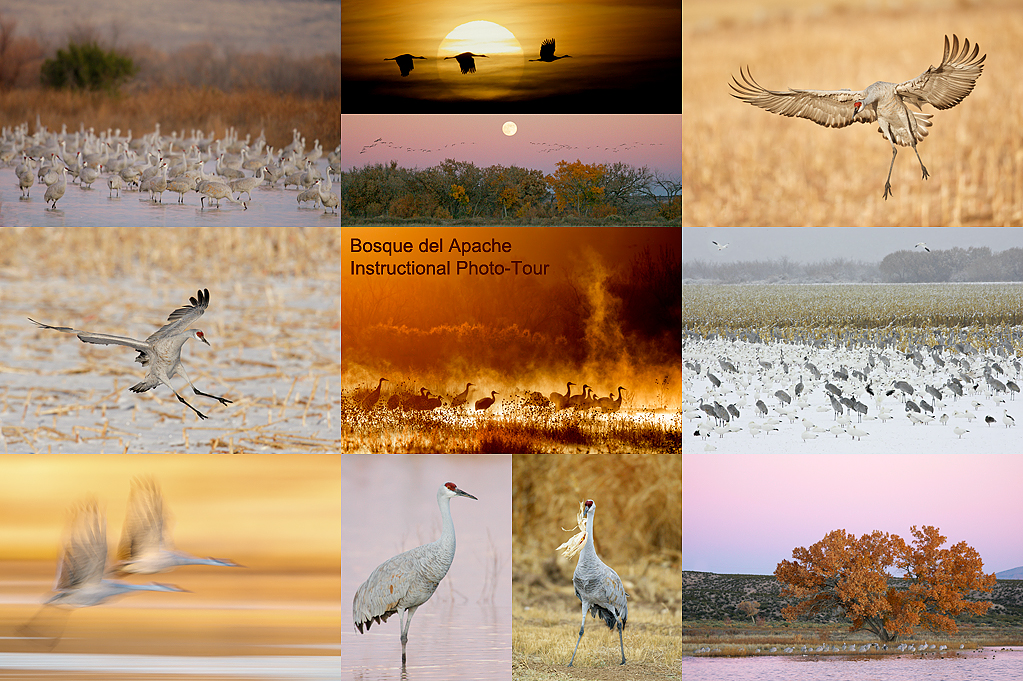
|
|
Bosque Sandhill Crane Composite; click on the image to enjoy a larger version.
|
Bosque del Apache 2013 IPT: “The Complete Bosque Experience.” NOV 26-DEC 2, 2013. 7-FULL DAYS: $3399. Co-leader: Denise Ippolito. Introductory Slide program: 6:30 pm on 11/25. Limit: 12/Openings 8.
Please see the info on the short version of this IPT below if you will be spending Thanksgiving with your family.
Tens of thousand of Snow Geese, 10,000 Sandhill Cranes, ducks including point-blank American Wigeon and Wood Duck, amazing sunrises, sunsets, and blast-offs. Live, eat, and breathe photography with one of (if not the) world’s premier photographic educators at one of his very favorite locations on the planet. Top-notch Photoshop instruction. This will make 19 consecutive Novembers at Bosque for me. Nobody knows the place better than I do. Join us to learn to think like a pro, to recognize situations and to anticipate them based on the weather, especially the sky conditions, the light, and the wind direction. Every time we make a move we will let you know why. When you head home applying what you learned will prove to be invaluable. Includes all lunches and the Thanksgiving Buffet at the Crowne Plaza in Albuquerque. I hope that you can join me for what will be an unparalleled learning experience.
There is never a strict itinerary on a Bosque IPT as each day is tailored to the local conditions at the time and the weather. We are totally flexible in order to maximize both the photographic and learning opportunities. There is an introductory slide program on the night before the tour begins. We are up early each day leaving the hotel by 5:30 am to be in position for sunrise. After 18 years we pretty much know where to be when in what sky conditions and what winds. We usually photograph until about 10:30am. Then it is back to Socorro for lunch and then a classroom session with the group most days. We head back to the refuge at about 3:30pm each day and photograph until sunset. Then dinner with the group most nights. We always spend at least one afternoon at the ponds at the Albuquerque Zoo doing Wood Ducks and usually two mornings at New Mexico Tech doing American Wigeons. The rest is Snow Geese and Sandhill Cranes with the emphasis on expanding both your technical skills and your creativity.
A $500 non-refundable deposit is required to hold your slot for this IPT. Your balance, payable only by check, is due now. You will receive an e-mail notifying you of that after you place your deposit. If the trip fills, we will be glad to apply a credit applicable to a future IPT for the full amount less a $100 processing fee. If we do not receive your check for the balance on or before the due date we will try to fill your spot from the waiting list. If your spot is filled, you will lose your deposit. If not, you can secure your spot by paying your balance.
Please print, complete, and sign the form that is linked to here and shoot it to us along with your deposit check (made out to “Arthur Morris.”) You can also leave your deposit with a credit card by calling the office at 863-692-0906. If you register by phone, please print, complete and sign the form as noted above and either mail it to us or e-mail the scan. If you have any questions, please feel free to contact me via e-mail.
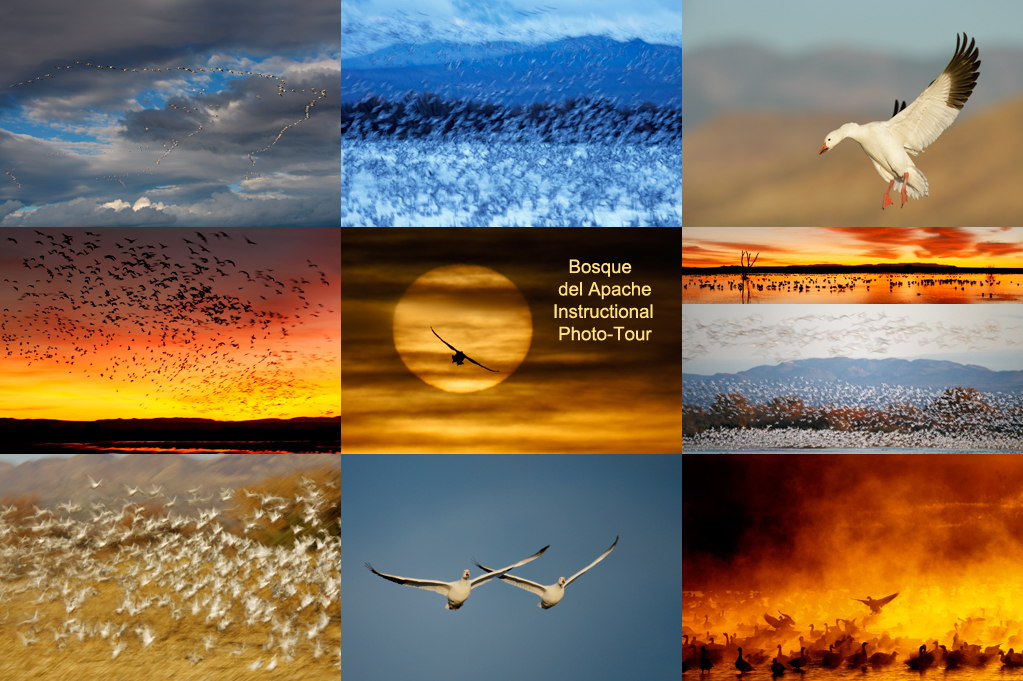
|
|
Bosque Snow Goose Composite; click on the image to enjoy a larger version.
|
Bosque del Apache 2013 IPT: “The Short Version.” NOV 30-DEC 2, 2013. 3-FULL DAYS: $1199. Co-leader: Denise Ippolito. Introductory Slide program: 7:30 pm on 11/29. Limit: 12/Openings 4.
Tens of thousand of Snow Geese, 10,000 Sandhill Cranes, amazing sunrises, sunsets, and blast-offs. Top-notch Photoshop instruction. This will make 19 consecutive Novembers at Bosque for artie. Nobody knows the place better than he does. Join us to learn to think like a pro, to recognize situations and to anticipate them based on the weather, especially the sky conditions, the light, and the wind direction. Every time we make a move we will let you know why. When you head home applying what you learned will prove to be invaluable. Includes all lunches. I hope that you can join us for these three great days; they will offer a great learning experience.
There is never a strict itinerary on a Bosque IPT as each day is tailored to the local conditions at the time and the weather. We are totally flexible in order to maximize both the photographic and learning opportunities. There is an introductory slide program on the night before the tour begins. We are up early each day leaving the hotel by 5:30 am to be in position for sunrise. After 18 years we pretty much know where to be when in what sky conditions and what winds. We usually photograph until about 10:30am. Then it is back to Socorro for lunch and then an informal Photoshop/image review session with the group most days. We head back to the refuge at about 3:30pm each day and photograph until sunset. We may spend an afternoon at the ponds at the Albuquerque Zoo doing Wood Ducks and we may spend a late morning at New Mexico Tech doing American Wigeons. The rest is Snow Geese and Sandhill Cranes with the emphasis on expanding both your technical skills and your creativity.
A $500 non-refundable deposit is required to hold your slot for this IPT. Your balance, payable only by check, is due now. You will receive an e-mail notifying you of that after you place your deposit. If the trip fills, we will be glad to apply a credit applicable to a future IPT for the full amount less a $100 processing fee. If we do not receive your check for the balance on or before the due date we will try to fill your spot from the waiting list. If your spot is filled, you will lose your deposit. If not, you can secure your spot by paying your balance.
Please print, complete, and sign the form that is linked to here and shoot it to us along with your deposit check (made out to “Arthur Morris.”) You can also leave your deposit with a credit card by calling the office at 863-692-0906. If you register by phone, please print, complete and sign the form as noted above and either mail it to us or e-mail the scan. If you have any questions, please feel free to contact me via e-mail.
BIRDS AS ART 2nd International Bird Photography Competition
Learn more and enter the BIRDS AS ART 2nd International Bird Photography Competition here. Twenty-five great prizes including the $1000 Grand Prize and intense competition. Bring your best.
2014 Tanzania Summer Safari
If you are interested in joining us in Tanzania next summer please shoot me an e-mail and I will be glad to forward you the PDF with dates, itinerary, and price.
Support the BAA Blog. Support the BAA Bulletins: Shop B&H here!
We want and need to keep providing you with the latest free information, photography and Photoshop lessons, and all manner of related information. Show your appreciation by making your purchases immediately after clicking on any of our B&H or Amazon Affiliate links in this blog post. Remember, B&H ain’t just photography!




Amazon
Everyone buys something from Amazon, be it a big lens or deodorant. Support the blog by starting your search by starting your search by clicking on the logo-link below. No purchase is too small to be appreciated; they all add up. Why make it a habit? Because I make it a habit of bringing you new images and information on an almost daily basis.
Typos
In all Bulletins, feel free to e-mail or leave a comment regarding any typos, wrong words, misspellings, omissions, or grammatical errors. Just be right. 🙂
IPT Info
Many of our great trips are filling up. Two great leaders ensure that you will not learn more anywhere about how to make great images. Click here for the schedule and additional info.
November 9th, 2013
Editing Practice/Yellow-billed Pintail: Keep One or Both?
Editing (not optimizing) your images is an important part of the digital photography experience. One of these years I will get around to doing an Editing Guide… In the meantime, I will start posting some series of similar images taken at almost the same moment and ask you which one or ones to keep and why. Most of you should find these exercises to be extremely valuable.
These two images, the first created on our initial morning at Puerto Natales, Chile at 07:54:47am, were made one second apart. Would you keep one or both? If you feel clearly that one is better than the other, please let us know which one and why. Be sure to click on each image to see the larger version.
The two 1200 pixel wide JPEGs here were created from the extracted JPEGs; both were sharpened, neither has been optimized.
Image Optimization Question
Whichever one you keep, how would you crop it?
EOS-1D X Autofocus Guide
Until I get around to doing a complete user’s guide for the 1D X my 1D X Autofocus Guide will help you to master and get the most out of my all time favorite professional digital camera body. It includes my customized Case setting for photographing birds in flight and in action.
5D Mark III User’s Guide
EOS-5D Mark III User’s can learn to set up and use their cameras exactly as I do. Includes detailed advice on all menu and custom function items, AF suggestions, and all you need to know about creating great in-camera HDRs and Multiple Exposures.

|
|
Bosque Sandhill Crane Composite; click on the image to enjoy a larger version.
|
Bosque del Apache 2013 IPT: “The Complete Bosque Experience.” NOV 26-DEC 2, 2013. 7-FULL DAYS: $3399. Co-leader: Denise Ippolito. Introductory Slide program: 6:30 pm on 11/25. Limit: 12/Openings 8.
Please see the info on the short version of this IPT below if you will be spending Thanksgiving with your family.
Tens of thousand of Snow Geese, 10,000 Sandhill Cranes, ducks including point-blank American Wigeon and Wood Duck, amazing sunrises, sunsets, and blast-offs. Live, eat, and breathe photography with one of (if not the) world’s premier photographic educators at one of his very favorite locations on the planet. Top-notch Photoshop instruction. This will make 19 consecutive Novembers at Bosque for me. Nobody knows the place better than I do. Join us to learn to think like a pro, to recognize situations and to anticipate them based on the weather, especially the sky conditions, the light, and the wind direction. Every time we make a move we will let you know why. When you head home applying what you learned will prove to be invaluable. Includes all lunches and the Thanksgiving Buffet at the Crowne Plaza in Albuquerque. I hope that you can join me for what will be an unparalleled learning experience.
There is never a strict itinerary on a Bosque IPT as each day is tailored to the local conditions at the time and the weather. We are totally flexible in order to maximize both the photographic and learning opportunities. There is an introductory slide program on the night before the tour begins. We are up early each day leaving the hotel by 5:30 am to be in position for sunrise. After 18 years we pretty much know where to be when in what sky conditions and what winds. We usually photograph until about 10:30am. Then it is back to Socorro for lunch and then a classroom session with the group most days. We head back to the refuge at about 3:30pm each day and photograph until sunset. Then dinner with the group most nights. We always spend at least one afternoon at the ponds at the Albuquerque Zoo doing Wood Ducks and usually two mornings at New Mexico Tech doing American Wigeons. The rest is Snow Geese and Sandhill Cranes with the emphasis on expanding both your technical skills and your creativity.
A $500 non-refundable deposit is required to hold your slot for this IPT. Your balance, payable only by check, is due now. You will receive an e-mail notifying you of that after you place your deposit. If the trip fills, we will be glad to apply a credit applicable to a future IPT for the full amount less a $100 processing fee. If we do not receive your check for the balance on or before the due date we will try to fill your spot from the waiting list. If your spot is filled, you will lose your deposit. If not, you can secure your spot by paying your balance.
Please print, complete, and sign the form that is linked to here and shoot it to us along with your deposit check (made out to “Arthur Morris.”) You can also leave your deposit with a credit card by calling the office at 863-692-0906. If you register by phone, please print, complete and sign the form as noted above and either mail it to us or e-mail the scan. If you have any questions, please feel free to contact me via e-mail.

|
|
Bosque Snow Goose Composite; click on the image to enjoy a larger version.
|
Bosque del Apache 2013 IPT: “The Short Version.” NOV 30-DEC 2, 2013. 3-FULL DAYS: $1199. Co-leader: Denise Ippolito. Introductory Slide program: 7:30 pm on 11/29. Limit: 12/Openings 4.
Tens of thousand of Snow Geese, 10,000 Sandhill Cranes, amazing sunrises, sunsets, and blast-offs. Top-notch Photoshop instruction. This will make 19 consecutive Novembers at Bosque for artie. Nobody knows the place better than he does. Join us to learn to think like a pro, to recognize situations and to anticipate them based on the weather, especially the sky conditions, the light, and the wind direction. Every time we make a move we will let you know why. When you head home applying what you learned will prove to be invaluable. Includes all lunches. I hope that you can join us for these three great days; they will offer a great learning experience.
There is never a strict itinerary on a Bosque IPT as each day is tailored to the local conditions at the time and the weather. We are totally flexible in order to maximize both the photographic and learning opportunities. There is an introductory slide program on the night before the tour begins. We are up early each day leaving the hotel by 5:30 am to be in position for sunrise. After 18 years we pretty much know where to be when in what sky conditions and what winds. We usually photograph until about 10:30am. Then it is back to Socorro for lunch and then an informal Photoshop/image review session with the group most days. We head back to the refuge at about 3:30pm each day and photograph until sunset. We may spend an afternoon at the ponds at the Albuquerque Zoo doing Wood Ducks and we may spend a late morning at New Mexico Tech doing American Wigeons. The rest is Snow Geese and Sandhill Cranes with the emphasis on expanding both your technical skills and your creativity.
A $500 non-refundable deposit is required to hold your slot for this IPT. Your balance, payable only by check, is due now. You will receive an e-mail notifying you of that after you place your deposit. If the trip fills, we will be glad to apply a credit applicable to a future IPT for the full amount less a $100 processing fee. If we do not receive your check for the balance on or before the due date we will try to fill your spot from the waiting list. If your spot is filled, you will lose your deposit. If not, you can secure your spot by paying your balance.
Please print, complete, and sign the form that is linked to here and shoot it to us along with your deposit check (made out to “Arthur Morris.”) You can also leave your deposit with a credit card by calling the office at 863-692-0906. If you register by phone, please print, complete and sign the form as noted above and either mail it to us or e-mail the scan. If you have any questions, please feel free to contact me via e-mail.
BIRDS AS ART 2nd International Bird Photography Competition
Learn more and enter the BIRDS AS ART 2nd International Bird Photography Competition here. Twenty-five great prizes including the $1000 Grand Prize and intense competition. Bring your best.
2014 Tanzania Summer Safari
If you are interested in joining us in Tanzania next summer please shoot me an e-mail and I will be glad to forward you the PDF with dates, itinerary, and price.
Support the BAA Blog. Support the BAA Bulletins: Shop B&H here!
We want and need to keep providing you with the latest free information, photography and Photoshop lessons, and all manner of related information. Show your appreciation by making your purchases immediately after clicking on any of our B&H or Amazon Affiliate links in this blog post. Remember, B&H ain’t just photography!




Amazon
Everyone buys something from Amazon, be it a big lens or deodorant. Support the blog by starting your search by starting your search by clicking on the logo-link below. No purchase is too small to be appreciated; they all add up. Why make it a habit? Because I make it a habit of bringing you new images and information on an almost daily basis.
Typos
In all Bulletins, feel free to e-mail or leave a comment regarding any typos, wrong words, misspellings, omissions, or grammatical errors. Just be right. 🙂
IPT Info
Many of our great trips are filling up. Two great leaders ensure that you will not learn more anywhere about how to make great images. Click here for the schedule and additional info.
November 8th, 2013
Magellanic Oystercatcher
With its sleek, deep-black feathers and slightly less bulky carriage, this species seems more elegant and beautiful than its close relative, American Oystercatcher. It had been giving me fits for days on the Patagonia trip as far as photography goes, often allowing close approach but… Wind against light, lousy setting, can’t see the feet, all the usual image wreckers. At Morro Chico Step we stopped at a pond with several pairs. For the first two hours it was more fits. Then I decided to just sit on the cracked mud behind my lowered tripod and wait for the birds to come to me. This bird and two others landed nearby and began displaying. Both the raised foot and the perfect look-back head angle added to the success of the image.
Double-banded Plover
This rather sedentary species is relatively common in Patagonia in the right habitat. I had seen it previously on the Falklands in gorgeous light. But the bird was sporting an array of color bands so the experience left me rather unfulfilled. There were several pairs on the small lake and at least one pair had a nest; one of the birds was doing the rodent-run nest distraction display, walking away from us with its chest down while shaking its outstretched wings.
Here again, the patient approach worked well; sit on the dried mud and wait for the birds to approach.
White-rumped Sandpiper
White-rumped Sandpiper is a fairly common long distance migrant Calidris in the northeastern US, an old friend that I saw regularly in summer and early fall in my old haunts, the East Pond at Jamaica Bay Wildlife Refuge, Queens, NY.
As this species winters exclusively in southern South America, I foolishly expected that it would be fully molted to non-breeding plumage in Chile at this time of year. I forgot that in the northeast, a few molting adult white-rumpeds were seen regularly throughout October. This bird is an extremely worn molting adult. If it were in full breeding plumage, each feather would look fresh and each would exhibit a cold grey tone. None-the-less, it was good seeing an old friend so far from the Big Apple.
BIRDS AS ART 2nd International Bird Photography Competition
Learn more and enter the BIRDS AS ART 2nd International Bird Photography Competition here. Twenty-five great prizes including the $1000 Grand Prize and intense competition. Bring your best.
Support the BAA Blog. Support the BAA Bulletins: Shop B&H here!
We want and need to keep providing you with the latest free information, photography and Photoshop lessons, and all manner of related information. Show your appreciation by making your purchases immediately after clicking on any of our B&H or Amazon Affiliate links in this blog post. Remember, B&H ain’t just photography!




Amazon
Everyone buys something from Amazon, be it a big lens or deodorant. Support the blog by starting your search by starting your search by clicking on the logo-link below. No purchase is too small to be appreciated; they all add up. Why make it a habit? Because I make it a habit of bringing you new images and information on an almost daily basis.
Typos
In all Bulletins, feel free to e-mail or leave a comment regarding any typos, wrong words, misspellings, omissions, or grammatical errors. Just be right. 🙂
IPT Info
Many of our great trips are filling up. Two great leaders ensure that you will not learn more anywhere about how to make great images. Click here for the schedule and additional info.
November 7th, 2013
|

|
|
This image was created with the hand held Canon EF 70-200mm f/2.8L IS II USM lens (at 85mm) and the Canon EOS 5D Mark III. ISO 800. Evaluative metering +1 stop: 1/250 sec. at f/8.
One sensor to the right and two rows up from the central sensor/AI Servo-Surround/Rear Focus AF as framed active at the moment of exposure. Click here if you missed the Rear Focus Tutorial. Click on the image to see a larger version.
|
Large Grey Trio
Here are three very different African Elephant images, each made on last August’s Summer Safari. Please leave a comment and let us know which is your favorite and why. What do you think of the framing of the first image? How do you feel about the centered composition with the second image? Would you change anything in the third image? What is the strength of the third image?
How would you have improved the first image? The second? Does anything in the third image bug you? If yes, what?
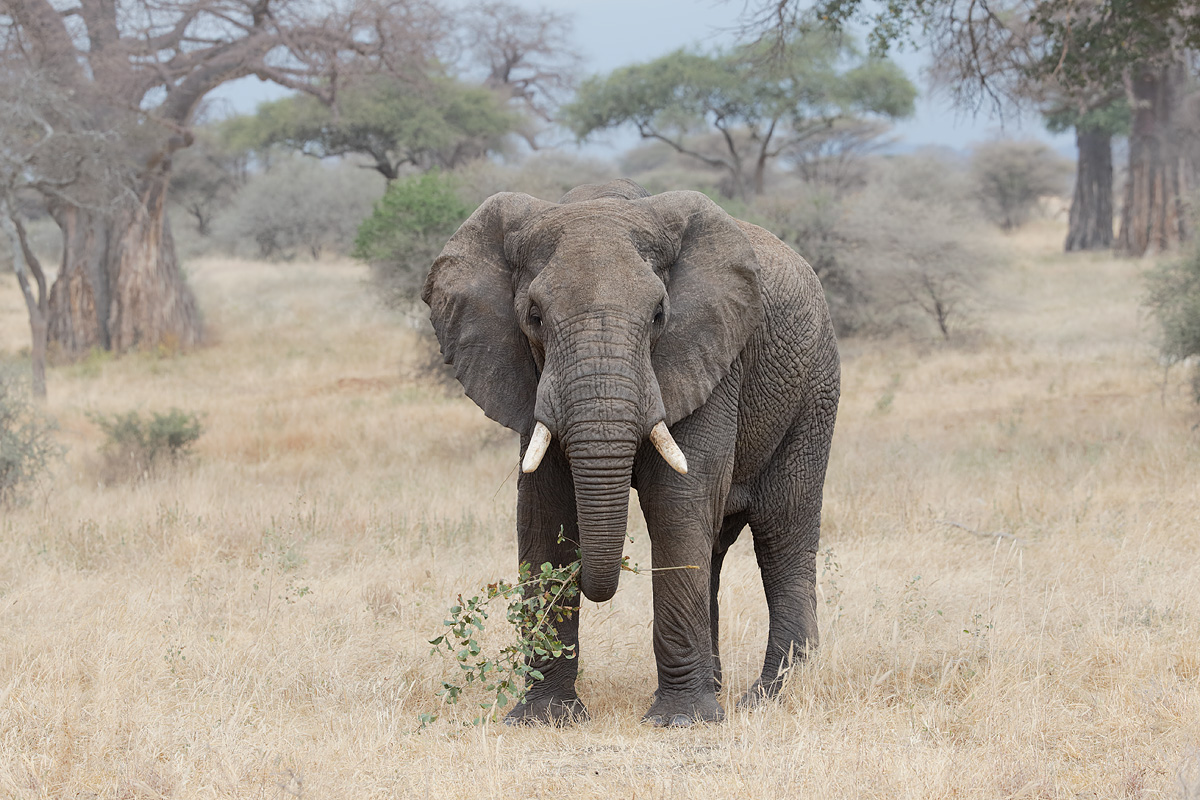
|
|
This image was created with the hand held Canon EF 200-400mm f/4L IS USM lens with Internal 1.4x Extender (at 239mm) and the and the Canon EOS-1D X. ISO 400. Evaluative metering +2/3 stop: 1/400 sec. at f/7.1.
Central sensor/AI Servo-Surround/Rear Focus AF right between the tusks active at the moment of exposure. Click here if you missed the Rear Focus Tutorial. Click on the image to see a larger version.
|
Best Parts
For you, what is the best thing about the first image? What do you like best about the second image?
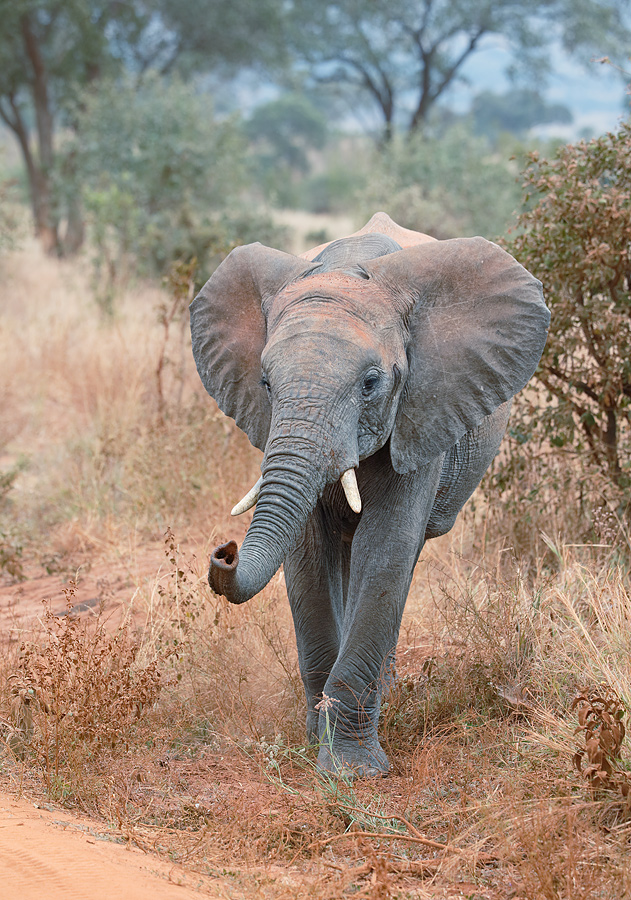
|
|
This image was also created with the hand held Canon EF 200-400mm f/4L IS USM lens with Internal 1.4x Extender (at 225mm) and the and the Canon EOS-1D X. ISO 400. Evaluative metering +1/3 stop: 1/400 sec. at f/5.6.
One sensor up from the central sensor/AI Servo-Surround/Rear Focus AF right between the tusks active at the moment of exposure. Click here if you missed the Rear Focus Tutorial. Click on the image to see a larger version.
|
…..
BIRDS AS ART 2nd International Bird Photography Competition
Learn more and enter the BIRDS AS ART 2nd International Bird Photography Competition here. Twenty-five great prizes including the $1000 Grand Prize and intense competition. Bring your best.
2014 Tanzania Summer Safari
If you are interested in joining us in Tanzania next summer please shoot me an e-mail and I will be glad to forward you the PDF with dates, itinerary, and price.
Support the BAA Blog. Support the BAA Bulletins: Shop B&H here!
We want and need to keep providing you with the latest free information, photography and Photoshop lessons, and all manner of related information. Show your appreciation by making your purchases immediately after clicking on any of our B&H or Amazon Affiliate links in this blog post. Remember, B&H ain’t just photography!




Amazon
Everyone buys something from Amazon, be it a big lens or deodorant. Support the blog by starting your search by starting your search by clicking on the logo-link below. No purchase is too small to be appreciated; they all add up. Why make it a habit? Because I make it a habit of bringing you new images and information on an almost daily basis.
Typos
In all Bulletins, feel free to e-mail or leave a comment regarding any typos, wrong words, misspellings, omissions, or grammatical errors. Just be right. 🙂
IPT Info
Many of our great trips are filling up. Two great leaders ensure that you will not learn more anywhere about how to make great images. Click here for the schedule and additional info.
November 6th, 2013
Flight Photography is Difficult
What’s wrong with this one? Aside from being grossly out of focus, the goose is flying away from the photographer and is at least a bit too small in the frame. I have said and written often that I am not a very good flight photographer. The image above is proof of that. And the ravages of advancing age with poorer hand/high coordination, decreasing strength, and slower reaction times are not making things any better. Many beginning and intermediate photographers do not realize that even experienced professional bird photographers delete well more than 90% of their flight images.
Today’s post is, however, meant to encourage folks. Read on.
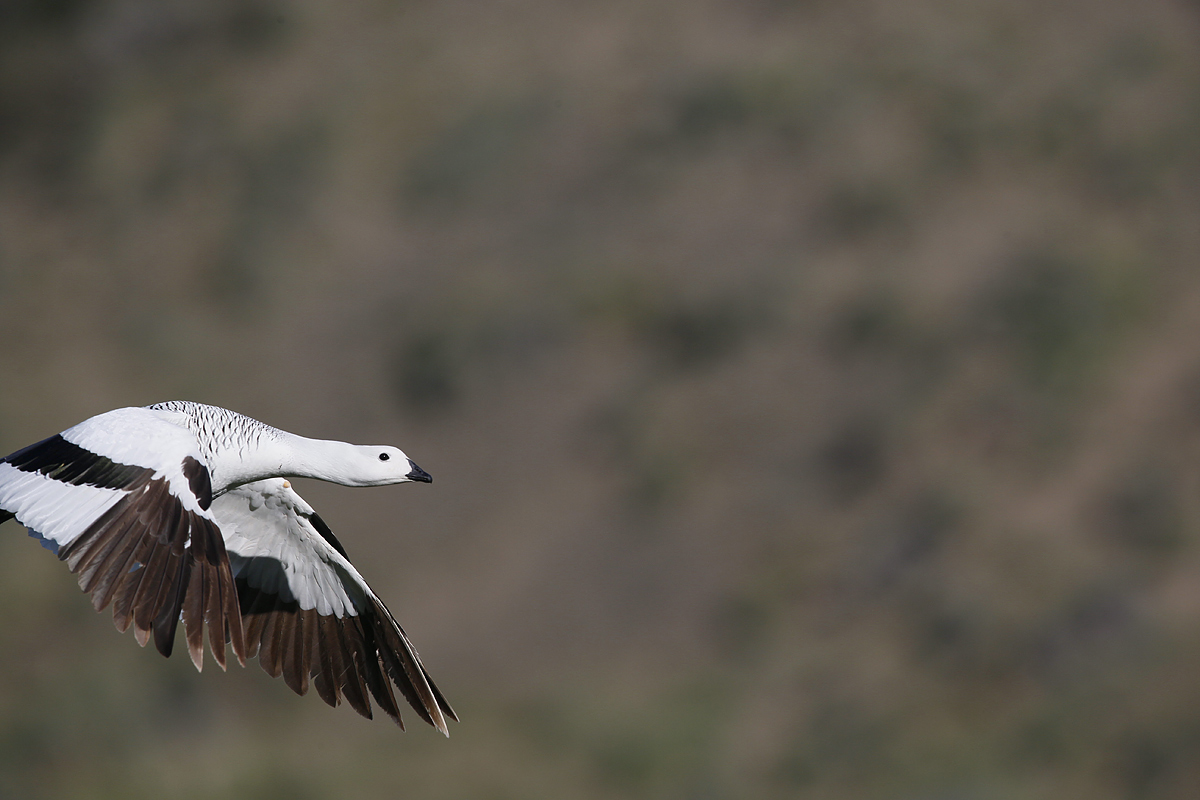
|
|
Same gear. ISO 400. Evaluative metering -1/3 stop off the goose on the green grass before take-off: 1/2000 sec. at f/7.1 set manually.
Central sensor/AI Servo Surround/Rear Focus AF active at the moment of exposure. Click on the image to see a larger version.
|
Panning Speed
As you can see in the image above, it is vitally important that you find the bird in the center of the frame, acquire accurate focus, and then match the speed of the bird in flight with your panning speed. In most cases folks pan too slowly; the bird often winds up to far forward in the frame. Here however, I did the opposite: panned too quickly. If you asked me how the AF system maintained accurate focus with the active sensors (central sensor/AI Servo AF Surround) nowhere near the bird, I would have to say that my 1D X customized Case settings for bird photography paid huge dividends. Note: I use the same Custom case settings with my 5D Mark III as with my 1D X.
EOS-1D X Autofocus Guide
Until I get around to doing a complete user’s guide for the 1D X my 1D X Autofocus Guide will help you to master and get the most out of my all time favorite professional digital camera body. It includes my customized Case setting for photographing birds in flight and in action.
5D Mark III User’s Guide
EOS-5D Mark III User’s can learn to set up and use their cameras exactly as I do. Includes detailed advice on all menu and custom function items, AF suggestions, and all you need to know about creating great in-camera HDRs and Multiple Exposures.
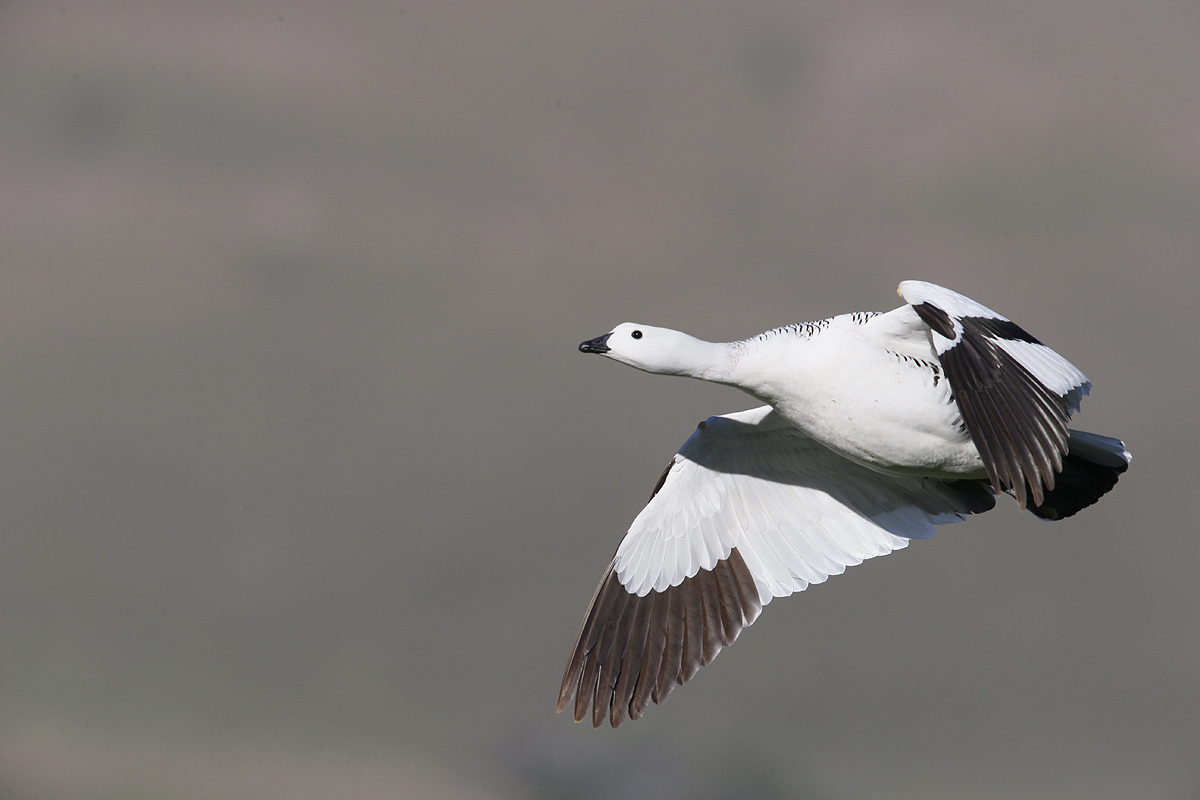
|
|
Same gear. ISO 800. Evaluative metering -1/3 stop off the goose on the green grass before take-off: 1/2000 sec. at f/9 set manually.
Central sensor/AI Servo Surround/Rear Focus AF active at the moment of exposure. Click on the image to see a larger version.
|
Better, But…
With the image above I got the bird fully in the frame, acquired accurate focus, and matched the flight speed of the bird with my panning speed. Yet even thought the image is razor sharp with a perfect exposure it is an instant delete for me because of the position of the near wing. With the near-wing half bent we do not get to see the dorsal surface; for me, this wing position is not at all pleasing. As I say and teach constantly, with a bird flying left to right or right to left, the two best wing positions are wings full down or wings full up.
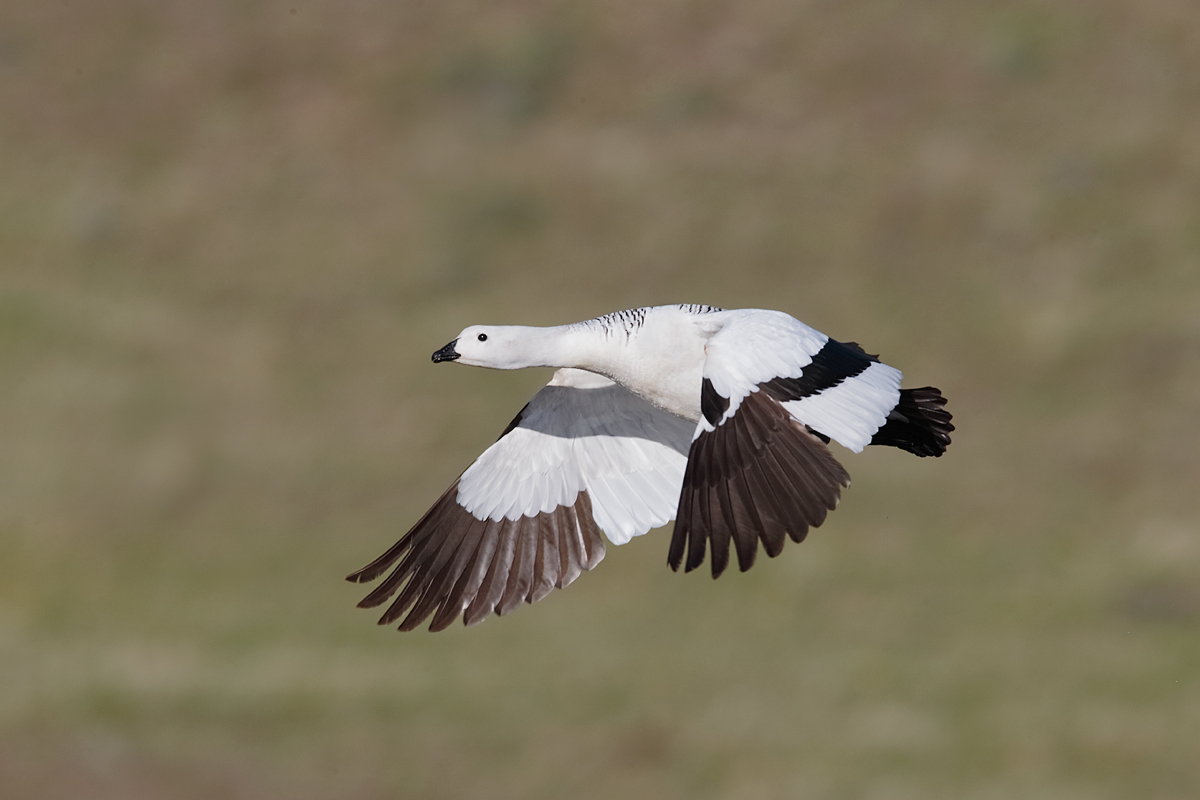
|
|
Same gear. ISO 800. Evaluative metering -1/3 stop off the goose on the green grass before take-off: 1/2000 sec. at f/9 set manually.
Central sensor/AI Servo Surround/Rear Focus AF active at the moment of exposure just caught the bird’s upper breast. Click on the image to see a larger version.
|
Persistence
While I am not very skilled at photographing birds in flight and birds in action, I am persistent. In fact, very persistent. The image above that features the bird angling a bit towards us, is sharp and well exposed, and offers my very favorite wing position, wings full down. After an hour of trying, the image above was the last that I made. Success at last. I hooked back up with Denise Ippolito and David Tipling and we headed off looking for backlit Guanacos.
Practice, Practice, Practice
Practice, practice, practice is indeed the best way to get to Carnegie Hall, and is indeed the best way to improve your flight photography. If you would really like to master the art do consider joining us on one of the the upcoming Bosque IPTs see below).
Or get yourself a copy of Jim Neiger’s great e-Guide, “Flight Plan. 🙂
Flight Plan
Check out Jim Neiger’s great, long-awaited new e-Guide on photographing birds in flight here.

|
|
Bosque Sandhill Crane Composite; click on the image to enjoy a larger version.
|
Bosque del Apache 2013 IPT: “The Complete Bosque Experience.” NOV 26-DEC 2, 2013. 7-FULL DAYS: $3399. Co-leader: Denise Ippolito. Introductory Slide program: 6:30 pm on 11/25. Limit: 12/Openings 8.
Please see the info on the short version of this IPT below if you will be spending Thanksgiving with your family.
Tens of thousand of Snow Geese, 10,000 Sandhill Cranes, ducks including point-blank American Wigeon and Wood Duck, amazing sunrises, sunsets, and blast-offs. Live, eat, and breathe photography with one of (if not the) world’s premier photographic educators at one of his very favorite locations on the planet. Top-notch Photoshop instruction. This will make 19 consecutive Novembers at Bosque for me. Nobody knows the place better than I do. Join us to learn to think like a pro, to recognize situations and to anticipate them based on the weather, especially the sky conditions, the light, and the wind direction. Every time we make a move we will let you know why. When you head home applying what you learned will prove to be invaluable. Includes all lunches and the Thanksgiving Buffet at the Crowne Plaza in Albuquerque. I hope that you can join me for what will be an unparalleled learning experience.
There is never a strict itinerary on a Bosque IPT as each day is tailored to the local conditions at the time and the weather. We are totally flexible in order to maximize both the photographic and learning opportunities. There is an introductory slide program on the night before the tour begins. We are up early each day leaving the hotel by 5:30 am to be in position for sunrise. After 18 years we pretty much know where to be when in what sky conditions and what winds. We usually photograph until about 10:30am. Then it is back to Socorro for lunch and then a classroom session with the group most days. We head back to the refuge at about 3:30pm each day and photograph until sunset. Then dinner with the group most nights. We always spend at least one afternoon at the ponds at the Albuquerque Zoo doing Wood Ducks and usually two mornings at New Mexico Tech doing American Wigeons. The rest is Snow Geese and Sandhill Cranes with the emphasis on expanding both your technical skills and your creativity.
A $500 non-refundable deposit is required to hold your slot for this IPT. Your balance, payable only by check, is due now. You will receive an e-mail notifying you of that after you place your deposit. If the trip fills, we will be glad to apply a credit applicable to a future IPT for the full amount less a $100 processing fee. If we do not receive your check for the balance on or before the due date we will try to fill your spot from the waiting list. If your spot is filled, you will lose your deposit. If not, you can secure your spot by paying your balance.
Please print, complete, and sign the form that is linked to here and shoot it to us along with your deposit check (made out to “Arthur Morris.”) You can also leave your deposit with a credit card by calling the office at 863-692-0906. If you register by phone, please print, complete and sign the form as noted above and either mail it to us or e-mail the scan. If you have any questions, please feel free to contact me via e-mail.

|
|
Bosque Snow Goose Composite; click on the image to enjoy a larger version.
|
Bosque del Apache 2013 IPT: “The Short Version.” NOV 30-DEC 2, 2013. 3-FULL DAYS: $1199. Co-leader: Denise Ippolito. Introductory Slide program: 7:30 pm on 11/29. Limit: 12/Openings 4.
Tens of thousand of Snow Geese, 10,000 Sandhill Cranes, amazing sunrises, sunsets, and blast-offs. Top-notch Photoshop instruction. This will make 19 consecutive Novembers at Bosque for artie. Nobody knows the place better than he does. Join us to learn to think like a pro, to recognize situations and to anticipate them based on the weather, especially the sky conditions, the light, and the wind direction. Every time we make a move we will let you know why. When you head home applying what you learned will prove to be invaluable. Includes all lunches. I hope that you can join us for these three great days; they will offer a great learning experience.
There is never a strict itinerary on a Bosque IPT as each day is tailored to the local conditions at the time and the weather. We are totally flexible in order to maximize both the photographic and learning opportunities. There is an introductory slide program on the night before the tour begins. We are up early each day leaving the hotel by 5:30 am to be in position for sunrise. After 18 years we pretty much know where to be when in what sky conditions and what winds. We usually photograph until about 10:30am. Then it is back to Socorro for lunch and then an informal Photoshop/image review session with the group most days. We head back to the refuge at about 3:30pm each day and photograph until sunset. We may spend an afternoon at the ponds at the Albuquerque Zoo doing Wood Ducks and we may spend a late morning at New Mexico Tech doing American Wigeons. The rest is Snow Geese and Sandhill Cranes with the emphasis on expanding both your technical skills and your creativity.
A $500 non-refundable deposit is required to hold your slot for this IPT. Your balance, payable only by check, is due now. You will receive an e-mail notifying you of that after you place your deposit. If the trip fills, we will be glad to apply a credit applicable to a future IPT for the full amount less a $100 processing fee. If we do not receive your check for the balance on or before the due date we will try to fill your spot from the waiting list. If your spot is filled, you will lose your deposit. If not, you can secure your spot by paying your balance.
Please print, complete, and sign the form that is linked to here and shoot it to us along with your deposit check (made out to “Arthur Morris.”) You can also leave your deposit with a credit card by calling the office at 863-692-0906. If you register by phone, please print, complete and sign the form as noted above and either mail it to us or e-mail the scan. If you have any questions, please feel free to contact me via e-mail.
2014 Tanzania Summer Safari
If you are interested in joining us in Tanzania next summer please shoot me an e-mail and I will be glad to forward you the PDF with dates, itinerary, and price.
Support the BAA Blog. Support the BAA Bulletins: Shop B&H here!
We want and need to keep providing you with the latest free information, photography and Photoshop lessons, and all manner of related information. Show your appreciation by making your purchases immediately after clicking on any of our B&H or Amazon Affiliate links in this blog post. Remember, B&H ain’t just photography!




Amazon
Everyone buys something from Amazon, be it a big lens or deodorant. Support the blog by starting your search by starting your search by clicking on the logo-link below. No purchase is too small to be appreciated; they all add up. Why make it a habit? Because I make it a habit of bringing you new images and information on an almost daily basis.
Typos
In all Bulletins, feel free to e-mail or leave a comment regarding any typos, wrong words, misspellings, omissions, or grammatical errors. Just be right. 🙂
IPT Info
Many of our great trips are filling up. Two great leaders ensure that you will not learn more anywhere about how to make great images. Click here for the schedule and additional info.
November 5th, 2013
The MiniMag
The November issue of Denise Ippolito’s Creative MiniMag has been online for a few days now. In case you need some inspiration or just want to become a better photographer, be sure to click here. Denise opens the magazine by sharing a collection of participants’ images; each was created as a result of the graffiti photo assignment given to the workshop group on her recent trip to Toronto, Canada.
Tom Jeary’s incredible “The Chipmunk Fall Fair” has to be read and seen to be believed. In “Food Photography 101” Barbara Sammons shares her top five tips for photographing your favorite fare. Next Denise shares the Photoshop techniques and workflow that she used to fashion the lovely “Japanese Maple Leaves” creation above.
Everyone needs to read friend Scott Vincent’s moving “Making Pictures–The Voice.” With a series of powerful images Scott covers lots of ground including photographing controversial subject matter, the modern day whale slaughter that continues in Barrow, AK, and knowing right from wrong.
Mary Stamper’s article dealing with including shadows in our images. Yours truly details the creation of In-Camera HDR images with the Canon 5D Mark III; this article includes all of my favorite settings. In Denise’s “The Bear Neccessities” the publisher shares images and experiences from her first Katmai, AK Bear Boat trip this past September. Andrew McLachlan shares three of his favorite fall color multiple exposures and the set-up and techniques that he used to create them in-camera with his Nikon D800 .
Lisa Cuchara offers some great advice when she reminds us to ask, “Why Are Your Here?” when attending on-location photography workshops. The creative Anita Bower shares her thoughts on using the Nikon AF-S Nikkor 50mm f/1.8G lens to photograph flowers. In “Themes/Assignments Cheryl Slechta writes of getting out of the photographic ruts that we so often find ourselves in. Friend Nancy Bell shares the experience of photographing for a week in Cape Town, South Africa.
The MiniMag is both free and incredibly inspiring. It is always worth a click; if you visit, you will surely wind up subscribing.
Survival or Not… Death and Life on a Mudflat
While working shorebirds and Chilean Flamingos along the shore of a small lake at Morro Chico Steppe, Chile, I came across the fresh-dead Crested Duck duckling that you see in the image above. I picked it up, stuck it in the fanny pouch of my sweatshirt, and shared it with the group when we re-assembled. Then I posed it on the cracked mud, borrowed a 70-200, and began creating images.
The Surviving Siblings
I had gone to the far end of the pond trying without success to get close to winter-plumage White-rumped Sandpiper and Double-banded Plover. Denise Ippolito, who stayed behind, did very well on the white-rumpeds. When I headed back to the eastern end of the pond and found the dead duckling, Denise headed west and after a while, returned with a big smile on her face. One of the two surviving Crested Duck young had come up on the shore to forage and allowed close approach. The other was swimming in the middle of the lake with momma who was calling constantly as she was not very happy with the adventurous chick.
Image Questions
Which of the two images above is your favorite? Please let us know why. Why f/22 for the first image? If you kept the same framing, why might the 100 macro have been a better lens choice for the first image?
EOS-1D X Autofocus Guide
Until I get around to doing a complete user’s guide for the 1D X my 1D X Autofocus Guide will help you to master and get the most out of my all time favorite professional digital camera body. It includes my customized Case setting for photographing birds in flight and in action.
5D Mark III User’s Guide
EOS-5D Mark III User’s can learn to set up and use their cameras exactly as I do. Includes detailed advice on all menu and custom function items, AF suggestions, and all you need to know about creating great in-camera HDRs and Multiple Exposures.
BIRDS AS ART 2nd International Bird Photography Competition
Learn more and enter the BIRDS AS ART 2nd International Bird Photography Competition here. Twenty-five great prizes including the $1000 Grand Prize and intense competition. Bring your best.

|
|
Bosque Sandhill Crane Composite; click on the image to enjoy a larger version.
|
Bosque del Apache 2013 IPT: “The Complete Bosque Experience.” NOV 26-DEC 2, 2013. 7-FULL DAYS: $3399. Co-leader: Denise Ippolito. Introductory Slide program: 6:30 pm on 11/25. Limit: 12/Openings 8.
Please see the info on the short version of this IPT below if you will be spending Thanksgiving with your family.
Tens of thousand of Snow Geese, 10,000 Sandhill Cranes, ducks including point-blank American Wigeon and Wood Duck, amazing sunrises, sunsets, and blast-offs. Live, eat, and breathe photography with one of (if not the) world’s premier photographic educators at one of his very favorite locations on the planet. Top-notch Photoshop instruction. This will make 19 consecutive Novembers at Bosque for me. Nobody knows the place better than I do. Join us to learn to think like a pro, to recognize situations and to anticipate them based on the weather, especially the sky conditions, the light, and the wind direction. Every time we make a move we will let you know why. When you head home applying what you learned will prove to be invaluable. Includes all lunches and the Thanksgiving Buffet at the Crowne Plaza in Albuquerque. I hope that you can join me for what will be an unparalleled learning experience.
There is never a strict itinerary on a Bosque IPT as each day is tailored to the local conditions at the time and the weather. We are totally flexible in order to maximize both the photographic and learning opportunities. There is an introductory slide program on the night before the tour begins. We are up early each day leaving the hotel by 5:30 am to be in position for sunrise. After 18 years we pretty much know where to be when in what sky conditions and what winds. We usually photograph until about 10:30am. Then it is back to Socorro for lunch and then a classroom session with the group most days. We head back to the refuge at about 3:30pm each day and photograph until sunset. Then dinner with the group most nights. We always spend at least one afternoon at the ponds at the Albuquerque Zoo doing Wood Ducks and usually two mornings at New Mexico Tech doing American Wigeons. The rest is Snow Geese and Sandhill Cranes with the emphasis on expanding both your technical skills and your creativity.
A $500 non-refundable deposit is required to hold your slot for this IPT. Your balance, payable only by check, is due now. You will receive an e-mail notifying you of that after you place your deposit. If the trip fills, we will be glad to apply a credit applicable to a future IPT for the full amount less a $100 processing fee. If we do not receive your check for the balance on or before the due date we will try to fill your spot from the waiting list. If your spot is filled, you will lose your deposit. If not, you can secure your spot by paying your balance.
Please print, complete, and sign the form that is linked to here and shoot it to us along with your deposit check (made out to “Arthur Morris.”) You can also leave your deposit with a credit card by calling the office at 863-692-0906. If you register by phone, please print, complete and sign the form as noted above and either mail it to us or e-mail the scan. If you have any questions, please feel free to contact me via e-mail.

|
|
Bosque Snow Goose Composite; click on the image to enjoy a larger version.
|
Bosque del Apache 2013 IPT: “The Short Version.” NOV 30-DEC 2, 2013. 3-FULL DAYS: $1199. Co-leader: Denise Ippolito. Introductory Slide program: 7:30 pm on 11/29. Limit: 12/Openings 4.
Tens of thousand of Snow Geese, 10,000 Sandhill Cranes, amazing sunrises, sunsets, and blast-offs. Top-notch Photoshop instruction. This will make 19 consecutive Novembers at Bosque for artie. Nobody knows the place better than he does. Join us to learn to think like a pro, to recognize situations and to anticipate them based on the weather, especially the sky conditions, the light, and the wind direction. Every time we make a move we will let you know why. When you head home applying what you learned will prove to be invaluable. Includes all lunches. I hope that you can join us for these three great days; they will offer a great learning experience.
There is never a strict itinerary on a Bosque IPT as each day is tailored to the local conditions at the time and the weather. We are totally flexible in order to maximize both the photographic and learning opportunities. There is an introductory slide program on the night before the tour begins. We are up early each day leaving the hotel by 5:30 am to be in position for sunrise. After 18 years we pretty much know where to be when in what sky conditions and what winds. We usually photograph until about 10:30am. Then it is back to Socorro for lunch and then an informal Photoshop/image review session with the group most days. We head back to the refuge at about 3:30pm each day and photograph until sunset. We may spend an afternoon at the ponds at the Albuquerque Zoo doing Wood Ducks and we may spend a late morning at New Mexico Tech doing American Wigeons. The rest is Snow Geese and Sandhill Cranes with the emphasis on expanding both your technical skills and your creativity.
A $500 non-refundable deposit is required to hold your slot for this IPT. Your balance, payable only by check, is due now. You will receive an e-mail notifying you of that after you place your deposit. If the trip fills, we will be glad to apply a credit applicable to a future IPT for the full amount less a $100 processing fee. If we do not receive your check for the balance on or before the due date we will try to fill your spot from the waiting list. If your spot is filled, you will lose your deposit. If not, you can secure your spot by paying your balance.
Please print, complete, and sign the form that is linked to here and shoot it to us along with your deposit check (made out to “Arthur Morris.”) You can also leave your deposit with a credit card by calling the office at 863-692-0906. If you register by phone, please print, complete and sign the form as noted above and either mail it to us or e-mail the scan. If you have any questions, please feel free to contact me via e-mail.
2014 Tanzania Summer Safari
If you are interested in joining us in Tanzania next summer please shoot me an e-mail and I will be glad to forward you the PDF with dates, itinerary, and price.
Support the BAA Blog. Support the BAA Bulletins: Shop B&H here!
We want and need to keep providing you with the latest free information, photography and Photoshop lessons, and all manner of related information. Show your appreciation by making your purchases immediately after clicking on any of our B&H or Amazon Affiliate links in this blog post. Remember, B&H ain’t just photography!




Amazon
Everyone buys something from Amazon, be it a big lens or deodorant. Support the blog by starting your search by starting your search by clicking on the logo-link below. No purchase is too small to be appreciated; they all add up. Why make it a habit? Because I make it a habit of bringing you new images and information on an almost daily basis.
Typos
In all Bulletins, feel free to e-mail or leave a comment regarding any typos, wrong words, misspellings, omissions, or grammatical errors. Just be right. 🙂
IPT Info
Many of our great trips are filling up. Two great leaders ensure that you will not learn more anywhere about how to make great images. Click here for the schedule and additional info.
November 3rd, 2013
With and Without: Teleconverter Versatility
The image above was created on a wild, wild day along the coast and a bit inland, south of Puerto Natales, Chile. We experienced rain, bright sunshine, wind gusts of up to 55 mph, wind driven icy hail that struck our face like tiny bullets, and even 30 seconds of large snow flakes. We came across some swallows roosting on a barbed wire fence. Surprisingly, many of them were fairly tame. When I saw the single bird perched on a lichen covered log, my eyes lit up.
In order to get the lens on the bird, I positioned the tripod carefully with two legs against the fence in a small creek and one lengthened leg on the grass. But the rig was off balance and the wind was howling so I needed to hold onto the longer leg with my left hand and fire the shutter with my right. Two of twenty images were acceptably sharp. Note the fine high ISO performance of the 1D X.
Going Wide With the 600II
After getting the image of the single bird that I wanted, that is, a bird not on a wire strand, I headed back to the van in the heavy rain. Everyone else has quit. When I saw the lovely array of swallows on the fence I removed the 2X TC, moved back a bit, and began creating images. With the wind pounding and the temperatures dropping still, framing each image was difficult at best. I needed to grab a sliver off the right of a second image in the series in order to create a sort of stitched composite so that there was some room in front of the birds on our right.
The Lesson
Remember that working with the 1.4X and 2X converters (and don’t forget to throw in the 1.7X Nikon TC) can increase the versatility of your kit. Many folks are reluctant or even afraid to add or remove TCs in the field. If you practice turning your camera off before switching out any accessories and then turning it back on (the latter is the hard part for me :)) you minimize problems with sensor dust.
Your Favorite?
Which of the two is your favorite? Please let us know why.
EOS-1D X Autofocus Guide
Until I get around to doing a complete user’s guide for the 1D X my 1D X Autofocus Guide will help you to master and get the most out of my all time favorite professional digital camera body. It includes my customized Case setting for photographing birds in flight and in action.
5D Mark III User’s Guide
EOS-5D Mark III User’s can learn to set up and use their cameras exactly as I do. Includes detailed advice on all menu and custom function items, AF suggestions, and all you need to know about creating great in-camera HDRs and Multiple Exposures.

|
|
Bosque Sandhill Crane Composite; click on the image to enjoy a larger version.
|
Bosque del Apache 2013 IPT: “The Complete Bosque Experience.” NOV 26-DEC 2, 2013. 7-FULL DAYS: $3399. Co-leader: Denise Ippolito. Introductory Slide program: 6:30 pm on 11/25. Limit: 12/Openings 8.
Please see the info on the short version of this IPT below if you will be spending Thanksgiving with your family.
Tens of thousand of Snow Geese, 10,000 Sandhill Cranes, ducks including point-blank American Wigeon and Wood Duck, amazing sunrises, sunsets, and blast-offs. Live, eat, and breathe photography with one of (if not the) world’s premier photographic educators at one of his very favorite locations on the planet. Top-notch Photoshop instruction. This will make 19 consecutive Novembers at Bosque for me. Nobody knows the place better than I do. Join us to learn to think like a pro, to recognize situations and to anticipate them based on the weather, especially the sky conditions, the light, and the wind direction. Every time we make a move we will let you know why. When you head home applying what you learned will prove to be invaluable. Includes all lunches and the Thanksgiving Buffet at the Crowne Plaza in Albuquerque. I hope that you can join me for what will be an unparalleled learning experience.
There is never a strict itinerary on a Bosque IPT as each day is tailored to the local conditions at the time and the weather. We are totally flexible in order to maximize both the photographic and learning opportunities. There is an introductory slide program on the night before the tour begins. We are up early each day leaving the hotel by 5:30 am to be in position for sunrise. After 18 years we pretty much know where to be when in what sky conditions and what winds. We usually photograph until about 10:30am. Then it is back to Socorro for lunch and then a classroom session with the group most days. We head back to the refuge at about 3:30pm each day and photograph until sunset. Then dinner with the group most nights. We always spend at least one afternoon at the ponds at the Albuquerque Zoo doing Wood Ducks and usually two mornings at New Mexico Tech doing American Wigeons. The rest is Snow Geese and Sandhill Cranes with the emphasis on expanding both your technical skills and your creativity.
A $500 non-refundable deposit is required to hold your slot for this IPT. Your balance, payable only by check, is due now. You will receive an e-mail notifying you of that after you place your deposit. If the trip fills, we will be glad to apply a credit applicable to a future IPT for the full amount less a $100 processing fee. If we do not receive your check for the balance on or before the due date we will try to fill your spot from the waiting list. If your spot is filled, you will lose your deposit. If not, you can secure your spot by paying your balance.
Please print, complete, and sign the form that is linked to here and shoot it to us along with your deposit check (made out to “Arthur Morris.”) You can also leave your deposit with a credit card by calling the office at 863-692-0906. If you register by phone, please print, complete and sign the form as noted above and either mail it to us or e-mail the scan. If you have any questions, please feel free to contact me via e-mail.

|
|
Bosque Snow Goose Composite; click on the image to enjoy a larger version.
|
Bosque del Apache 2013 IPT: “The Short Version.” NOV 30-DEC 2, 2013. 3-FULL DAYS: $1199. Co-leader: Denise Ippolito. Introductory Slide program: 7:30 pm on 11/29. Limit: 12/Openings 4.
Tens of thousand of Snow Geese, 10,000 Sandhill Cranes, amazing sunrises, sunsets, and blast-offs. Top-notch Photoshop instruction. This will make 19 consecutive Novembers at Bosque for artie. Nobody knows the place better than he does. Join us to learn to think like a pro, to recognize situations and to anticipate them based on the weather, especially the sky conditions, the light, and the wind direction. Every time we make a move we will let you know why. When you head home applying what you learned will prove to be invaluable. Includes all lunches. I hope that you can join us for these three great days; they will offer a great learning experience.
There is never a strict itinerary on a Bosque IPT as each day is tailored to the local conditions at the time and the weather. We are totally flexible in order to maximize both the photographic and learning opportunities. There is an introductory slide program on the night before the tour begins. We are up early each day leaving the hotel by 5:30 am to be in position for sunrise. After 18 years we pretty much know where to be when in what sky conditions and what winds. We usually photograph until about 10:30am. Then it is back to Socorro for lunch and then an informal Photoshop/image review session with the group most days. We head back to the refuge at about 3:30pm each day and photograph until sunset. We may spend an afternoon at the ponds at the Albuquerque Zoo doing Wood Ducks and we may spend a late morning at New Mexico Tech doing American Wigeons. The rest is Snow Geese and Sandhill Cranes with the emphasis on expanding both your technical skills and your creativity.
A $500 non-refundable deposit is required to hold your slot for this IPT. Your balance, payable only by check, is due now. You will receive an e-mail notifying you of that after you place your deposit. If the trip fills, we will be glad to apply a credit applicable to a future IPT for the full amount less a $100 processing fee. If we do not receive your check for the balance on or before the due date we will try to fill your spot from the waiting list. If your spot is filled, you will lose your deposit. If not, you can secure your spot by paying your balance.
Please print, complete, and sign the form that is linked to here and shoot it to us along with your deposit check (made out to “Arthur Morris.”) You can also leave your deposit with a credit card by calling the office at 863-692-0906. If you register by phone, please print, complete and sign the form as noted above and either mail it to us or e-mail the scan. If you have any questions, please feel free to contact me via e-mail.
BIRDS AS ART 2nd International Bird Photography Competition
Learn more and enter the BIRDS AS ART 2nd International Bird Photography Competition here. Twenty-five great prizes including the $1000 Grand Prize and intense competition. Bring your best.
2014 Tanzania Summer Safari
If you are interested in joining us in Tanzania next summer please shoot me an e-mail and I will be glad to forward you the PDF with dates, itinerary, and price.
Support the BAA Blog. Support the BAA Bulletins: Shop B&H here!
We want and need to keep providing you with the latest free information, photography and Photoshop lessons, and all manner of related information. Show your appreciation by making your purchases immediately after clicking on any of our B&H or Amazon Affiliate links in this blog post. Remember, B&H ain’t just photography!




Amazon
Everyone buys something from Amazon, be it a big lens or deodorant. Support the blog by starting your search by starting your search by clicking on the logo-link below. No purchase is too small to be appreciated; they all add up. Why make it a habit? Because I make it a habit of bringing you new images and information on an almost daily basis.
Typos
In all Bulletins, feel free to e-mail or leave a comment regarding any typos, wrong words, misspellings, omissions, or grammatical errors. Just be right. 🙂
IPT Info
Many of our great trips are filling up. Two great leaders ensure that you will not learn more anywhere about how to make great images. Click here for the schedule and additional info.
November 1st, 2013
A New Technique
While I have long used the 2X teleconverters with my f/4L IS super-telephoto lenses with great success I usually worked at f/8 or f/9. Recently I have begun working more at f/11 and f/13 (even at the expense of raising the ISO a bit; the resulting images have been insanely sharp. When I viewed this image in BreezeBrowser it looked as if the feathers had been sculpted with an exacto knife.
Grebe-e-licous
It is always fun to photograph a new species. Getting to photograph two handsome new grebes on the same day was a special treat.
The Original Capture
Immediately above is the extracted JPEG that accurately represents the tremendous blue color cast. The color cast was removed with a simple Average Blur Color Balance adjustment as described in Digital Basics File. Digital Basics is an instructional PDF that is sent via e-mail. It includes my complete digital workflow, dozens of great Photoshop tips including Digital Eye Doctor techniques, several different ways of expanding canvas, all of my time-saving Keyboard Shortcuts, and Layer Masking and NIK Color Efex Pro basics.
High Key
Above is the BreezeBrowser Main View screen capture for this image. The black is the highlight alert. In real time, it flashes black and white just as it does on the back of your camera. The illuminated red square shows the active sensor. In Breezebrowser you need to make sure to check Show Focus Points under View to activate this feature. To see the focus points in DPP check AF Point under View or hit Alt L.
The main point here is that in order to reveal maximum detail on the bird that I needed to overexpose the background; doing this reduces noise and yields an excellent exposure on the bird. The trick is that you wanted to avoid having any blinkies at all on the subject.
Regular readers know that I use and depend on BreezeBrowser every day of the year. It allows me to sort my keepers and deletes the rejects faster than any other browsing program. We use it on the main computer in the home office to catalog our images file-drawer style. And the companion program, Downloader Pro allows me to download my images quickly and conveniently. It automatically adds my IPTC data and the shooting location. I have it set up to create a folder named by the Month/date/year. The Breezebrowser/Downloader Pro combo saves me many hours each week. To learn earn more or to purchase this great PC only program, click here.
Image Questions
Which of the two is your favorite? Please let us know why. In the opening image, would you have eliminated all of the reeds in the background? Why or why not?
EOS-1D X Autofocus Guide
Until I get around to doing a complete user’s guide for the 1D X my 1D X Autofocus Guide will help you to master and get the most out of my all time favorite professional digital camera body. It includes my customized Case setting for photographing birds in flight and in action.
5D Mark III User’s Guide
EOS-5D Mark III User’s can learn to set up and use their cameras exactly as I do. Includes detailed advice on all menu and custom function items, AF suggestions, and all you need to know about creating great in-camera HDRs and Multiple Exposures.

|
|
Bosque Sandhill Crane Composite; click on the image to enjoy a larger version.
|
Bosque del Apache 2013 IPT: “The Complete Bosque Experience.” NOV 26-DEC 2, 2013. 7-FULL DAYS: $3399. Co-leader: Denise Ippolito. Introductory Slide program: 6:30 pm on 11/25. Limit: 12/Openings 8.
Please see the info on the short version of this IPT below if you will be spending Thanksgiving with your family.
Tens of thousand of Snow Geese, 10,000 Sandhill Cranes, ducks including point-blank American Wigeon and Wood Duck, amazing sunrises, sunsets, and blast-offs. Live, eat, and breathe photography with one of (if not the) world’s premier photographic educators at one of his very favorite locations on the planet. Top-notch Photoshop instruction. This will make 19 consecutive Novembers at Bosque for me. Nobody knows the place better than I do. Join us to learn to think like a pro, to recognize situations and to anticipate them based on the weather, especially the sky conditions, the light, and the wind direction. Every time we make a move we will let you know why. When you head home applying what you learned will prove to be invaluable. Includes all lunches and the Thanksgiving Buffet at the Crowne Plaza in Albuquerque. I hope that you can join me for what will be an unparalleled learning experience.
There is never a strict itinerary on a Bosque IPT as each day is tailored to the local conditions at the time and the weather. We are totally flexible in order to maximize both the photographic and learning opportunities. There is an introductory slide program on the night before the tour begins. We are up early each day leaving the hotel by 5:30 am to be in position for sunrise. After 18 years we pretty much know where to be when in what sky conditions and what winds. We usually photograph until about 10:30am. Then it is back to Socorro for lunch and then a classroom session with the group most days. We head back to the refuge at about 3:30pm each day and photograph until sunset. Then dinner with the group most nights. We always spend at least one afternoon at the ponds at the Albuquerque Zoo doing Wood Ducks and usually two mornings at New Mexico Tech doing American Wigeons. The rest is Snow Geese and Sandhill Cranes with the emphasis on expanding both your technical skills and your creativity.
A $500 non-refundable deposit is required to hold your slot for this IPT. Your balance, payable only by check, is due now. You will receive an e-mail notifying you of that after you place your deposit. If the trip fills, we will be glad to apply a credit applicable to a future IPT for the full amount less a $100 processing fee. If we do not receive your check for the balance on or before the due date we will try to fill your spot from the waiting list. If your spot is filled, you will lose your deposit. If not, you can secure your spot by paying your balance.
Please print, complete, and sign the form that is linked to here and shoot it to us along with your deposit check (made out to “Arthur Morris.”) You can also leave your deposit with a credit card by calling the office at 863-692-0906. If you register by phone, please print, complete and sign the form as noted above and either mail it to us or e-mail the scan. If you have any questions, please feel free to contact me via e-mail.

|
|
Bosque Snow Goose Composite; click on the image to enjoy a larger version.
|
Bosque del Apache 2013 IPT: “The Short Version.” NOV 30-DEC 2, 2013. 3-FULL DAYS: $1199. Co-leader: Denise Ippolito. Introductory Slide program: 7:30 pm on 11/29. Limit: 12/Openings 4.
Tens of thousand of Snow Geese, 10,000 Sandhill Cranes, amazing sunrises, sunsets, and blast-offs. Top-notch Photoshop instruction. This will make 19 consecutive Novembers at Bosque for artie. Nobody knows the place better than he does. Join us to learn to think like a pro, to recognize situations and to anticipate them based on the weather, especially the sky conditions, the light, and the wind direction. Every time we make a move we will let you know why. When you head home applying what you learned will prove to be invaluable. Includes all lunches. I hope that you can join us for these three great days; they will offer a great learning experience.
There is never a strict itinerary on a Bosque IPT as each day is tailored to the local conditions at the time and the weather. We are totally flexible in order to maximize both the photographic and learning opportunities. There is an introductory slide program on the night before the tour begins. We are up early each day leaving the hotel by 5:30 am to be in position for sunrise. After 18 years we pretty much know where to be when in what sky conditions and what winds. We usually photograph until about 10:30am. Then it is back to Socorro for lunch and then an informal Photoshop/image review session with the group most days. We head back to the refuge at about 3:30pm each day and photograph until sunset. We may spend an afternoon at the ponds at the Albuquerque Zoo doing Wood Ducks and we may spend a late morning at New Mexico Tech doing American Wigeons. The rest is Snow Geese and Sandhill Cranes with the emphasis on expanding both your technical skills and your creativity.
A $500 non-refundable deposit is required to hold your slot for this IPT. Your balance, payable only by check, is due now. You will receive an e-mail notifying you of that after you place your deposit. If the trip fills, we will be glad to apply a credit applicable to a future IPT for the full amount less a $100 processing fee. If we do not receive your check for the balance on or before the due date we will try to fill your spot from the waiting list. If your spot is filled, you will lose your deposit. If not, you can secure your spot by paying your balance.
Please print, complete, and sign the form that is linked to here and shoot it to us along with your deposit check (made out to “Arthur Morris.”) You can also leave your deposit with a credit card by calling the office at 863-692-0906. If you register by phone, please print, complete and sign the form as noted above and either mail it to us or e-mail the scan. If you have any questions, please feel free to contact me via e-mail.
BIRDS AS ART 2nd International Bird Photography Competition
Learn more and enter the BIRDS AS ART 2nd International Bird Photography Competition here. Twenty-five great prizes including the $1000 Grand Prize and intense competition. Bring your best.
2014 Tanzania Summer Safari
If you are interested in joining us in Tanzania next summer please shoot me an e-mail and I will be glad to forward you the PDF with dates, itinerary, and price.
Support the BAA Blog. Support the BAA Bulletins: Shop B&H here!
We want and need to keep providing you with the latest free information, photography and Photoshop lessons, and all manner of related information. Show your appreciation by making your purchases immediately after clicking on any of our B&H or Amazon Affiliate links in this blog post. Remember, B&H ain’t just photography!




Amazon
Everyone buys something from Amazon, be it a big lens or deodorant. Support the blog by starting your search by starting your search by clicking on the logo-link below. No purchase is too small to be appreciated; they all add up. Why make it a habit? Because I make it a habit of bringing you new images and information on an almost daily basis.
Typos
In all Bulletins, feel free to e-mail or leave a comment regarding any typos, wrong words, misspellings, omissions, or grammatical errors. Just be right. 🙂
IPT Info
Many of our great trips are filling up. Two great leaders ensure that you will not learn more anywhere about how to make great images. Click here for the schedule and additional info.
October 31st, 2013 Bosque IPTs/Late Registration Discounts Increased!
For information on both the 7-Day and the recently announced short version of the 2013 Bosque IPTs please scroll down here. If you would like to join us for the first 3 or 4 days of this IPT please shoot me an e-mail. Please call Jim at 863-692-0906 or e-mail for late registration discount info.
If This Doesn’t Get the Point Across, Nothing Will 🙂
The image above was made 20 seconds before the image below. How–when you are limited to the central sensor only–is it possible to create the two images above–one with the bird on the extreme left side of the frame, the other with the bird on the extreme right side of the frame, all while you are in AI Servo mode so that you are ready to track the bird if it begins to walk or if it takes flight?
The answer is simple and using autofocus there is only one way to do it: set your camera up for rear focus.
Rear Focus Tutorial Re-visited
With the 600mm f/4L IS II lens, the 2X III TC, and either a pro body or the 5D Mark, only the central sensor is active. (With both the 5D III and the 1D X you can choose Expand so that you activate the four sensors surrounding the central sensor.) Unless you know what you are doing having only the central AF sensor available can lead to problems. As I have written before, many folks become compositional slaves to the central sensor, especially when working in AI Servo AF (as opposed to using One-Shot AF and re-composing). Nikon folks, not to worry. Nikon also offers rear button focus. Please consult your camera body manual. Or better yet, get yourself a copy of our Nikon dSLR User’s Guide here. Note: Canon’s “AI Servo AF” is the same as Nikon’s “Continuous” (C) and likewise, Canon’s “One Shot” is Nikon’s “Single Servo” (S).
Rear focus involves focusing by pushing a button on the top right back of the camera (rather than by pushing the shutter button). You need to change a custom function or two to set up rear focus. And with some systems you set up rear focus via the camera’s menu. You can consult your camera body to learn to set up rear focus. Canon folks are urged to consult our camera User’s Guides for detailed information on exactly how I set up my cameras for rear focus. Set-up is similar with the Mark III and the Mark IV and with these bodies I recommend swapping the functions of the Star and the AF-On buttons. Set-up with the 7D is totally different. In each case the User’s Guide contains detailed instructions for setting up rear button AF. (Many folks are simply unable to decipher their camera body manuals.)
For many years I used both the shutter button and rear focus, depending on the situation. Often I got confused. I’d forget which was set on which camera. I’d press the shutter button and the camera did not focus. Or I’d press the rear button and the camera did not focus. About seven years ago I gave up and went shutter button AF all the way spending half my time switching from AI Servo to One-Shot and back again…. About three years ago I decided to go rear button focus all the time with all of my camera bodies. Some folks believe that when the shutter is released that AF tracking may be momentarily interrupted but that when you use rear focus the camera continues to track well even when the shutter is released. Canon’s top tech reps are noncommittal but concede that it could be possible.
Which is best, shutter button focus or rear focus? That’s an easy one: whichever works best for you.
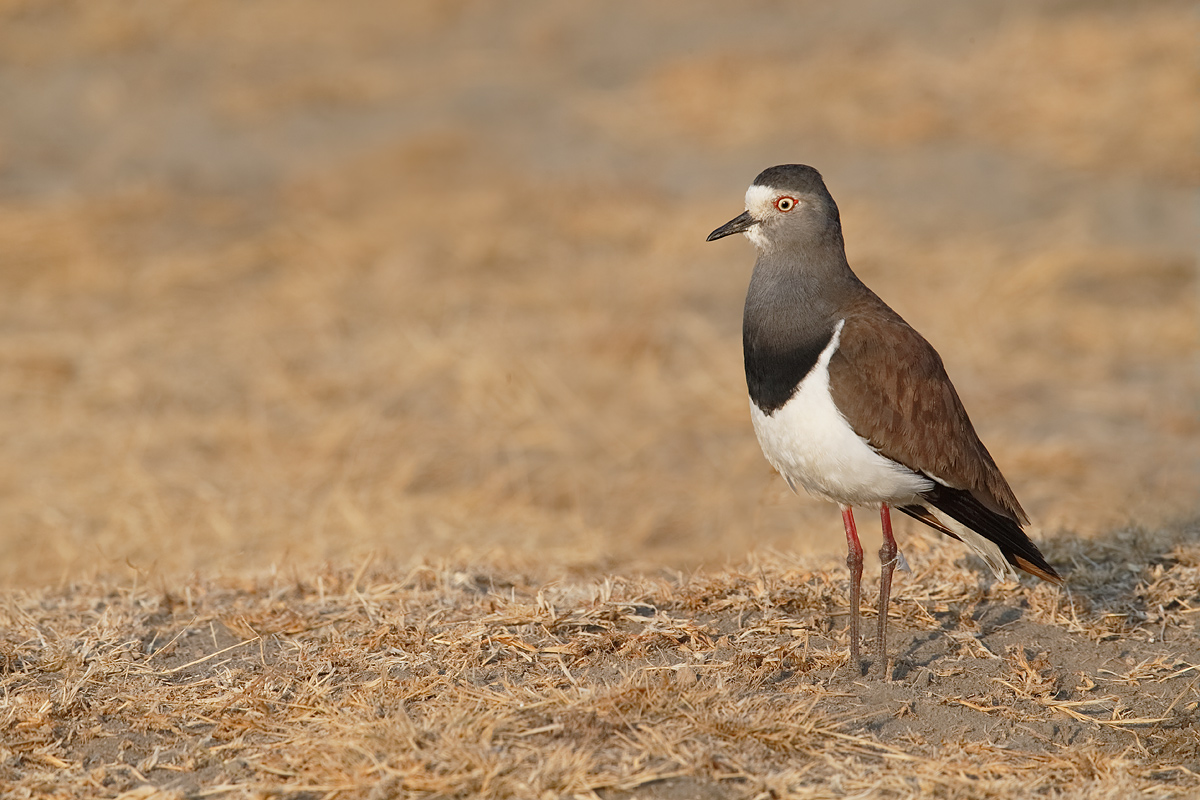
|
|
This, the very same Black-winged Lapwing (formerly Black-winged Plover) image was created with the Todd-Pod mounted Canon EF 600mm f/4L IS II USM lens, the Canon 2x EF Extender III (Teleconverter), and the Canon EOS-1D X. ISO 800. Evaluative metering +2/3 stop as framed: 1/1000 sec. at f/8 in Av mode.
Central sensor (by necessity) Expand/AI Servo Rear Focus AF on the bird’s eye and re-compose. Click on the image to see a larger version.
|
Your Favorite?
Which of the two images above is the stronger? Please let us know why? BTW, did I move to a new spot or was the bird in the same spot for both images. Please let us know what you think and how you can prove it.
Support the BAA Blog. Support the BAA Bulletins: Shop B&H here!
We want and need to keep providing you with the latest free information, photography and Photoshop lessons, and all manner of related information. Show your appreciation by making your purchases immediately after clicking on any of our B&H or Amazon Affiliate links in this blog post. Remember, B&H ain’t just photography!




Amazon
Everyone buys something from Amazon, be it a big lens or deodorant. Support the blog by starting your search by starting your search by clicking on the logo-link below. No purchase is too small to be appreciated; they all add up. Why make it a habit? Because I make it a habit of bringing you new images and information on an almost daily basis.
Typos
In all Bulletins, feel free to e-mail or leave a comment regarding any typos, wrong words, misspellings, omissions, or grammatical errors. Just be right. 🙂
IPT Info
Many of our great trips are filling up. Two great leaders ensure that you will not learn more anywhere about how to make great images. Click here for the schedule and additional info.
October 29th, 2013
First Blood Drawn Despite Bad Left Knee
Little more than a week ago I could not have imagined being able to walk a rock-strewn beach carrying my 600II on the Gitzo 3532 LS tripod. My twice surgically repaired left knee had been bothering me for nearly a month when I jumped out of bed while trying to nap about two weeks ago. I felt nothing. After I got back to sleep and woke, I could barely stand. The knee was swollen and the pain was fairly intense.
After my second arthroscopic surgery in 2006 or 2007, the surgeon said to me, “There is nothing left in the way of cartilage; I’ll see you in a year or two for a new knee.” The left knee had been fine till this most recent episode. Not being a huge fan of major surgery, I called Dr. Cliff Oliver in San Diego for guidance. Here’s what followed: Pete Egoscue Pain Free: A Revolutionary Method for Stopping Chronic Pain positions for knee pain, earth naps, Rock-taping, Active Release Therapy, mechanical thumper treatment, Tate Avacen treatment, rest, and ice baths (whole body in the tub for 35 minutes in 59 degree water). positions for knee pain, earth naps, Rock-taping, Active Release Therapy, mechanical thumper treatment, Tate Avacen treatment, rest, and ice baths (whole body in the tub for 35 minutes in 59 degree water).
While the knee is not yet fully heeled I was able to get around this morning quite comfortably. In short, the whole adventure with the knee has been somewhat miraculous. I just need to be careful and keep from wrecking it. 🙂
CRX-5 Low Foot/Plate
The CRX-5 Low Foot plate is ideal for all three of the Series II super-telephoto lenses. Learn why by clicking here. As it is also hard to keep this item in stock your best course of action is to call Jim at 863-692-0906 and order yours to ensure getting one from our next shipment.
Up Early
After our long flights to Punta Arenas, Chile on Sunday evening red-eyes Denise Ippolito and I were picked up by a Remota Lodge van at about 5pm local time, one hour ahead of Florida and New Jersey. By 7:15pn we were at the lodge and were enjoying a fine fish dinner just before 8:00pm.
I woke early and seeing a calm sunny morning developing we walked down the hill to the water in hopes of photographing some birds. We were greeted by a pair of Black-necked Swans and photographed them for more than an hour.
Continuing On
After a while, we decided to walk north a bit along the beach in search of some different species. Almost immediately I saw another pair of the handsome swans, this pair with four cygnets. We both were squealing with excitement. We stayed with the cygnets for well more than an hour. So much for variety being the spice of life….
Exposure Fine Point
Knowing that the exposure for the adult bird in image #2 was perfect, above, why did I add an additional 1/3 stop of light when photographing the very young swans? (1/400 sec. at f/13 for the cygnets as compared to 1/500 sec. at f/13 for the adults.)
Dealing With the Bright Whites
I should have been at 1/1250 sec. at f/10; I had not noticed that the light had gotten brighter as it got closer to 9:00am. I dealt with the relatively high contrast and the bright whites during the image optimization process. After dealing with the whites while converting the RAW file in DPP (see our DPP RAW Conversion Guide), I employed a variety of other techniques to restore detail in the whites. I used several NIK Color Efex Pro filters including Detail Extractor, Tonal Contrast, and White Neutralizer. I used a reverse S curve in Photoshop to reduce the contrast. And a small Linear Burn painted in with a Hide-All Layer Mask.
All of the above as described in detail in Digital Basics File, an instructional PDF that is sent via e-mail. It includes my complete digital workflow, dozens of great Photoshop tips including Digital Eye Doctor techniques, several different ways of expanding canvas, all of my time-saving Keyboard Shortcuts, Layer Masking and NIK Color Efex Pro basics, dealing with bright highlights, and tons more.
Your Favorite?
Please take a moment to leave a comment and let us know which of the four images is your favorite. And be sure to let us know why.
EOS-1D X Autofocus Guide
Until I get around to doing a complete user’s guide for the 1D X my 1D X Autofocus Guide will help you to master and get the most out of my all time favorite professional digital camera body. It includes my customized Case setting for photographing birds in flight and in action.
5D Mark III User’s Guide
EOS-5D Mark III User’s can learn to set up and use their cameras exactly as I do. Includes detailed advice on all menu and custom function items, AF suggestions, and all you need to know about creating great in-camera HDRs and Multiple Exposures.

|
|
Bosque Sandhill Crane Composite; click on the image to enjoy a larger version.
|
Bosque del Apache 2013 IPT: “The Complete Bosque Experience.” NOV 26-DEC 2, 2013. 7-FULL DAYS: $3399. Co-leader: Denise Ippolito. Introductory Slide program: 6:30 pm on 11/25. Limit: 12/Openings 8.
Please see the info on the short version of this IPT below if you will be spending Thanksgiving with your family.
Tens of thousand of Snow Geese, 10,000 Sandhill Cranes, ducks including point-blank American Wigeon and Wood Duck, amazing sunrises, sunsets, and blast-offs. Live, eat, and breathe photography with one of (if not the) world’s premier photographic educators at one of his very favorite locations on the planet. Top-notch Photoshop instruction. This will make 19 consecutive Novembers at Bosque for me. Nobody knows the place better than I do. Join us to learn to think like a pro, to recognize situations and to anticipate them based on the weather, especially the sky conditions, the light, and the wind direction. Every time we make a move we will let you know why. When you head home applying what you learned will prove to be invaluable. Includes all lunches and the Thanksgiving Buffet at the Crowne Plaza in Albuquerque. I hope that you can join me for what will be an unparalleled learning experience.
There is never a strict itinerary on a Bosque IPT as each day is tailored to the local conditions at the time and the weather. We are totally flexible in order to maximize both the photographic and learning opportunities. There is an introductory slide program on the night before the tour begins. We are up early each day leaving the hotel by 5:30 am to be in position for sunrise. After 18 years we pretty much know where to be when in what sky conditions and what winds. We usually photograph until about 10:30am. Then it is back to Socorro for lunch and then a classroom session with the group most days. We head back to the refuge at about 3:30pm each day and photograph until sunset. Then dinner with the group most nights. We always spend at least one afternoon at the ponds at the Albuquerque Zoo doing Wood Ducks and usually two mornings at New Mexico Tech doing American Wigeons. The rest is Snow Geese and Sandhill Cranes with the emphasis on expanding both your technical skills and your creativity.
A $500 non-refundable deposit is required to hold your slot for this IPT. Your balance, payable only by check, is due now. You will receive an e-mail notifying you of that after you place your deposit. If the trip fills, we will be glad to apply a credit applicable to a future IPT for the full amount less a $100 processing fee. If we do not receive your check for the balance on or before the due date we will try to fill your spot from the waiting list. If your spot is filled, you will lose your deposit. If not, you can secure your spot by paying your balance.
Please print, complete, and sign the form that is linked to here and shoot it to us along with your deposit check (made out to “Arthur Morris.”) You can also leave your deposit with a credit card by calling the office at 863-692-0906. If you register by phone, please print, complete and sign the form as noted above and either mail it to us or e-mail the scan. If you have any questions, please feel free to contact me via e-mail.

|
|
Bosque Snow Goose Composite; click on the image to enjoy a larger version.
|
Bosque del Apache 2013 IPT: “The Short Version.” NOV 30-DEC 2, 2013. 3-FULL DAYS: $1199. Co-leader: Denise Ippolito. Introductory Slide program: 7:30 pm on 11/29. Limit: 12/Openings 4.
Tens of thousand of Snow Geese, 10,000 Sandhill Cranes, amazing sunrises, sunsets, and blast-offs. Top-notch Photoshop instruction. This will make 19 consecutive Novembers at Bosque for artie. Nobody knows the place better than he does. Join us to learn to think like a pro, to recognize situations and to anticipate them based on the weather, especially the sky conditions, the light, and the wind direction. Every time we make a move we will let you know why. When you head home applying what you learned will prove to be invaluable. Includes all lunches. I hope that you can join us for these three great days; they will offer a great learning experience.
There is never a strict itinerary on a Bosque IPT as each day is tailored to the local conditions at the time and the weather. We are totally flexible in order to maximize both the photographic and learning opportunities. There is an introductory slide program on the night before the tour begins. We are up early each day leaving the hotel by 5:30 am to be in position for sunrise. After 18 years we pretty much know where to be when in what sky conditions and what winds. We usually photograph until about 10:30am. Then it is back to Socorro for lunch and then an informal Photoshop/image review session with the group most days. We head back to the refuge at about 3:30pm each day and photograph until sunset. We may spend an afternoon at the ponds at the Albuquerque Zoo doing Wood Ducks and we may spend a late morning at New Mexico Tech doing American Wigeons. The rest is Snow Geese and Sandhill Cranes with the emphasis on expanding both your technical skills and your creativity.
A $500 non-refundable deposit is required to hold your slot for this IPT. Your balance, payable only by check, is due now. You will receive an e-mail notifying you of that after you place your deposit. If the trip fills, we will be glad to apply a credit applicable to a future IPT for the full amount less a $100 processing fee. If we do not receive your check for the balance on or before the due date we will try to fill your spot from the waiting list. If your spot is filled, you will lose your deposit. If not, you can secure your spot by paying your balance.
Please print, complete, and sign the form that is linked to here and shoot it to us along with your deposit check (made out to “Arthur Morris.”) You can also leave your deposit with a credit card by calling the office at 863-692-0906. If you register by phone, please print, complete and sign the form as noted above and either mail it to us or e-mail the scan. If you have any questions, please feel free to contact me via e-mail.
BIRDS AS ART 2nd International Bird Photography Competition
Learn more and enter the BIRDS AS ART 2nd International Bird Photography Competition here. Twenty-five great prizes including the $1000 Grand Prize and intense competition. Bring your best.
2014 Tanzania Summer Safari
If you are interested in joining us in Tanzania next summer please shoot me an e-mail and I will be glad to forward you the PDF with dates, itinerary, and price.
Support the BAA Blog. Support the BAA Bulletins: Shop B&H here!
We want and need to keep providing you with the latest free information, photography and Photoshop lessons, and all manner of related information. Show your appreciation by making your purchases immediately after clicking on any of our B&H or Amazon Affiliate links in this blog post. Remember, B&H ain’t just photography!




Amazon
Everyone buys something from Amazon, be it a big lens or deodorant. Support the blog by starting your search by starting your search by clicking on the logo-link below. No purchase is too small to be appreciated; they all add up. Why make it a habit? Because I make it a habit of bringing you new images and information on an almost daily basis.
Typos
In all Bulletins, feel free to e-mail or leave a comment regarding any typos, wrong words, misspellings, omissions, or grammatical errors. Just be right. 🙂
IPT Info
Many of our great trips are filling up. Two great leaders ensure that you will not learn more anywhere about how to make great images. Click here for the schedule and additional info.
October 27th, 2013 Bosque IPTs/Late Registration Discounts Increased!
For information on both the 7-Day and the recently announced short version of the 2013 Bosque IPTs please scroll down here. If you would like to join us for the first 3 or 4 days of this IPT please shoot me an e-mail. Please call Jim at 863-692-0906 or e-mail for late registration discount info.
A Fairly Easy Gear Decision
I am headed to MCO, Orlando International Airport, to begin the long journey to Punta Arenas, Chile that will bring me to Torres del Paine National Park. I am typing in the back of a Mercury Grand Marquis, headed for the airport via the Lake Wales Car Service, a 1-vehicle operation. My Think Tank Airport Security™ V 2.0 Rolling Camera Bag is safely in the trunk, weighing 42 pounds right on the button.
Think Tank Bags
Interested in a Think Tank rolling bag or backpack? Use the logo-link on the right side of the blog and earn a free prize with your order.
Here is what’s in the bag: the Canon EF 600mm f/4L IS II USM lens, the Canon EF 300mm f/2.8L IS II USM lens, the Canon EF 70-200mm f/2.8L IS II USM lens, the Canon EF 100mm f/2.8L Macro IS USM lens–it is springtime in southern Chile, the Canon EF 16-35mm f/2.8L II USM Autofocus Lens two Canon 1.4x EF Extender III (Teleconverters), two Canon 2x EF Extender III (Teleconverters), , one Canon Extension Tube EF 12 II, one Canon Extension Tube EF 25 II, one Canon EOS-1D X, and one Canon EOS 5D Mark III.
As always the hoods for all of the lenses are in one of my checked bags. The Canon 24-105mm f/4L IS EF USM AF lens is in my hard-sided checked bag. Good luck with that….
So What’s Missing?
So what’s missing? It would be great to be bringing the Canon EF 200-400mm f/4L IS USM lens with Internal 1.4x Extender along, but as noted previously, traveling with both the 600II and the 200-400 is a bear. Choosing the 300 II saves me nearly 3 pounds and gives me an easily hand holdable flight lens should we have some good chances with condors. And while the 200-400 would be great for landscapes, I can use the 300 alone or with either TC to fill in the gaps.
Traveling with only two camera bodies is new for me; I almost always have both of my 1D X bodies and the 5D Mark III with me when I get on a plane. I will be very careful with my gear. For bird ((and if we are really lucky, for puma) photography, I will be relying on the 600II and both the 1.4X and 2x III TCs. My Gitzo 3532LS CF tripod is also in my hard-sided checked bag along with my Mongoose M3.6 tripod head. We have trouble keeping the Mongoose heads in stock; it would be best to call Jim at 863-692-0906 (weekdays only) and order the item to ensure getting one from our next batch that is expected soon.
Questions?
All travel-related questions are welcome.

|
|
Bosque Sandhill Crane Composite; click on the image to enjoy a larger version.
|
Bosque del Apache 2013 IPT: “The Complete Bosque Experience.” NOV 26-DEC 2, 2013. 7-FULL DAYS: $3399. Co-leader: Denise Ippolito. Introductory Slide program: 6:30 pm on 11/25. Limit: 12/Openings 8.
Please see the info on the short version of this IPT below if you will be spending Thanksgiving with your family.
Tens of thousand of Snow Geese, 10,000 Sandhill Cranes, ducks including point-blank American Wigeon and Wood Duck, amazing sunrises, sunsets, and blast-offs. Live, eat, and breathe photography with one of (if not the) world’s premier photographic educators at one of his very favorite locations on the planet. Top-notch Photoshop instruction. This will make 19 consecutive Novembers at Bosque for me. Nobody knows the place better than I do. Join us to learn to think like a pro, to recognize situations and to anticipate them based on the weather, especially the sky conditions, the light, and the wind direction. Every time we make a move we will let you know why. When you head home applying what you learned will prove to be invaluable. Includes all lunches and the Thanksgiving Buffet at the Crowne Plaza in Albuquerque. I hope that you can join me for what will be an unparalleled learning experience.
There is never a strict itinerary on a Bosque IPT as each day is tailored to the local conditions at the time and the weather. We are totally flexible in order to maximize both the photographic and learning opportunities. There is an introductory slide program on the night before the tour begins. We are up early each day leaving the hotel by 5:30 am to be in position for sunrise. After 18 years we pretty much know where to be when in what sky conditions and what winds. We usually photograph until about 10:30am. Then it is back to Socorro for lunch and then a classroom session with the group most days. We head back to the refuge at about 3:30pm each day and photograph until sunset. Then dinner with the group most nights. We always spend at least one afternoon at the ponds at the Albuquerque Zoo doing Wood Ducks and usually two mornings at New Mexico Tech doing American Wigeons. The rest is Snow Geese and Sandhill Cranes with the emphasis on expanding both your technical skills and your creativity.
A $500 non-refundable deposit is required to hold your slot for this IPT. Your balance, payable only by check, is due now. You will receive an e-mail notifying you of that after you place your deposit. If the trip fills, we will be glad to apply a credit applicable to a future IPT for the full amount less a $100 processing fee. If we do not receive your check for the balance on or before the due date we will try to fill your spot from the waiting list. If your spot is filled, you will lose your deposit. If not, you can secure your spot by paying your balance.
Please print, complete, and sign the form that is linked to here and shoot it to us along with your deposit check (made out to “Arthur Morris.”) You can also leave your deposit with a credit card by calling the office at 863-692-0906. If you register by phone, please print, complete and sign the form as noted above and either mail it to us or e-mail the scan. If you have any questions, please feel free to contact me via e-mail.

|
|
Bosque Snow Goose Composite; click on the image to enjoy a larger version.
|
Bosque del Apache 2013 IPT: “The Short Version.” NOV 30-DEC 2, 2013. 3-FULL DAYS: $1199. Co-leader: Denise Ippolito. Introductory Slide program: 7:30 pm on 11/29. Limit: 12/Openings 4.
Tens of thousand of Snow Geese, 10,000 Sandhill Cranes, amazing sunrises, sunsets, and blast-offs. Top-notch Photoshop instruction. This will make 19 consecutive Novembers at Bosque for artie. Nobody knows the place better than he does. Join us to learn to think like a pro, to recognize situations and to anticipate them based on the weather, especially the sky conditions, the light, and the wind direction. Every time we make a move we will let you know why. When you head home applying what you learned will prove to be invaluable. Includes all lunches. I hope that you can join us for these three great days; they will offer a great learning experience.
There is never a strict itinerary on a Bosque IPT as each day is tailored to the local conditions at the time and the weather. We are totally flexible in order to maximize both the photographic and learning opportunities. There is an introductory slide program on the night before the tour begins. We are up early each day leaving the hotel by 5:30 am to be in position for sunrise. After 18 years we pretty much know where to be when in what sky conditions and what winds. We usually photograph until about 10:30am. Then it is back to Socorro for lunch and then an informal Photoshop/image review session with the group most days. We head back to the refuge at about 3:30pm each day and photograph until sunset. We may spend an afternoon at the ponds at the Albuquerque Zoo doing Wood Ducks and we may spend a late morning at New Mexico Tech doing American Wigeons. The rest is Snow Geese and Sandhill Cranes with the emphasis on expanding both your technical skills and your creativity.
A $500 non-refundable deposit is required to hold your slot for this IPT. Your balance, payable only by check, is due now. You will receive an e-mail notifying you of that after you place your deposit. If the trip fills, we will be glad to apply a credit applicable to a future IPT for the full amount less a $100 processing fee. If we do not receive your check for the balance on or before the due date we will try to fill your spot from the waiting list. If your spot is filled, you will lose your deposit. If not, you can secure your spot by paying your balance.
Please print, complete, and sign the form that is linked to here and shoot it to us along with your deposit check (made out to “Arthur Morris.”) You can also leave your deposit with a credit card by calling the office at 863-692-0906. If you register by phone, please print, complete and sign the form as noted above and either mail it to us or e-mail the scan. If you have any questions, please feel free to contact me via e-mail.
BIRDS AS ART 2nd International Bird Photography Competition
Learn more and enter the BIRDS AS ART 2nd International Bird Photography Competition here. Twenty-five great prizes including the $1000 Grand Prize and intense competition. Bring your best.
2014 Tanzania Summer Safari
If you are interested in joining us in Tanzania next summer please shoot me an e-mail and I will be glad to forward you the PDF with dates, itinerary, and price.
Support the BAA Blog. Support the BAA Bulletins: Shop B&H here!
We want and need to keep providing you with the latest free information, photography and Photoshop lessons, and all manner of related information. Show your appreciation by making your purchases immediately after clicking on any of our B&H or Amazon Affiliate links in this blog post. Remember, B&H ain’t just photography!




Amazon
Everyone buys something from Amazon, be it a big lens or deodorant. Support the blog by starting your search by starting your search by clicking on the logo-link below. No purchase is too small to be appreciated; they all add up. Why make it a habit? Because I make it a habit of bringing you new images and information on an almost daily basis.
Typos
In all Bulletins, feel free to e-mail or leave a comment regarding any typos, wrong words, misspellings, omissions, or grammatical errors. Just be right. 🙂
IPT Info
Many of our great trips are filling up. Two great leaders ensure that you will not learn more anywhere about how to make great images. Click here for the schedule and additional info.
|
|

